This site is not, nor does it have links to, the official website of the Royal Palaces or Palace House and the National Horse Racing Museum, providing instead an academic study of the history of the 3 Newmarket Palaces.
Every effort has been made to contact copyright holders of material reproduced in this article, and if someone believes that they are the rightful owner where acknowledgement has not been stated, I would be pleased to rectify the omission.
(© John W Slusar 2022)
‘Once upon a time in the poor little village of Newmarket’ seems an appropriate opening to the tale of happenings in the town between 1605 and 1819. Before 1605 the town could barely boast a population of 500 and was not only part of two counties, Suffolk and Cambridgeshire, but also part of 2 Parishes, that of Exning to the north and Woodditton to the south, hence the reason why it has 2 churches so close together. The lord of the Manor on the Exning side of Newmarket built a Chapel of Ease on the site where St Mary’s Church now stands in around 1280, while slightly later the Lord of the Manor of Ditton Valens, on the Woodditton side of Newmarket, a Chapel of Ease was built on the site of the present day All Saints Church. Leading up to 1605 the town had only ever enjoyed one Royal visitor, and that was in 1453 when the wife of King Henry VI, Queen Margaret of Anjou, stayed in the town, although the reason for her visit is unknown, unless she was just breaking her journey between London and Norwich. Whilst in Newmarket a fire occurred in a stable at The Christopher public house on the St Mary's side of the High Street, (located where the present day Greggs and Jennings Bookmakers are built), next to the Bull Inn, which in the early days was known as the Black Bull. At the time of the stable fire The Christopher was leased by John Wright from Richard Salisbury, and Queen Margaret appreciated how devastating the fire would have been to Salisbury and Wright, potentially taking away Wright's livelihood, so she awarded Wright £6 6s 8d and Salisbury £10 to get them through the difficulties which they faced. After 1819 the Royals had no further need for its Royal Palace, as excursions to the races were significantly curtailed, and the Palace was lent as a grace and favour property to various Dukes before being sold to the Rothschilds in 1859, the Palace Stables having been sold to Rothschild in 1855. However, it is the intervening two centuries, between 1605 and 1819, which make the Newmarket fairytale one which even Hans Christian Andersen would have been proud of. Would he have incorporated into his tale so many Kings, fewer Queens, so many Princes, not as many Princesses, but suitable replacements, like Nell Gwynn, who was much better equipped and more worldly wise in the art of seduction and bringing it to a successful conclusion than any princess? In actual factor Nell Gwynn, despite having a house, which still exists today, on the opposite side of the road to the Palace, seldom visited Newmarket except when King Charles II was present, but she did see the King in London where she worked on the stage, calling him Charles III, as she had already had two other lovers named Charles, firstly Charles, Earl of Dorset, and then actor Charles Hart. Whether the title of this article is interpreted as’ Newmarket Royal Palaces are now confined to history’ or as, ‘Newmarket Royal Palaces are an integral part of the country’s history at a particularly turbulent time’ is up for the reader to decide.
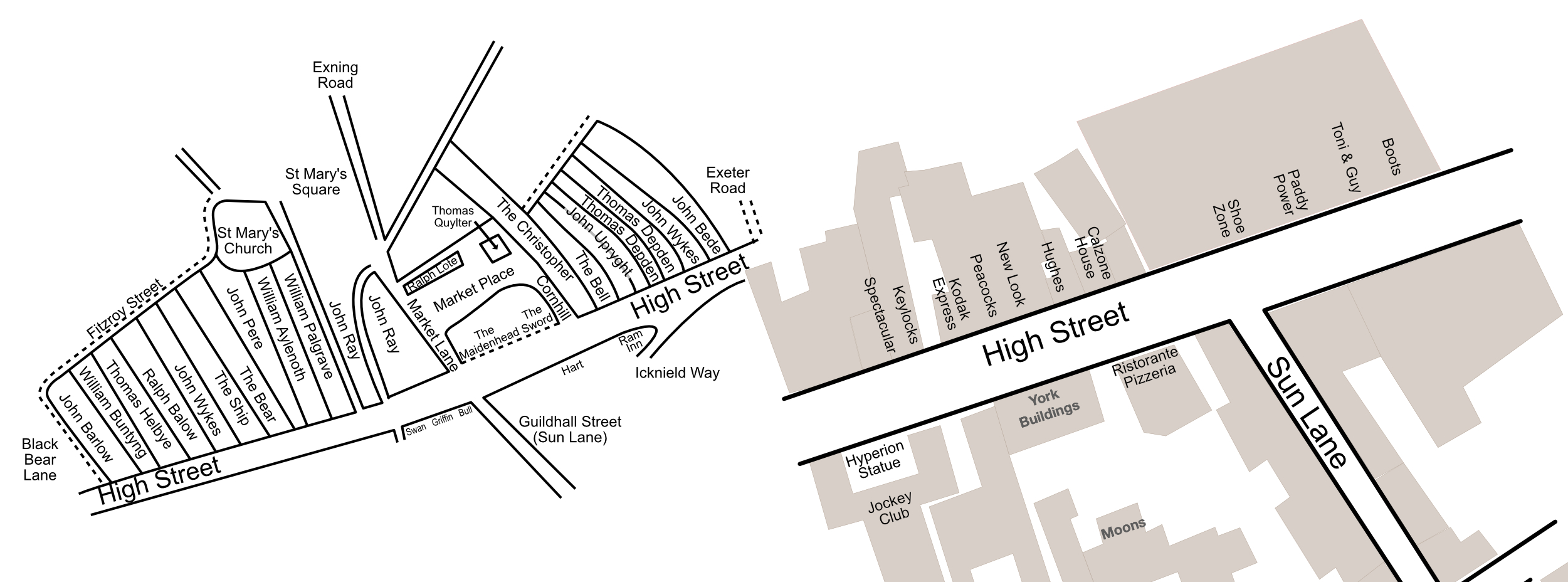
In 1472 the majority of residents in Newmarket lived on the north side of the High Street in the Exning Parish, in the vicinity of St Marys Church. However, on the south side, in the Woodditton Parish, closer to All Saints Church, there was a reduced number of residences, although the Ram Inn, later to become the Rutland Arms, and the Griffin Inn, probably in existence since the early years of the 15th century, were on the south side. The Griffin Inn was run by William Baron (1439) in the 15th century, followed by Arthur Greysson who died in 1479, and then Leonard and Margaret Beale in the mid-16th century. In early February 1604 the King left Hampton Court, having completed his public business, and proceeded to the neighbourhood of Royston and Newmarket to enjoy his favourite recreation of field sports. However, at this stage there is no evidence he went into the town of Newmarket, and certainly did not stay there. Leonard Beale leased the Griffin Inn to Richard Hamerton, but still retained ownership in the days when King James I visited Newmarket for the first time on Tuesday 26th February 1605. It is uncertain where, or if, he stayed in Newmarket on that inaugural visit, although he knighted 2 gentlemen, Sir Rice Griffin (Warwickshire) and Sir Robert Crane (Suffolk) on the first day, then knighted 4 more the next day, Sir Francis Fulford (Devonshire), Sir Thomas Huggon (Norfolk), Sir Thomas Fleming (Hampshire), Sir Henry Colt (Suffolk), so would have resided somewhere nearby overnight, before his Royal party enjoyed the pleasures of the chase on 27th February. In total James I made 99 knights at Newmarket during his reign. In 1605 Edward Somerset, 4th Earl of Worcester, was 'Master of the Horse', holding the post from 1st January 1601 to 1st January 1616, having succeeded the Earl of Essex, and was then replaced by Sir George Villiers, later made the Duke of Buckingham in 1623.
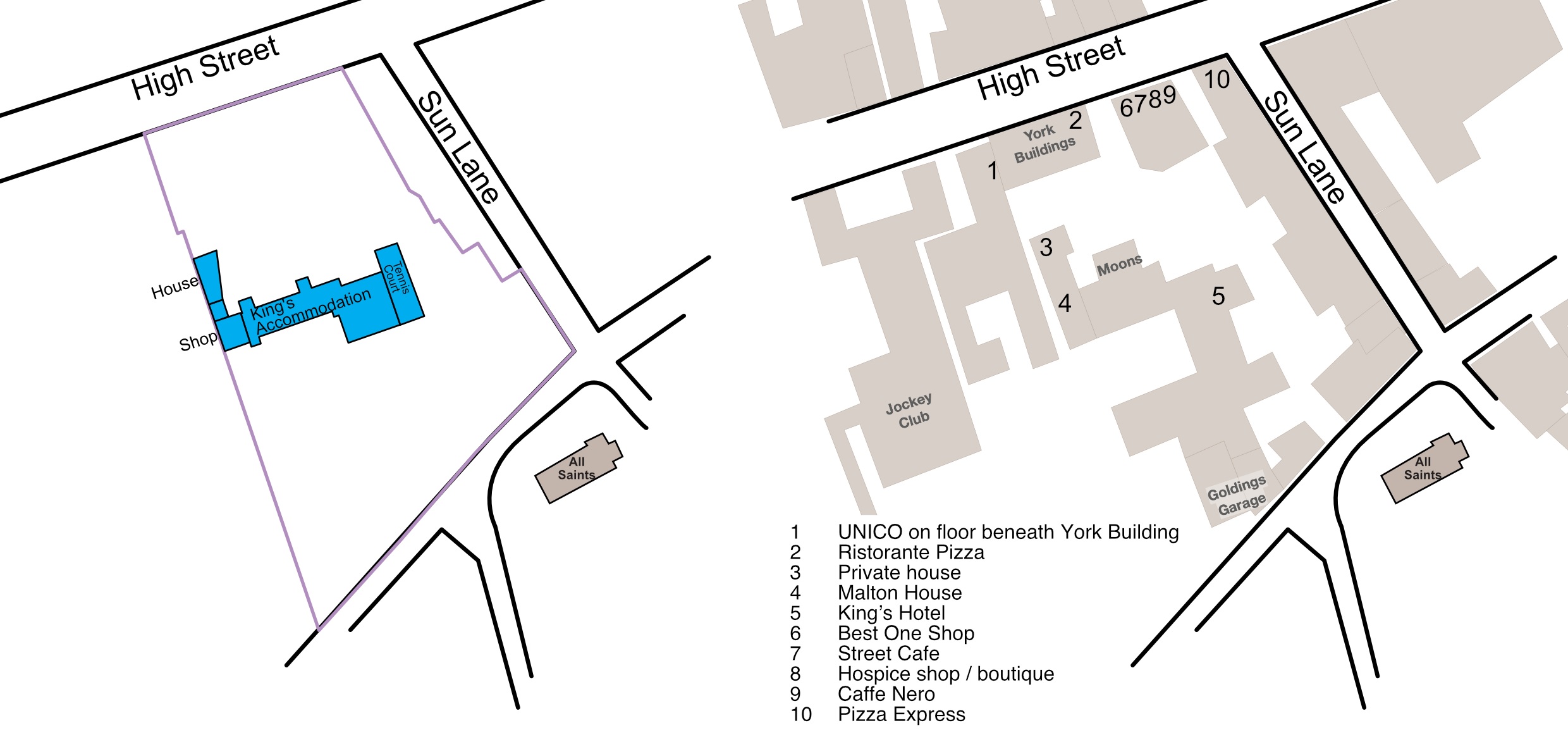
Even as early as 1605 James I had a desire to make Newmarket a regular place to visit, appointing John Bancks (sic) as keeper of Wilbrahm (sic) Bushes, the New Warren and King's hare park. He enjoyed hunting and Newmarket could be viewed as part of a hunting circuit, along with Thetford, Theobalds (Hertfordshire) and Royston which the King would travel around. It was over 2 years before he returned to Newmarket on 16th April 1607, having travelled there from Royston where he had knighted Sir Thomas Tyrrell. During his brief stay in Newmarket he knighted Sir Edward and Sir John Vere, returning to Royston that same evening. King James I prorogued Parliament on 24th November 1607 until 10th February 1608, and left London to return to Newmarket, arriving on 16th November 1607, hoping to spend Christmas there, leasing the Griffin Inn from Leonard Beale and his wife Margaret for £10 per annum, payable half-yearly on the Feast of the Annunciation of the Blessed Virgin Mary on 25th March, and the Feast of St Michael the Archangel on 29th September, before purchasing it for a fee-simple ‘a sum not exceeding £400’ on 28th July 1608. Richard Hamerton was appointed 'Keeper of the King's House' in Newmarket during this period and, on 11th February 1608 was granted £500 to hold the post for the remainder of the lease, with additional sums of £60 granted to Richard Hamerton on 12th February for the King’s charges at Newmarket, and again on 20th April 1608. The fee-simple was not paid until 1610, completing the sale from Leonard and Margaret Beale to King James I. Adjacent to the Griffin Inn was a house which was acquired by the King from Robert Cecil, 1st Earl of Salisbury, and the King demolished the Griffin Inn and the newly acquired House and had a splendid new residence built which became Palace I in Newmarket where he was able to welcome Ambassadors and Noblemen. His parties enjoyed deer hunts (March 1608 with Sir Thomas Lake), and plays performed by actors from Cambridge, hunting expeditions and hare-hunting. Avoiding the plague which was rife in London in 1608, James I spent a prolonged period at his Newmarket residence from 14th October 1608, accompanied by Sir Thomas Lake. Pleasing news from Venice on 14th October enabled the King to relax and enjoy his writing, while a week later, on 21st October, he was in a very good mood with his Court, and they, in turn, had left him ‘quietly to his sports.’
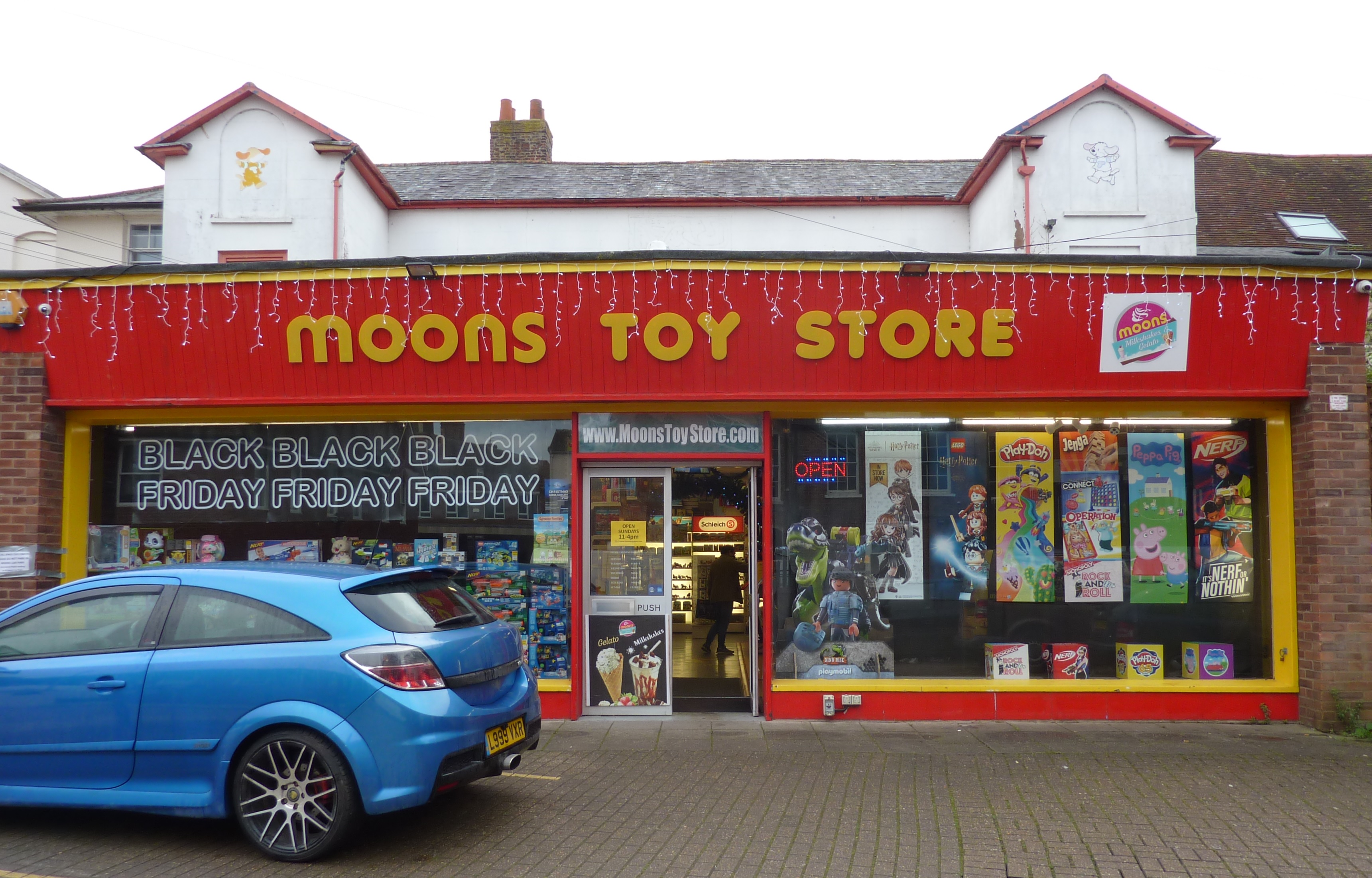
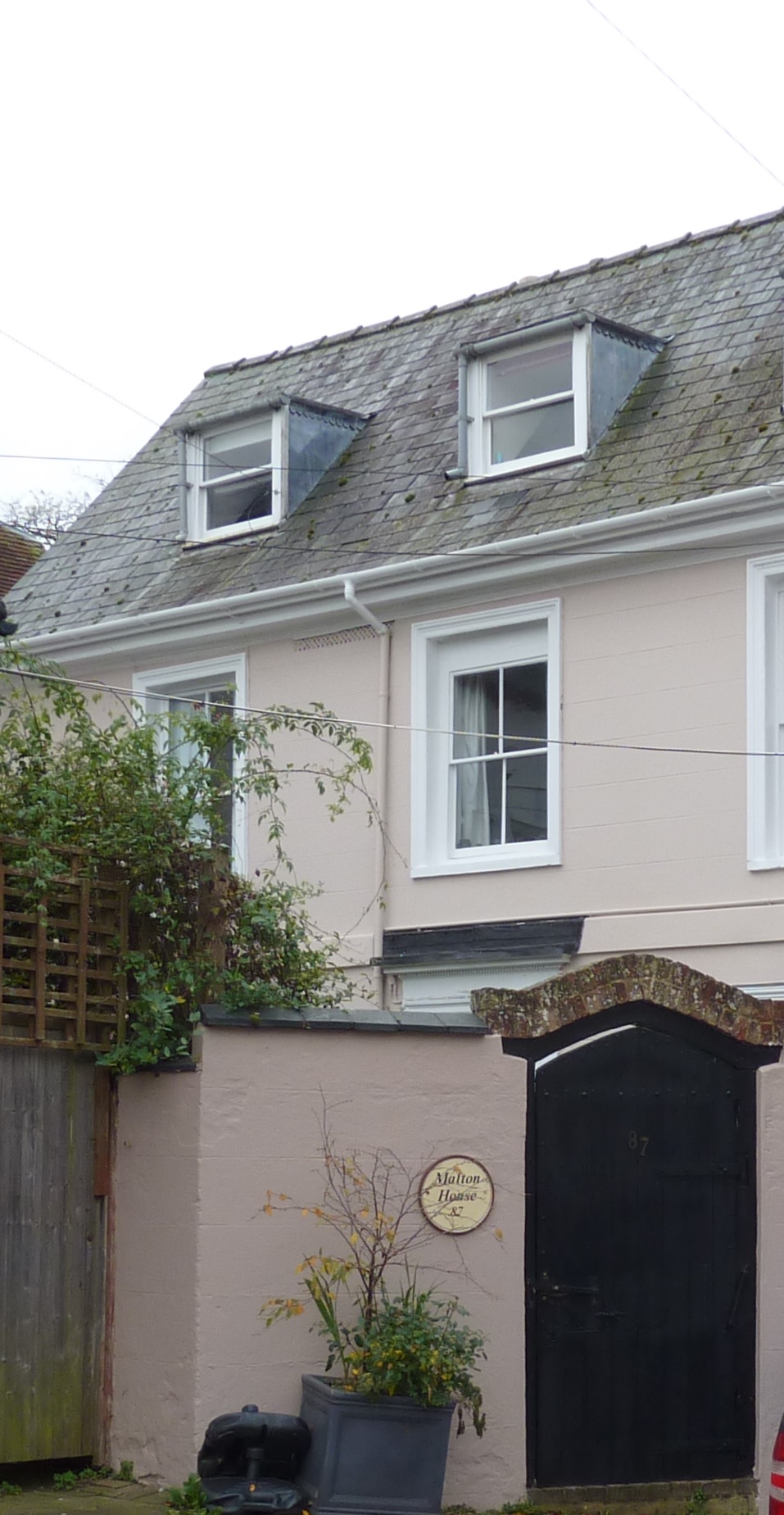
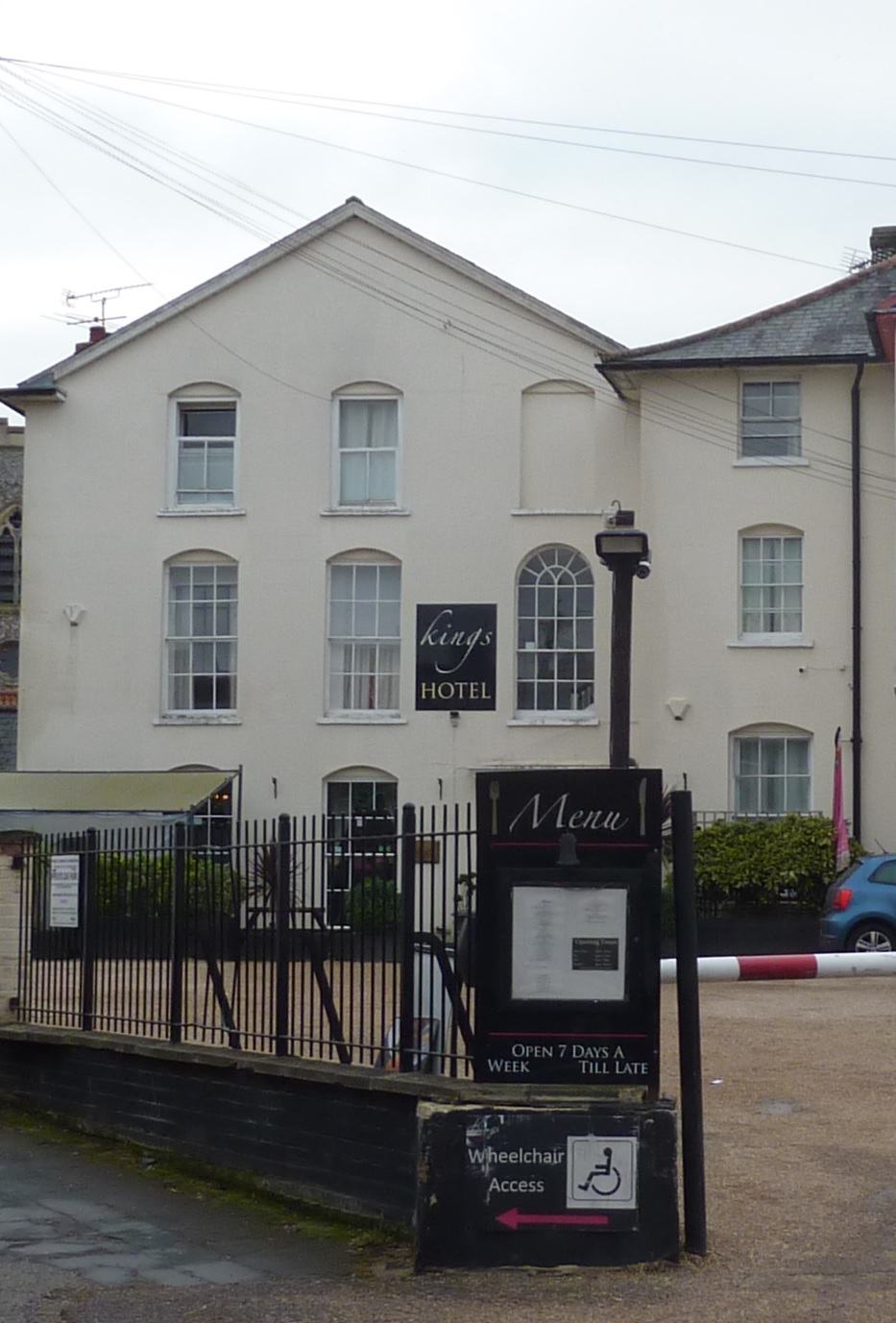
A glance at his 1609 accounts reveals that the building of the Royal Palace was proving a costly business, with a total of £457 6s 4 ½ d spent on wages and materials. Workmen's wages per day were:- Masons 18d, Carpenters 10d-18d, Bricklayers 14d-17d, Plasterers 14d-22d, Joiners 18d, Plumbers 18d, Labourers 9d-12d, Sawyers 2s 6d per couple. Richard Griffin had the task of sourcing and laying 303 1/2 sq yards of bulrush mats for the King's new privy lodgings and the Noblemen's lodgings. On 10th December 1609 the King was troubled by an interesting problem, because the Universities of Cambridge and Oxford showed an unwillingness to admit Scotsmen, so he summoned a meeting with the two Chancellors, the Archbishop of Canterbury and the Earl of Salisbury, Robert Cecil (Lord High Treasurer) to discuss ‘revocation of hostile statutes against the Scots’, although it is uncertain what the outcome of the meeting was.
Palace I expenses 1609-1610
It is not certain how quickly the Griffin Inn, and the adjacent house acquired from Robert Cecil, 1st Earl of Salisbury, were demolished, and whether these were referred to as the ‘old buildings’ while Palace I was being built. It is likely that the Griffin Inn was demolished prior to work beginning, although Robert Cecil’s House might have been kept, for it was not until 1619 that Inigo Jones designs the Prince’s Lodgings on the site of Cecil’s former house.
The total expenditure between 1609 and 1610 was £457 6s 4 ½ d (equivalent to £133,000 in 2021)
Masons set and fit 4 chimney pots in the King’s private lodgings at a cost of 16s each.
Laying the borders of the King’s private lodgings at 8d a foot.
Carpenters fit and set planks of wood for the dressers in the privy Kitchen and Larder at 8d a foot.
Setting up a pair of stairs in the privy Chamber.
Boarding a divide between the Larder and the room where provisions are laid.
Fastening of quarters to the walls for hangings in the new privy lodgings.
Making 3 oak doors; one between the Chamber and Prince’s Lodgings; one between Lord Fenton’s chamber and his Dining Room; the third for the Prince’s wardrobe.
Making trestle tables and cupboards in sundry rooms.
Paving brickwork and the gutters between the King’s house, the joining house and the Bottlehouse next door to that.
Paving, with paving tiles, the Scullery, Hall and at the foot of both stairs.
Mending the hearths and furnaces.
Plastering, lathing and laying plaster of Paris and lime on the outside walls, the inside walls, ceilings, partitions in the new lodgings, the Storehouse, Pantry, Buttery, Wine cellar and groom’s lodgings in the privy chamber.
Thatching with straw the backside of the old house, stairs at the end of the lodgings, privy Kitchen and Scullery.
Plumbers laying sheets of Cornish lead on the front of the new lodgings; use of a plane to fit quartz for footplates.
Richard Griffin was employed to lay 303 1/2 sq yards of bulrush mats at 8d a sq yard in the King’s new privy lodgings and the noblemen’s lodgings to the left of the King’s lodgings.
In May 1610 the King welcomed Louis Frederick, Prince of Wirtenberg, to his Newmarket Palace, and the party enjoyed hare-hunting, although it is evident that very little racing took place during the reign of James I as his primary interest was in hunting. He did return to Newmarket in late November and early December, but once again no mention is made of racing.
The King stayed at his Newmarket Palace in February 1611 along with his eldest son, Henry Frederick, the Prince of Wales, who was 17 years old. He paid two Frenchmen £80 to teach the Prince the arts of dancing and fencing, but unfortunately, the Prince died of typhoid fever a year later, in November 1612, aged just 18 and was succeeded by his younger brother Charles, later to become King Charles I. On 20th October 1611 the King, residing at the time at Theobalds Palace, which he had acquired in 1607 in exchange for Hatfield Palace, went hunting in Newmarket while the Queen practised for a new Masque (a combination of Opera, Theatre, Ballet and Ball particularly enjoyed in the 16th and 17th century, with sets designed by Inigo Jones in his early career). He was joined on the hunting field, and later at Theobalds, by the Ambassador of Savoy, a country on the edge of Lake Geneva between Switzerland and France, and the Ambassador had made the mistake of bringing the King a pet leopard as a present. The mistake was soon realised when the animal was let loose on the estate and seized a white roe-deer calf, an unpardonable crime at that time, so it created a delicate situation. It is interesting to observe that the King chose to reside at Theobalds even though he could have stayed at Palace I which, at the time, was considerably less splendid than Theobalds.
Palace I expenses 1611-1612
The total expenditure between 1611 and 1612 was £59 4s 4d, with Thomas Pointer acting as Clerk of the Works for 40 days at 4s per day. John Pigott was paid £4 for framing, raising and boarding a floor in the privy Buttery, which was 16 feet long and 15 feet wide, close to where Mr Bohennon (Buttery keeper) lodged.
New pair of stairs leading up to the Buttery, which had a new roof and dormer window fitted.
Taking down the old partition wall between the privy Buttery and the Pantry, and laying fittings in the enlarged room, also altering a smoky chimney and using lime and hair on the walls and ceiling.
The Presence Chamber had 22 lights and double encasements fitted, costing 27s 1d, with 89 sq yards of bulrush mats costing 49s 6d.
Palace I expenses 1612-1613
The accounts indicated that £162 2s 8d was spent on materials and labour at the Palace.
The Keeper of the Clay-pit was paid 2d a load for 21 loads of clay.
Taking down 2 partitions between the Prince’s bedchamber and the Presence Chamber.
Mending ranges in the Kitchen.
Tiling the King’s Presence Chamber.
Covering vaults, boarding up partitions, creating shelves.
Screwing and strengthening floors that were sinking (was this the first time concerns were raised about the foundations of the Palace I which later had devastating consequences in March 1613?).
Carpeting with bulrush matting Lord Montgomery’s lodgings to bring them up to the same standard as the King’s and Prince Henry’s.
In March 1612 King James made Sir Henry Vane a Knight at his Newmarket Palace, while later in the same year Sir Robert Vernon was appointed 'Keeper of the King's Newmarket Palace', after the retirement of Richard Hamerton, the previous Keeper, who had himself at one time leased the Griffin Inn on whose site Palace I was built. Richard Hamerton spent his retirement living in a dwelling at the rear of the Greyhound public house which was located on the opposite side of Sun Lane to Palaces I and II, and died in 1630. In the latter part of the 15th century it is believed that the Greyhound was owned by Ralph Cooke who sold it to Richard Pickes. When Richard died the deeds passed to his son John Pickes, and he died in 1618 his wife Elizabeth inherited it. At the south of the Greyhound, on land owned by King JamesI, and part of his King's Closes, James built his Brewhouse and sundry buildings, one of which Hamerton lived in. In October and November 1612 Prince Henry Frederick became seriously ill, although he was not in Newmarket for the major period of his illness. In early October he became pale and thin, complaining of headaches and enquiring of his Physician, Dr Hammond, of the cause of his illness, a feeling of laziness and general indisposition. Prior to his illness he had always risen early and enjoyed his morning exercise, but once the illness became embedded, he seldom rose before 9 o’clock and frequently asked his grooms how he looked, wanting a reassurance which was not forthcoming. The Prince’s favourite pastimes were fishing for pike and Real Tennis and, extraordinarily, as his unknown illness began to take hold he played Real Tennis on the Palaces court on Saturday 24th October 1612, but he was so tired afterwards that he almost missed the Sunday sermon the next day. His cold, his drowsiness and general feeling of being unwell became more pronounced and he died on 6th November 1612 in the presence of the Archbishop of Canterbury. Although the Physicians did not know it at the time, he died of typhoid fever. The Palace continued to prove expensive to run, for between 1612 and part way through 1613, £59 4s 4d was spent on the Palace in 1612, although the King was increasingly enjoying residing in Newmarket, arriving for a prolonged visit on 13th January 1613, hoping to remain there until Candlemas. He complained of a great pain in his big toe during this visit, but his doctors were compelled to not call it gout at this stage despite him drinking heavily, compounding the illness. The end of his visit was marked by a grand feast organised by the Lord Archbishop, bringing to a conclusion a break during which he had knighted 8 people in Newmarket, namely Sir Humphrey May (Sussex), Sir Edward Ayscough, Sir Francis Leigh (Warwickshire), Sir Joseph Killegrew, Sir Robert Wingfield, Sir Edward Underhill (Warwickshire), Sir Edmond Wyld and Sir Nevill Pool. He then departed Newmarket, returning to Whitehall on 2nd February 1613. On 25th February 1613 the King arrived at Theobalds Palace for a lengthy stay, hoping to go on to Newmarket by 22nd March, although in the end they resided at Palace I from early March, because on 6th March they left Newmarket for Cambridge to enjoy two lectures and 2 comedies. It seems unlikely that they did enjoy the day because, after 7 hours of entertainment, with the comedies still in progress, the King and his party decided to return to Newmarket. Throughout 1613 an additional £162 2s 8d was expended on Palace I, but all to no avail, for in March 1613, with the King still in residence, the foundation of the house where he lay began to sink on one side so that the doors and windows flew open and his servants had to carry James out of his bed as quickly as possible. The next day the King moved to Thetford. At the time of the devastating collapse of Palace I the Royal Architect was Inigo Jones, and he was given the task of designing and overseeing the building of Palace II, but it is not surprising that only £46 9s 11d was spent in 1613-14, as the King, Court and Architect discussed the best way forward, the main expense fell the next year when £4660 11s 9 1/2 d was spent on stone and brick for the King's great chambers and other adjacent rooms. The devastation of Palace I must have been quite marked, for there is no further record of the King staying in Newmarket for the remainder of 1613.
Palace I expenses 1613-1614
Accounts showed £46 9s 11d was spent, although no significant projects were undertaken in the early part of 1613, maybe as a result of the main house sinking in March 1613.
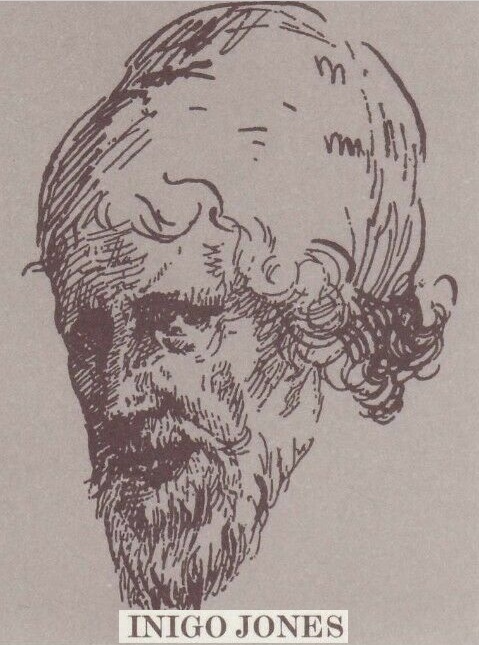
Inigo Jones, born in the Smithfield area of London on 15th July 1573, was the son of Inigo Jones senior, a Welsh cloth worker, and began his working life designing costumes and stage sets for the theatre. He worked closely with Ben Johnson and is credited with helping to stage over 500 performances during his lifetime. In 1606 he was employed by Robert Cecil, 1st Earl of Salisbury, to work on the scenery at Theobalds House, for which he was paid the princely sum of £23, but more importantly he met Royalty whilst working there; on 6th July 1606 King James I, and his brother-in-law King Christian IV of Denmark, stayed at Theobalds and would have been introduced to Inigo Jones, calling him ‘Master Inigo Jones, although he was later labelled ‘Iniquitous Jones’ by the Lord Chancellor. A year later the King exchanged his Hatfield Palace for Theobalds House, transforming it into a Palace and gifting it to Anne of Denmark. Three years later, in 1610 Inigo Jones was appointed to the post of Surveyor for Prince Henry Frederick and worked on some of the changes to St James’s Palace, but when the Prince died of Typhoid Fever on 6th November 1612 at the tender age of 18 Jones looked for a new post. On 27th April 1613 he became Surveyor of the King’s Works, although Simon Basil, who had been appointed to that post in 1606 continued in the role when Jones embarked on his travels to Italy, along with the Thomas Howard, 14th Earl of Arundel, to research the architecture of the country, visiting Rome, Florence, Genoa, Padua and Venice. Simon Basil died in September 1615, and by then Inigo Jones had returned from Italy and resumed his role of Surveyor. It was a timely return, for King James needed his expertise in completing the building of Palace II, extending it in 1619 by designing the Prince’s Lodgings for King Charles I, based on ideas from the Palazzo Trissino by Scamozzi. This achievement was celebrated by the Royal Mail in 1973 when they issued a First Day Cover of Inigo Jones and his famous works, one of which was part of the Newmarket Palace.
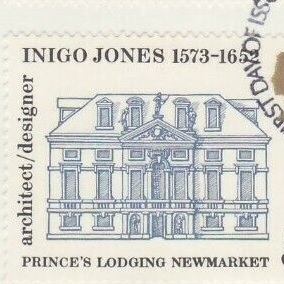
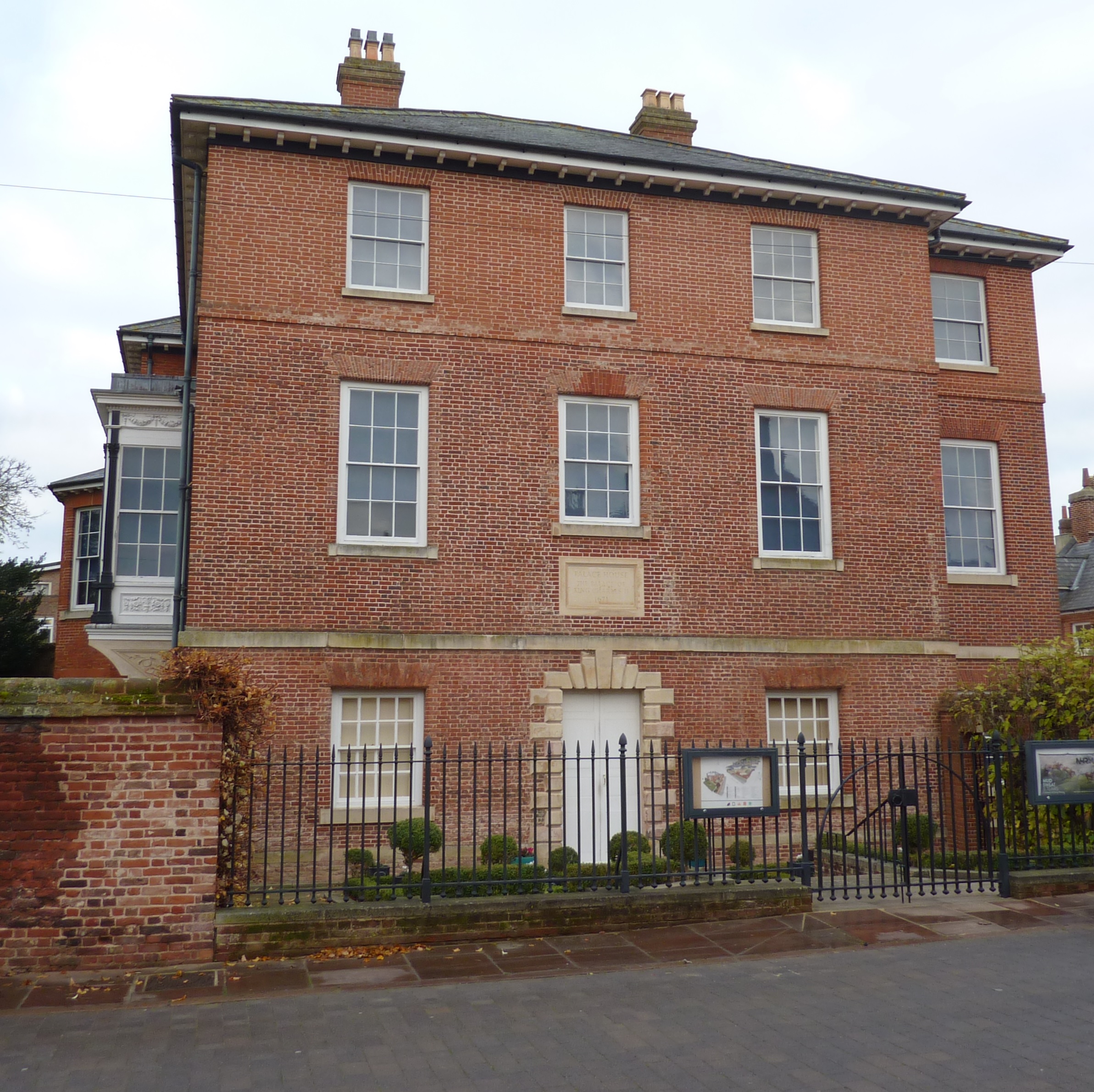
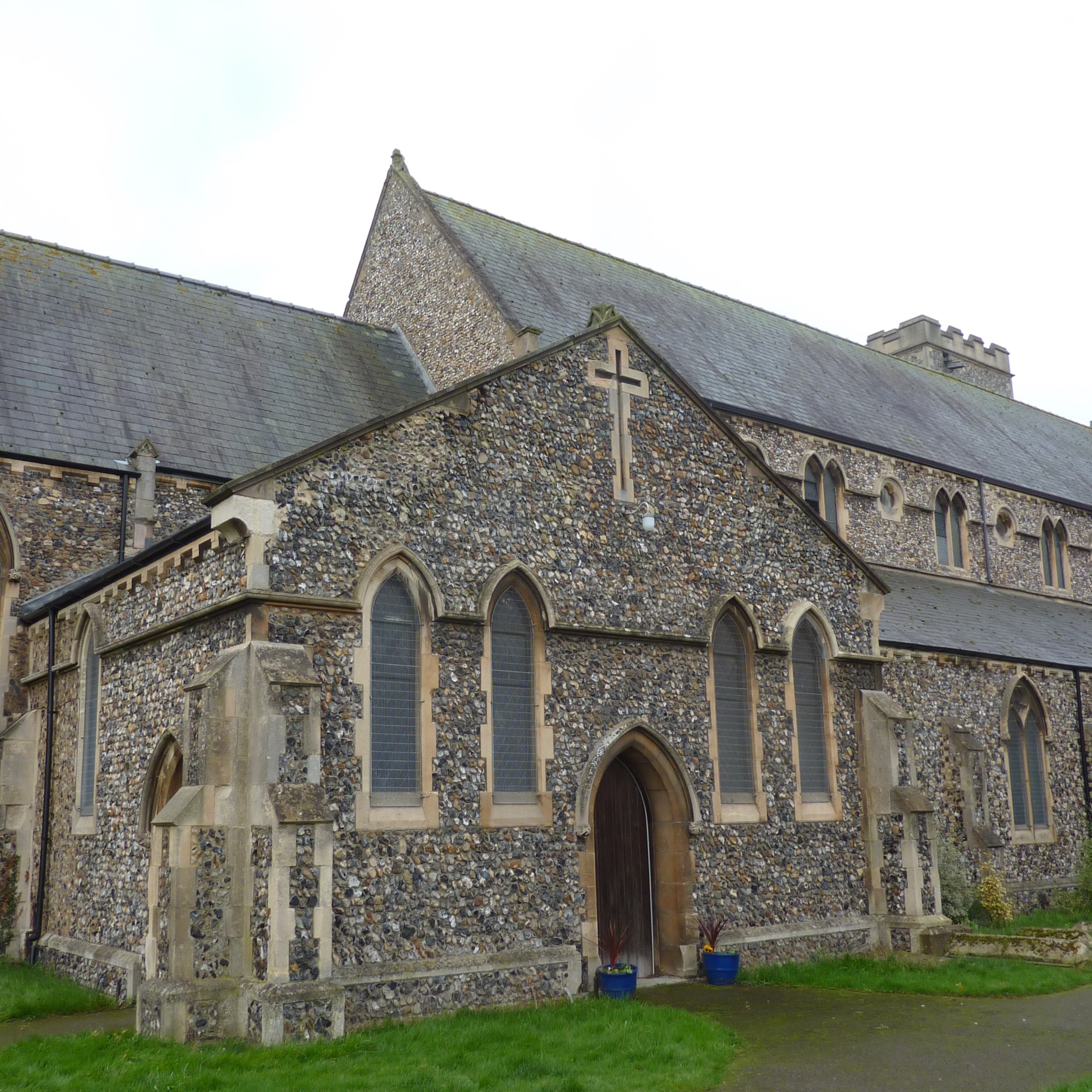
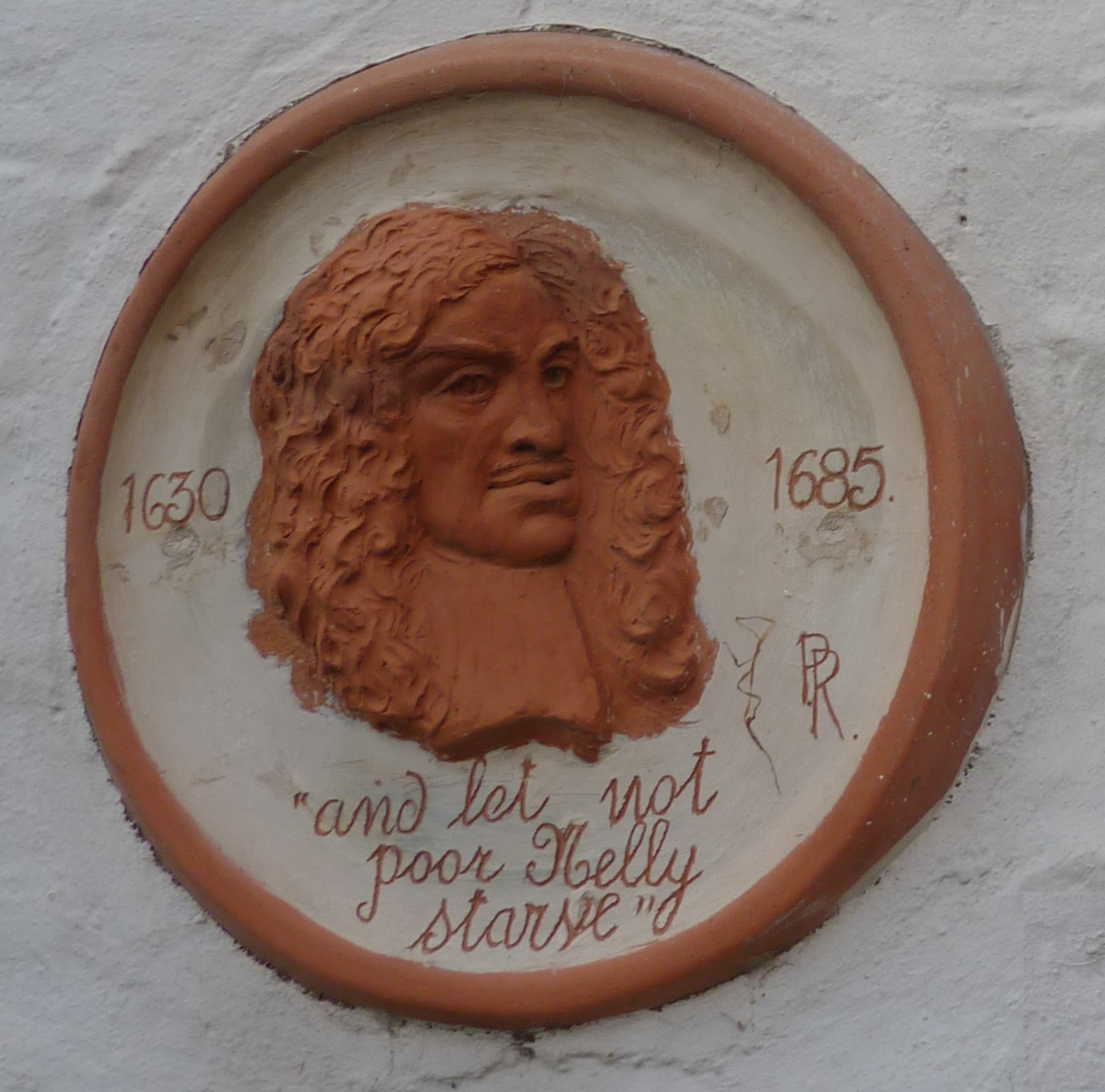
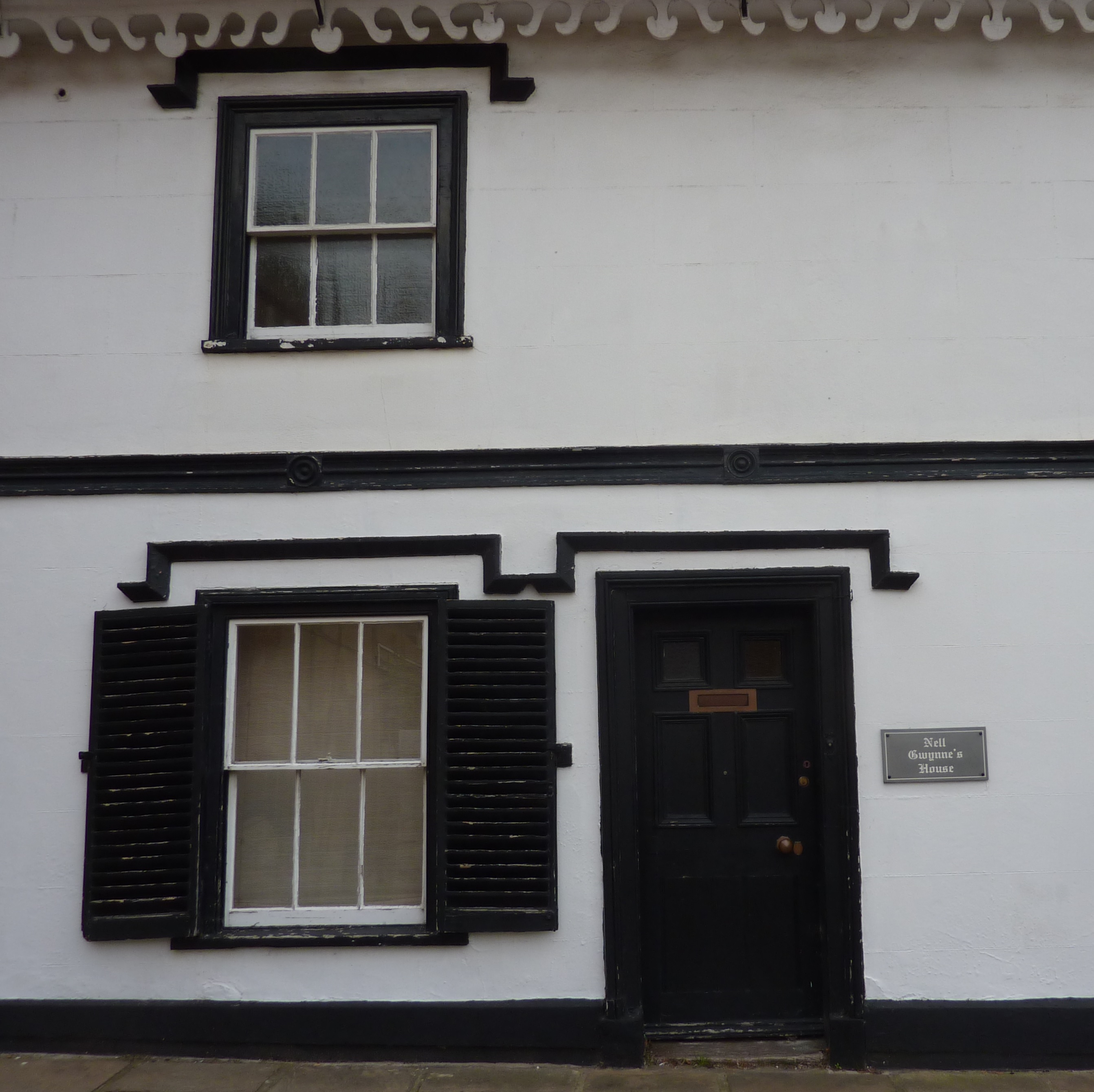
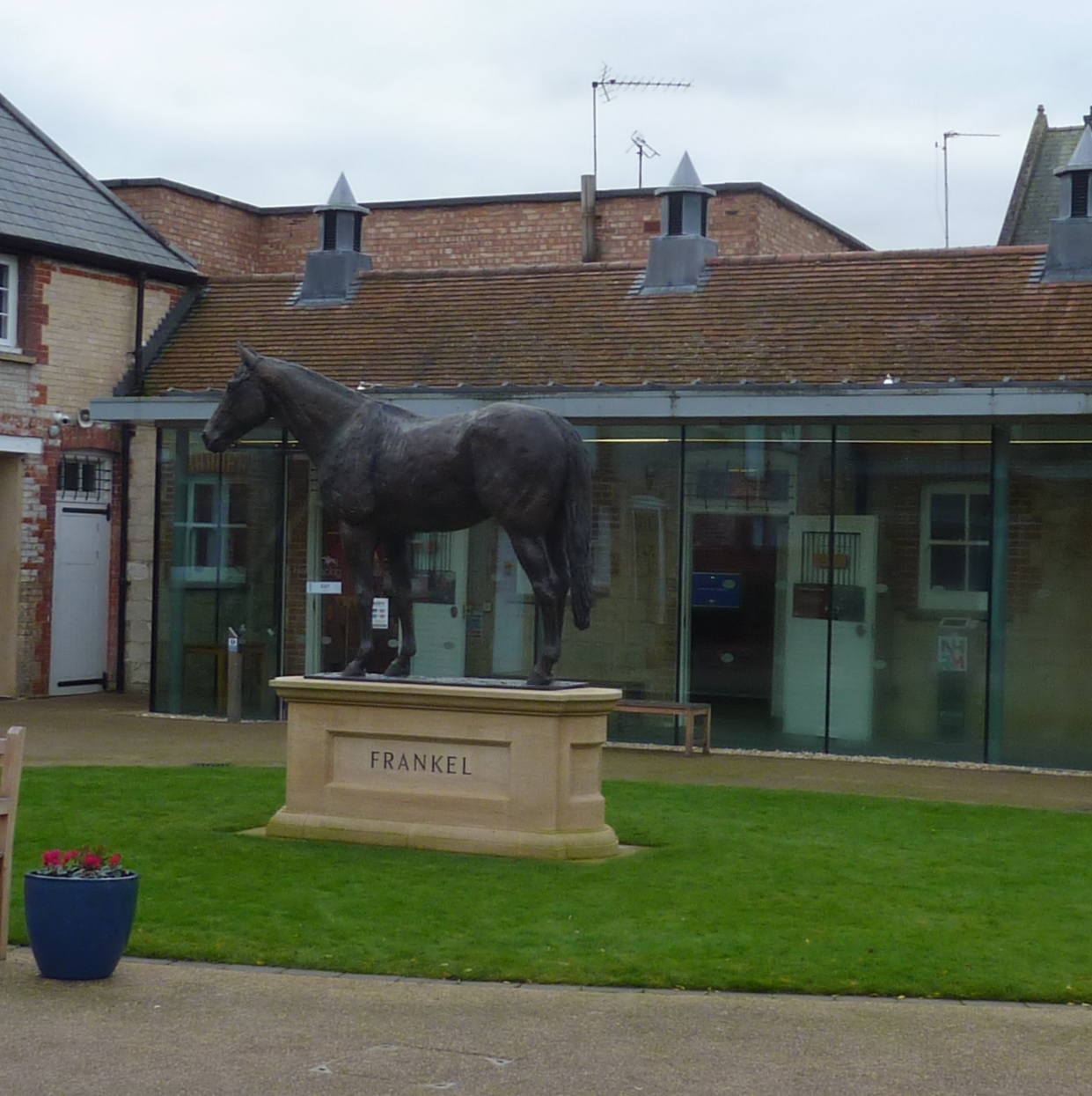
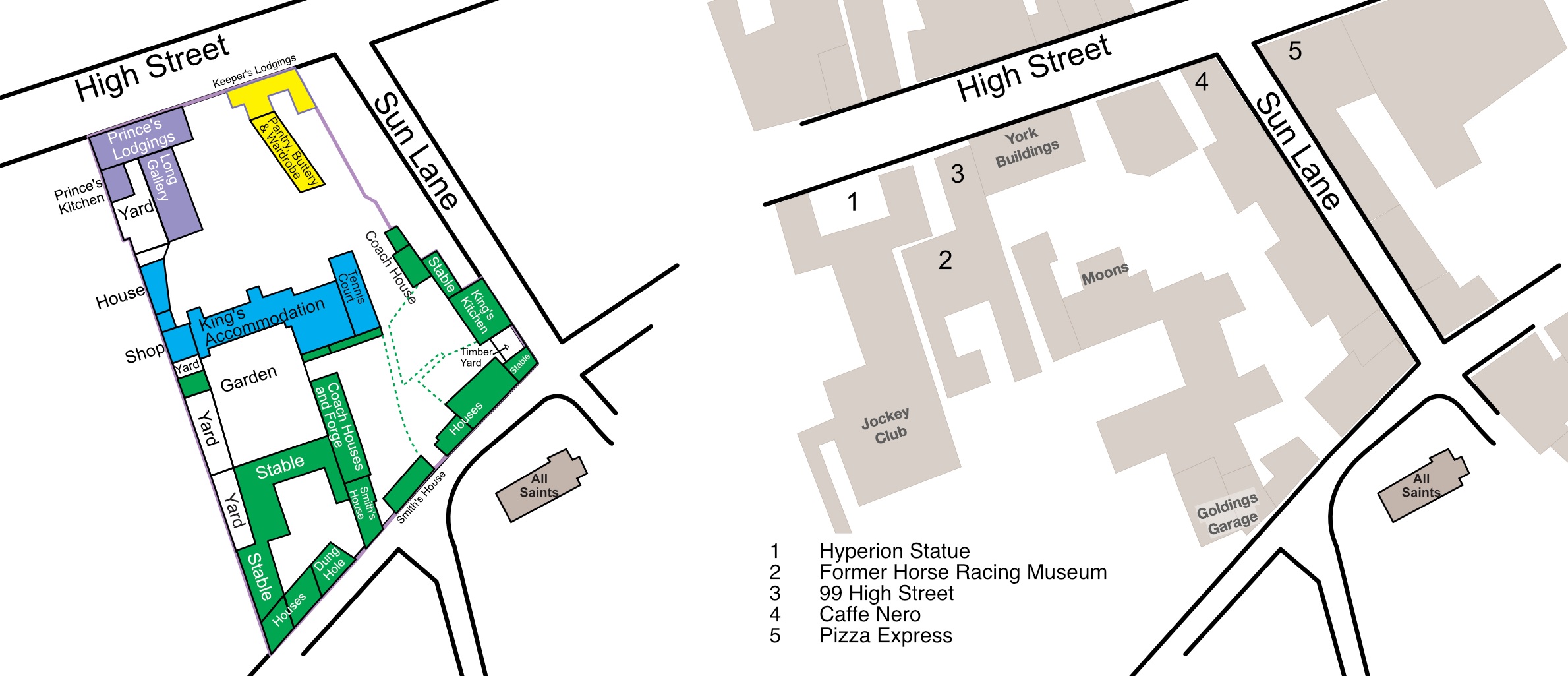
In July 1614 the King is joined by the King of Denmark at his Newmarket Palace and the entourage enjoy hare-hunting and bear baiting, while immediately afterwards the King embarks on a tour of the country from Monday 18th July to Tuesday 30th August, starting with visits to Theobalds, Royston and Audley End, and finishing at Woodstock, Rycott and Bisham. He did return to Newmarket in early November, so it is presumed that Palace II, if it can be termed as such, given that it was on the same site as Palace I where the foundations had collapsed, was habitable once more. On the first Saturday of November 1614 the King suffered a fall when out hunting, although he escaped serious injury.
He was still in Newmarket on 21st November, conferring Knighthoods on Sir William Some and Sir John Repingdon, and remained in Newmarket until the middle of December, his decision particularly influenced by the harsh wintry conditions. From 12th January to 22nd March 1615, James I resides at his Newmarket Palace, entertaining the Marquis of Brandenburg, and Knights Sir Dudley Norton on 19th January. Towards the end of the year, just before Christmas, the King is at Newmarket on 17th December 1615 along with 20 Earls and Barons, and a large number of principal Gentlemen, with more than one commentator questioning how they can all lodge in ‘such a poor village’. After residing for a few days at Palace II he travels a short distance to Royston on 22nd December, but he did not enjoy Christmas because he was sorely troubled by gout.
Palace II expenses 1614-1615
Accounts showed that the grand sum of £4660 11s 9 ½d was spent on the new Palace II. The extreme expenditure, as a consequence of the devastating collapse of the foundations of Palace I, was for building what can now be viewed from hereon as Palace II. The chief amount was spent on the new stone and brick lodgings of the King, with a great chamber, presence-chamber and additional rooms both below and above the King’s lodgings for noblemen and gentlemen of the bed-chamber. The initial main building programme for Palace II was from 1st May 1614 to 30th September 1615 and required the purchase of an additional parcel of land 30ft by 19ft from John Ramsey on which His Majesty’s new Palace was extended to make the line of the building straight. The walls of the new Palace were 3 bricks thickness in the foundations and ground floor, while the first and second floors were 2 bricks thickness. The King’s bedchamber was extensive, which, together with the Prince’s Lodgings, privy lodgings and the chambers occupied by the Earl of Montgomery, Lord Haddington and Lord Hayes, required 780 sq yards of new bulrush matting.
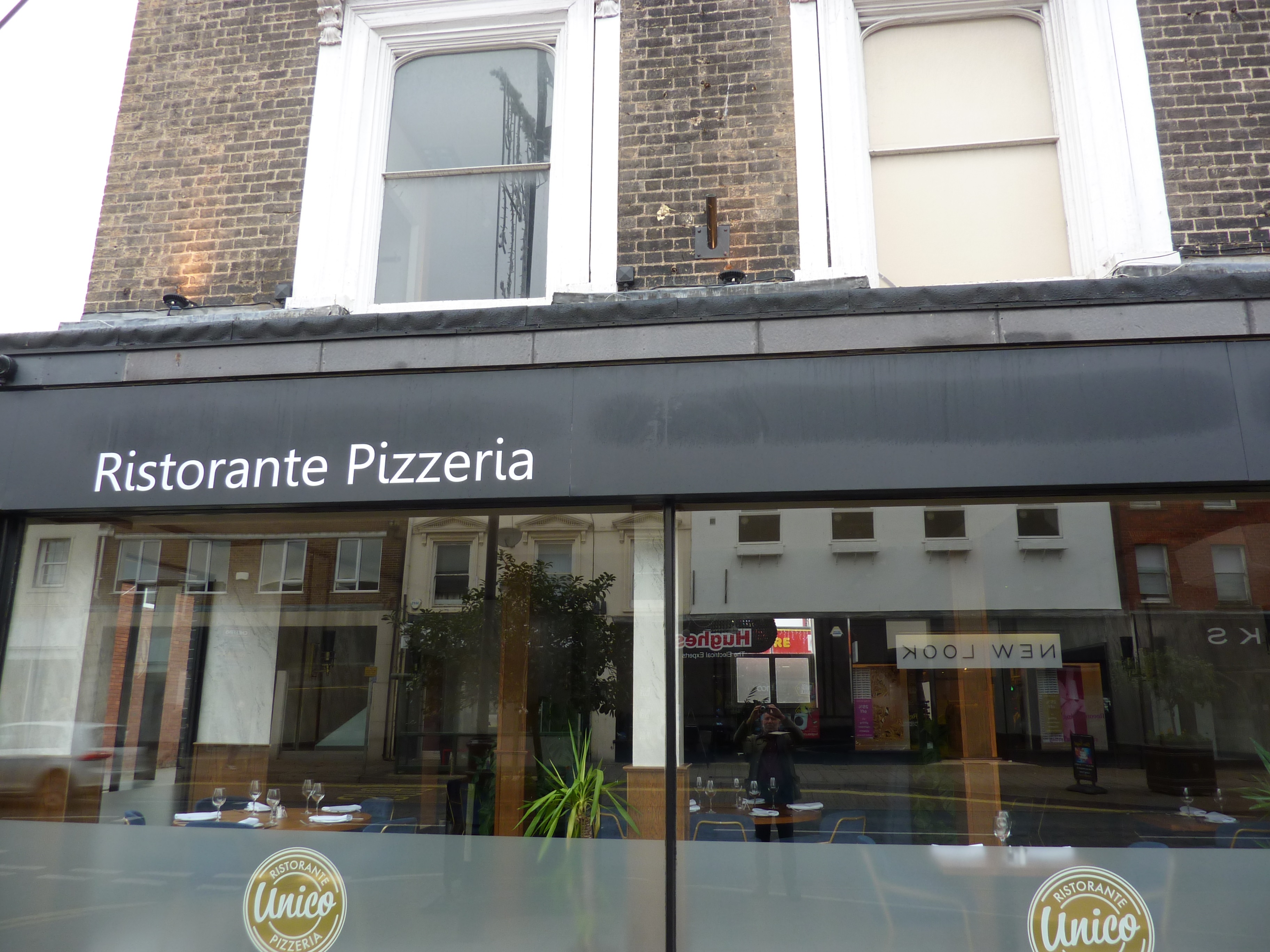
1617-18 £467 15s 4 1/2d
1618-19 £476 12s 4d
1619-20 £975 2s 6d
1621-22 £238 2s 8 1/2d
1622-23 £253 2s 6d
1623-24 £187 9s 10 1/2d
1624-25 £148 5s 6 1/2d
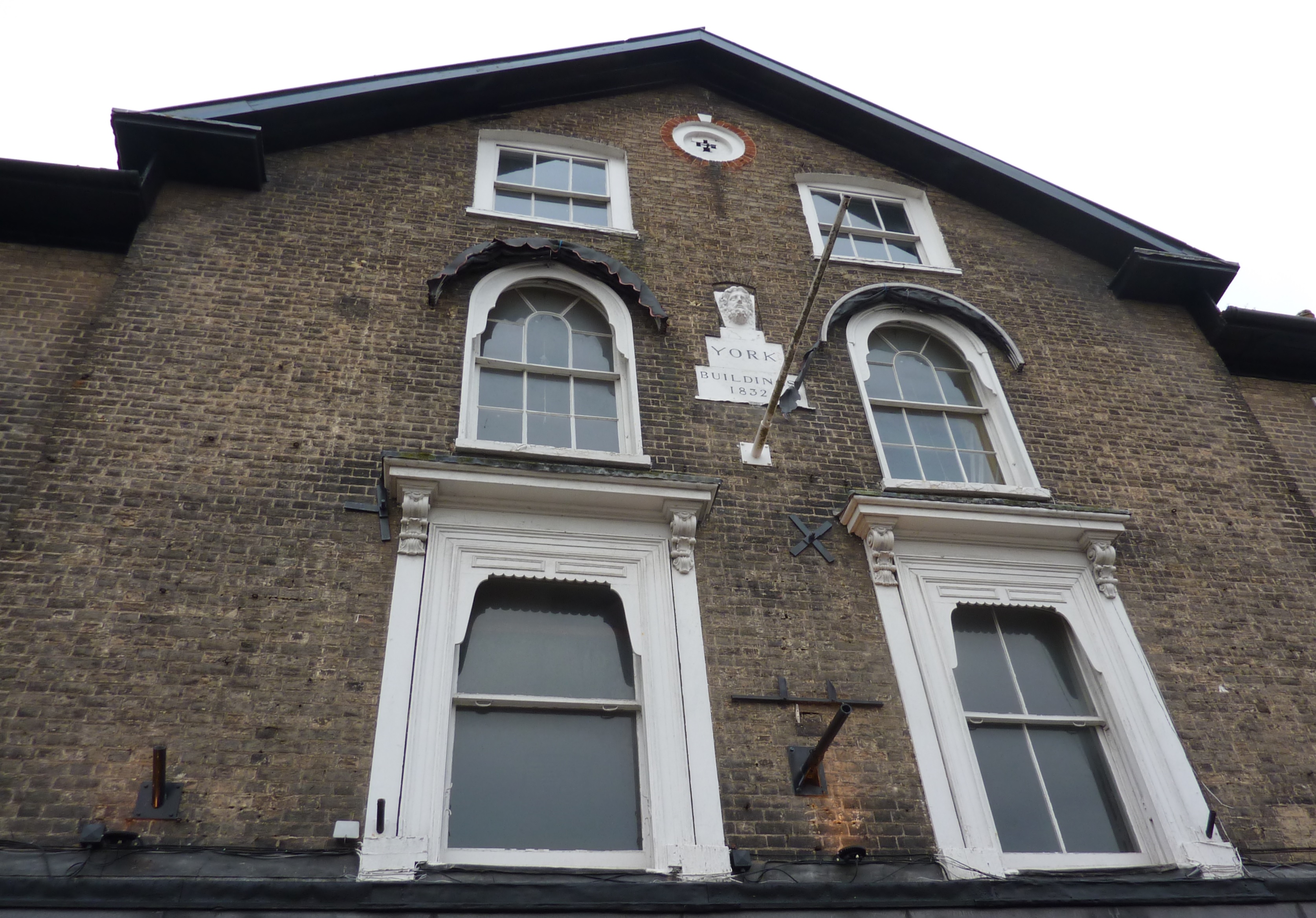
Palace II expenses 1615-1617
After the expensive 17 months from late 1614 to 1615 when Palace II was built, further work was undertaken in the remainder of 1615, and throughout both 1616 and 1617. Between 1615 and 1617 additional land amounting to 3 roods, or ¾ of an acre, was acquired to extend the Palace and its grounds, leading to the expenditure for the 2 years 1615-16 and 1616-17 to reach £2606 13s 2d and £2446 3s 0 1/2d respectively on outbuildings, extensive gardens, stables, and kennelling for the King's hounds. The large stable, built for the King’s hunters, and a kennel for his hounds, were built of Northampton stone, each having lodgings over them, the cost for these being £1704 19s 5 1/2d. A new Brewhouse was built, while repair work was needed on the tennis court using bricks at the base, and adding a layer of paving tiles to level it up and improve the playing surface. Furthermore, a riding-house and additional storehouses were added.
The King returned to Newmarket in the early days of 1618 Knighting a few more worthy men, although he did avoid his usual Lent visit to the town. It was clear that Inigo Jones was still working on Palace II for the King in 1618 and was greatly in favour with James I who, on 14th October, sent him and the Earl of Arundel grapes and peaches, and continued to do so twice a week. This was at a time when the King was concerned about the health and well-being of the Queen who was bleeding a lot and, almost on a nightly basis, felt as though she was being suffocated in her sleep.
Just 2 weeks later the King ratified the earlier death sentence given to Sir Walter Raleigh for ransacking a Spanish outpost on an expedition when Britain was trying to mend its relations with the Spanish. Raleigh was beheaded on 29th October 1618 aged 66, which did not seem to trouble the King who spent the last weeks of October and all of November at his Newmarket Palace. During that prolonged stay the King celebrated the 18th birthday of Prince Charles who was born on 19th November 1600 at the Palace Buildings, Rosyth. The party on 19th November 1618 was attended by a number of Marquesses and Lords, each of whom were instructed to bring a dish of meat of their own choice. The table must have been a spectacular display, with substantial, curious and extravagant dishes, but the prize for the greatest invention went to Sir George Goring whose dish was 4 brawny, piping hot pigs, bitted and harnessed with ropes of sausages, all tied to a monstrous bag-pudding.
Palace II expenses 1617-1618
Accounts showed that the expenditure during this period amounted to £467 15s 4 1/2 d.
A stable was built, complete with lodgings for Sir Thomas Compton.
Alterations and an extension of the King’s Great Stable.
Making tressle tables, cupboards and screens for the feasts of the German Prince and Sweden Ambassador.
Increase in the size of the fence wall around the tennis court.
Building a low brick and stone fence wall against the great gates near the churchyard.
The King visited Newmarket on a number of occasions in early 1619, Knighting a few people from time to time, and was still at his Palace on 26th February when he Knighted Sir Thomas Fleetwood. The Prince of Wales visited his mother, the Queen, on 1st March, but early the following morning she died of dropsy aged 44. Some of her remains were buried on 5th March in a sexangular coffin in Westminster Abbey close to the final resting place of Queen Elizabeth I, although the King remained at Newmarket, the formal funeral taking place later in the year. Despite his wife, Anne of Denmark, dying on 2nd March 1619, his period of mourning ended within a fortnight, as he attended an impromptu horserace in Newmarket on 19th March and stayed so long at the meeting that he had to stop at an Inn at Wichfordbridge before making Royston late at night. In 1619 the Palace was extended to include a new brick and stone lodge, the Prince’s Lodge, 3 storeys high, and the Long Room, designed by Inigo Jones for the Prince of Wales.
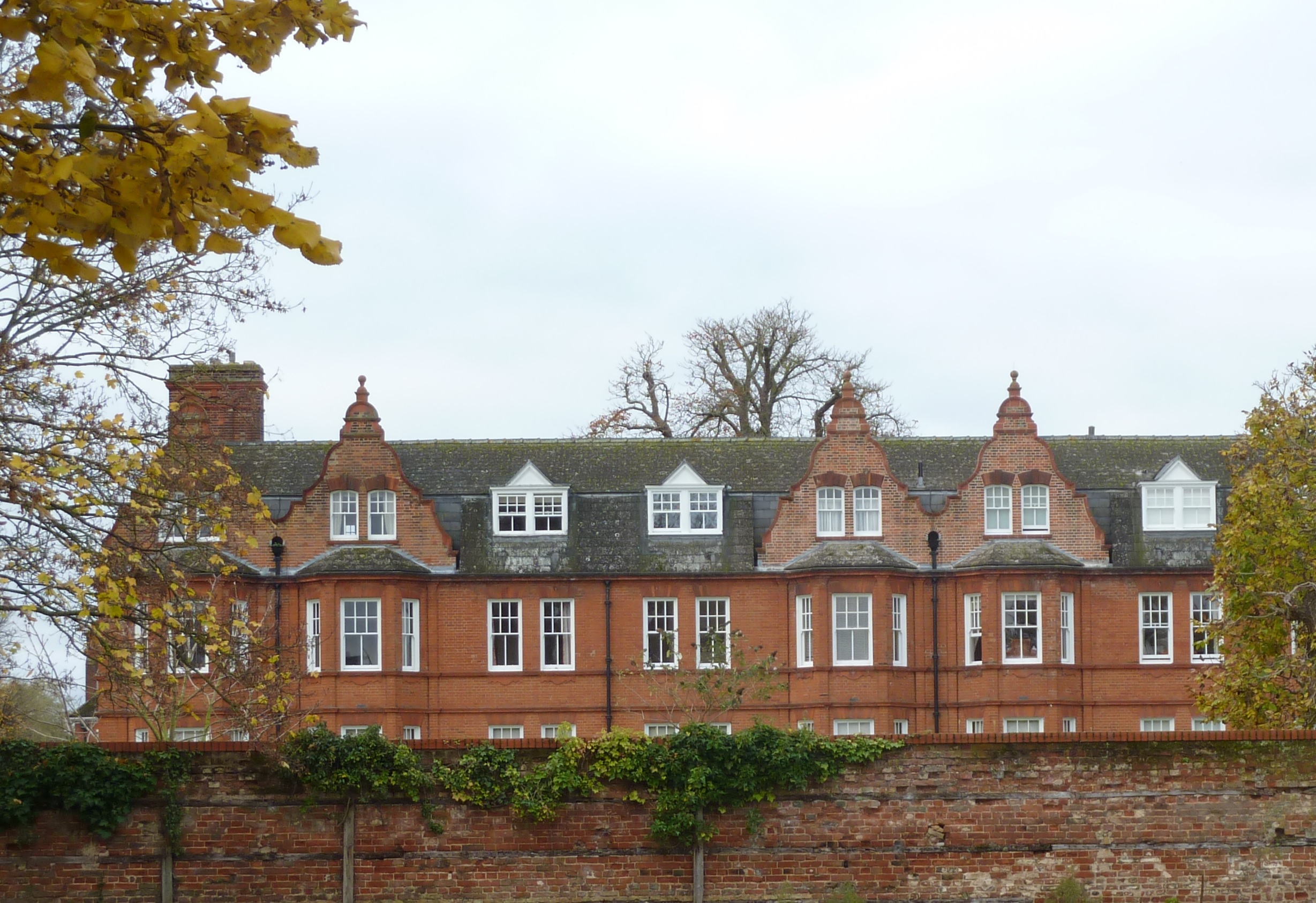
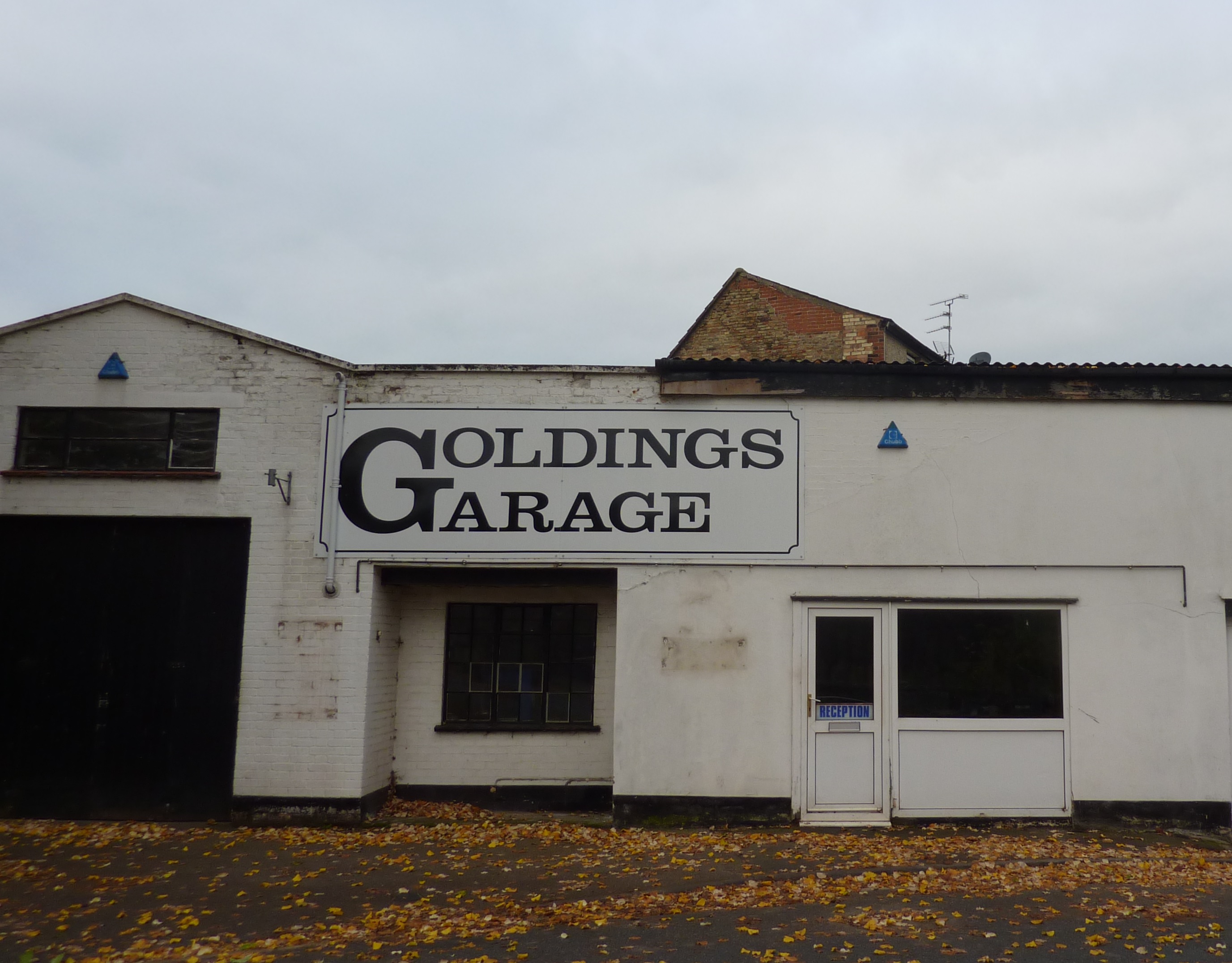
Palace II expenses 1619-1620
Accounts indicated that £2719 15s 6 1/2 d was spent during this period.
Pulling down old buildings and sheds towards the street (High Street) and clearing the ground.
Erecting a brick and stone lodging for Prince Charles (designed by Inigo Jones), as well as a Long Gallery and additional offices.
Building a Farrier’s Office and Coach houses.
Enclosing the wood yard with a stone wall.
Erecting lodgings and storehouses for the Clerk of Works.
Building a room on the rear side of the King’s privy Kitchen for the Marquis of Buckingham, complete with washing, boarding, lathing, tiling and decorating the ceiling.
Palace II expenses 1620-1621
Accounts showed £975 2s 6d was spent during this period.
A new well was sunk 5 fathoms (30feet or 10.8 metres), serving the King’s and Prince’s Kitchens, paid for at 5 shillings per fathom.
New bulrush matting provided for all principal apartments and stairs.
Palace II expenses 1621-1622
A total of £238 2s 8 1/2d was spent during this period.
On 3rd October 1622 a warrant was issued to pay Sir Robert Vernon £150 for lands belonging to The Swan Inn, to be taken for building offices for the King’s use.
In 1622 King James purchased the land, to the east of the former Griffin Inn, on which The Swan was located. An account, written in 1622 by Sir Richard Graham who was 'Gentleman of the Horse' serving under Sir George Villers, 'Master of the Horse', contained a list of the Royal Stud horses kept for the chase and for races on the turf. In addition to a Royal Stud at Newmarket, there were other Royal Studs at Tutbury, Eltham, Cole Park, Malmesbury which was later leased to Sir George Marshall in 1625. The account also states that Sir George Villiers, Duke of Buckingham, lost a £100 wager to Lord Salisbury at Newmarket, probably the earliest of Newmarket Race meetings, further stating that the King's jockeys were Thomas Freman and John Pritchard. The 'surveyors of the races' at this time, each paid £22 pa, were Sir William Powell and Sir George Marshall, Sir William had been knighted at Royston on 6th October 1614 and was paid an additional £500 pa for 'keeping the King's racing mares'. Whilst it is known that James I enjoyed deer and hare hunting, probably preferring them to horse racing, he did attend meetings throughout the country. On Monday 10th March 1611 the King and his court attended Croydon races, while in the Spring of 1617 he attended Lincoln racecourse, moving on to Durham in April 1617 when he was present at a race meeting at Woodham Moor. On 5th October 1622 James I and his entourage left Hampton Court, passing through London and Royston on the way to Newmarket where he spent much of November, meeting Sir Edward Conway and the Dutch Commissioners. The weather was so severe in London that 280 inhabitants a week were dying of the cold. At this stage in his life the King suffered badly from both gout and arthritis. Newmarket Heath was said to be awash with highwaymen who carried out their crimes and then made haste to London to commit, and be arrested for, petty crimes for which they were put in jail for a month, enabling them to be sheltered until the 'hue and cry' over their Newmarket crimes had blown over.
Palace II expenses 1622-1623
Accounts indicated that £253 2s 6d was spent during this period.
Mending the wainscot, shutting windows and casements in both the King’s and Prince’s privy lodgings.
Creating a shed to boil fish for the Prince.
Making ledges on the walls of the great horse-stable with pins to hang saddles.
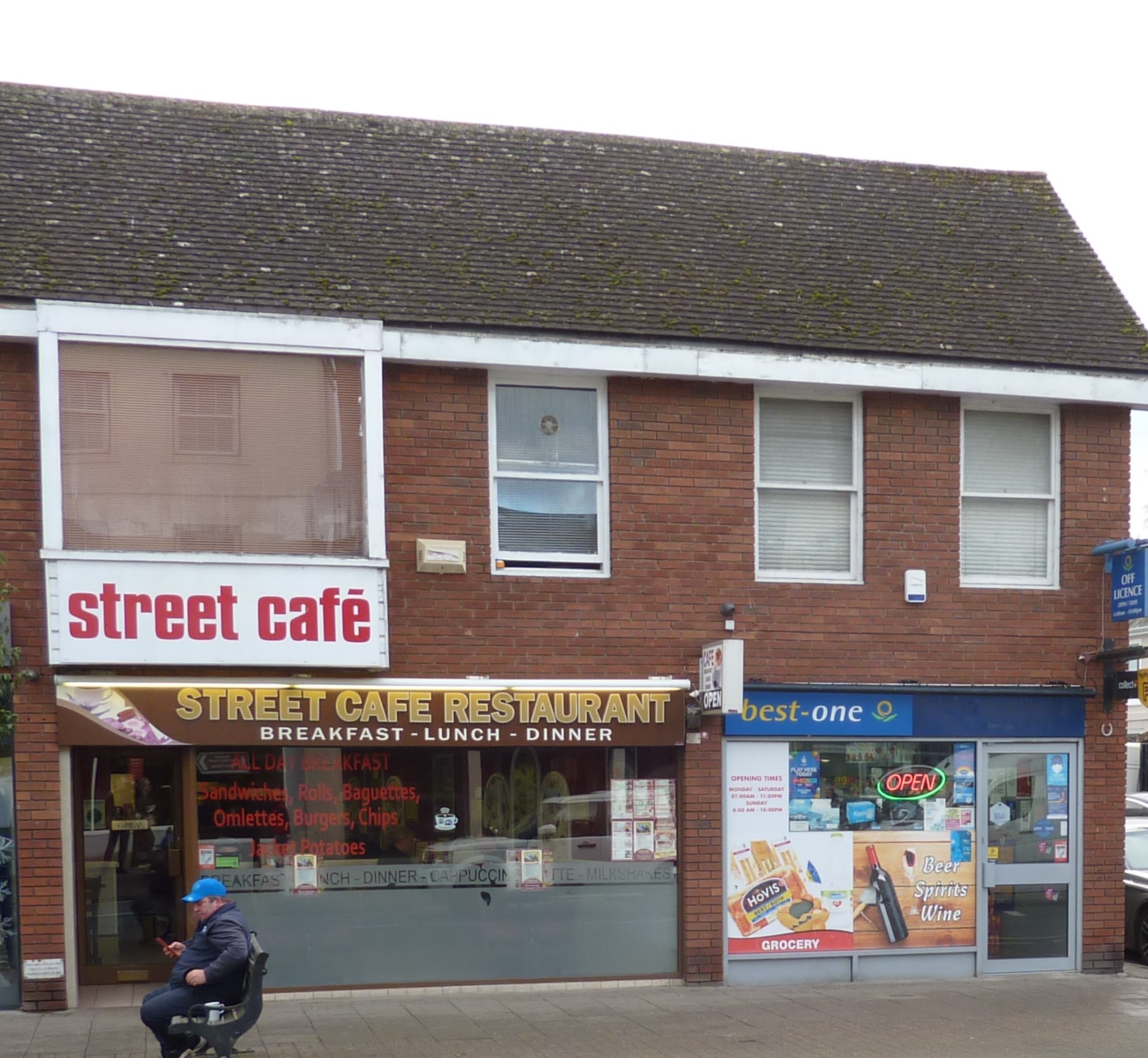
Palace II expenses 1623-1624
For this period £187 9s 10 1/2d was spent, including repairs to the King’s hunting horse stables and the Duke of Buckingham’s stables.
Palace II expenses 1624-1625
In the final year of King James I’s life £148 5s 6 1/2 d was spent on his Palace.
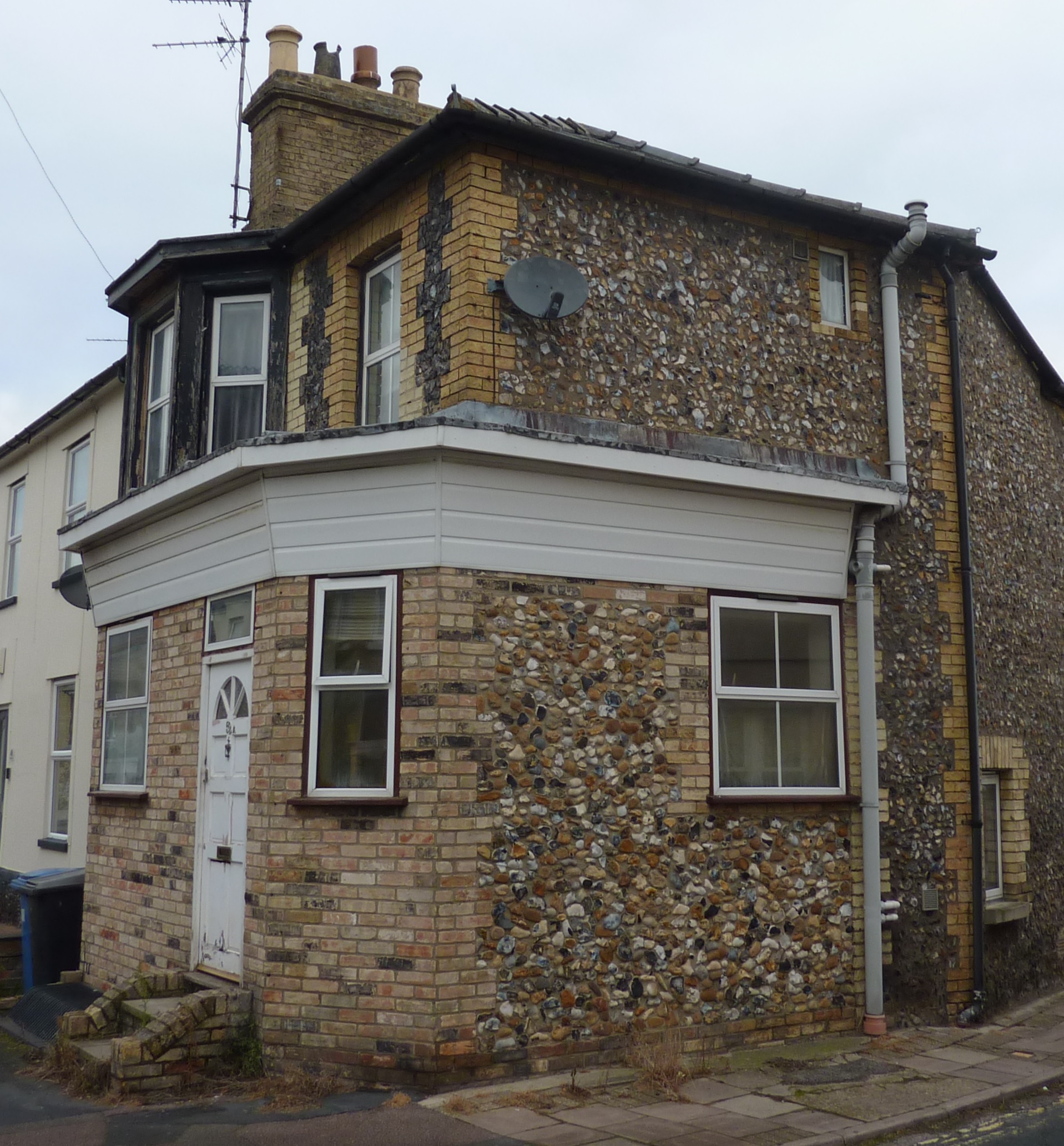
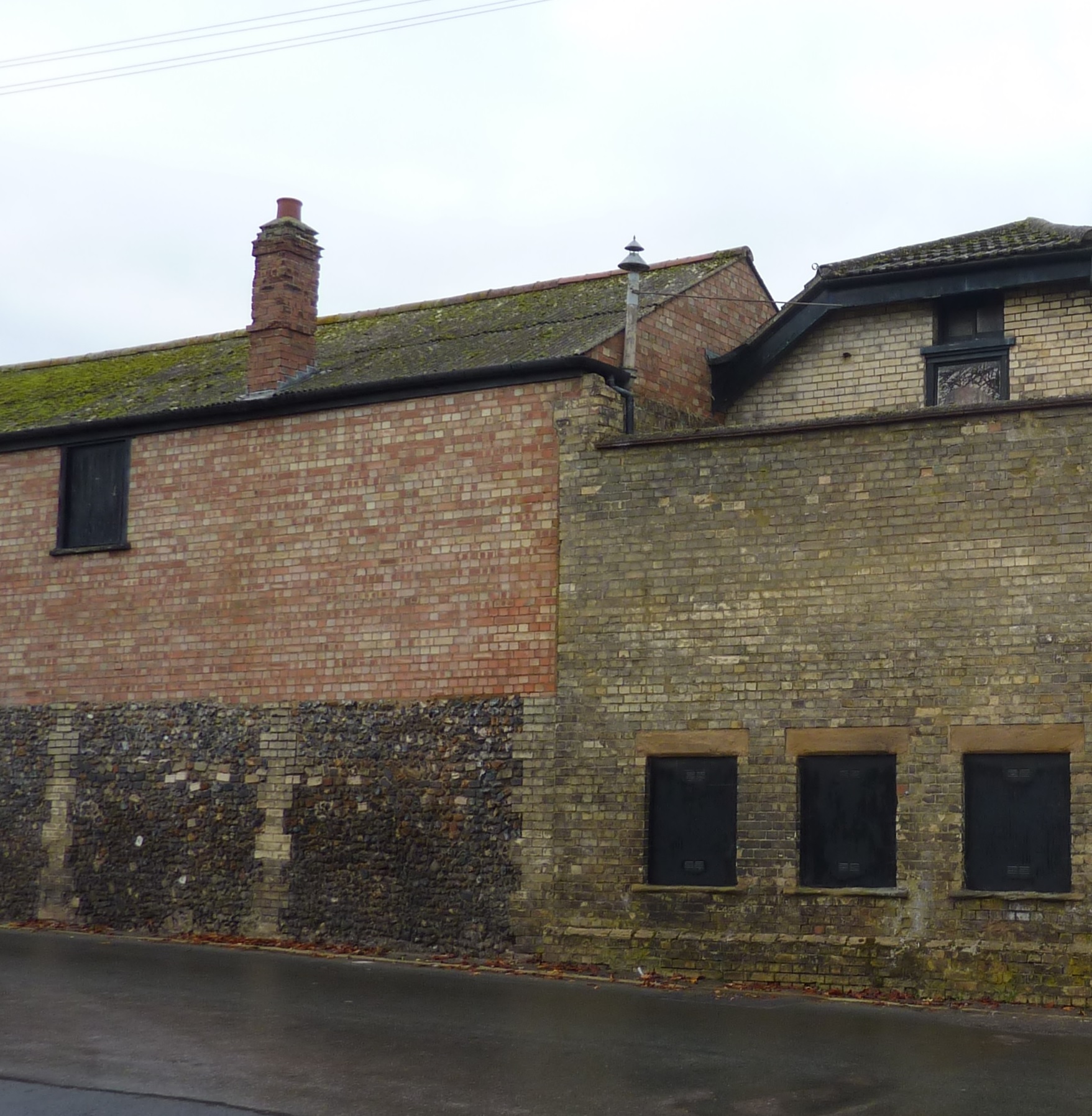
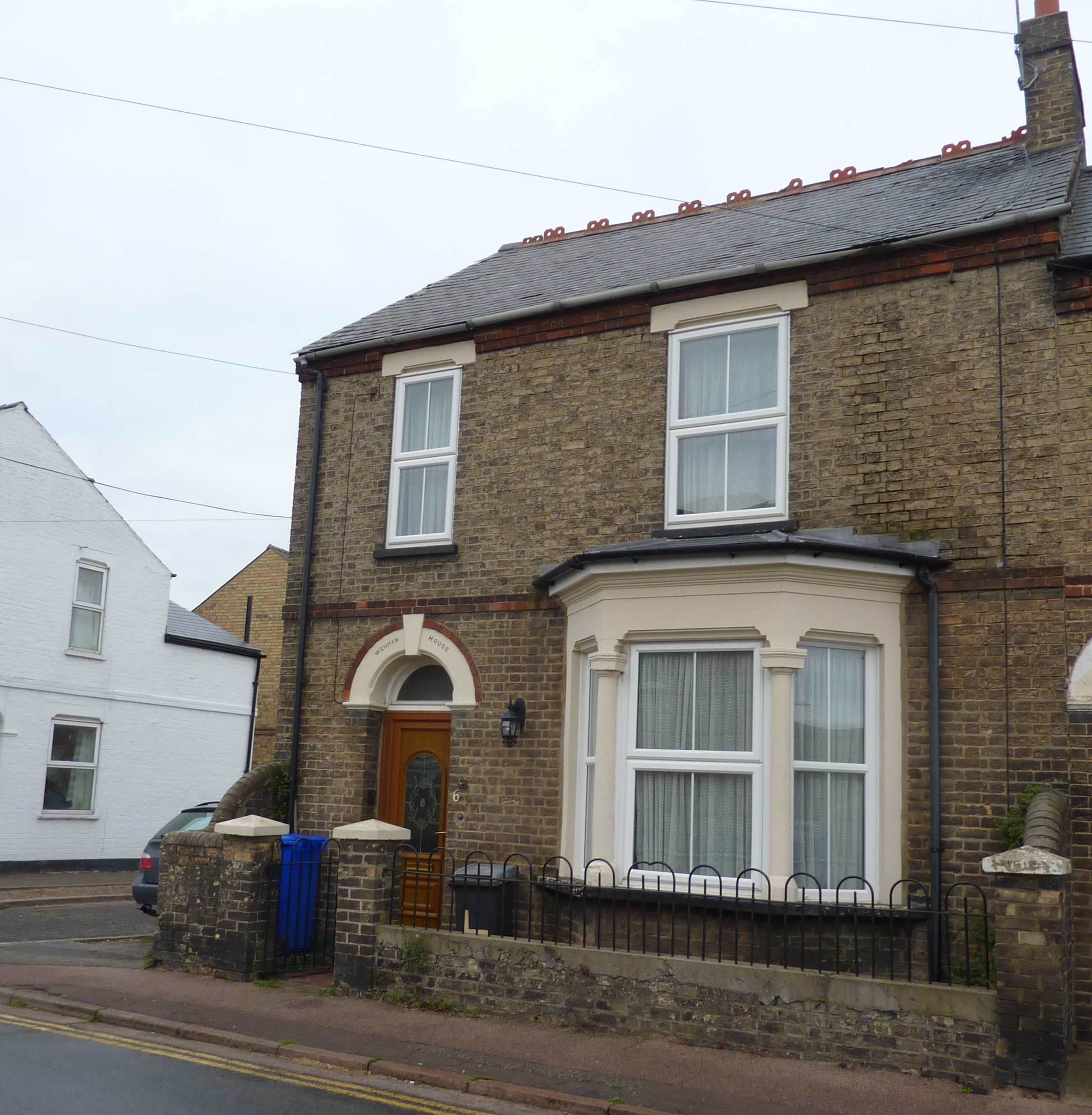
In the latter years of his life James I suffered from poor health and drank quite heavily. He spent Christmas 1624 confined to his bedchamber due to his deteriorating health, but did make his way to Newmarket on 3rd February 1625, his final visit to his Palace in the town, where he was accompanied by the Duke of Buckingham. On 27th February the King and his council made the short journey to Chesterfield Park, on their way to Royston, where he was joined by Charles, Prince of Wales. They ventured on to Theobalds House on 1st March where they remained for the rest of the month. The King was plagued by severe attacks of arthritis, gout, and fainting fits, and at noon on 27th March 1625 the King suffered a stroke and died, after which the Prince of Wales was immediately crowned King Charles I. Between 1609 and 1625, a total of £20,383 13s 2d (equivalent to £5.5 million in 2021) was laid out on the two Palaces during the reign of James I.
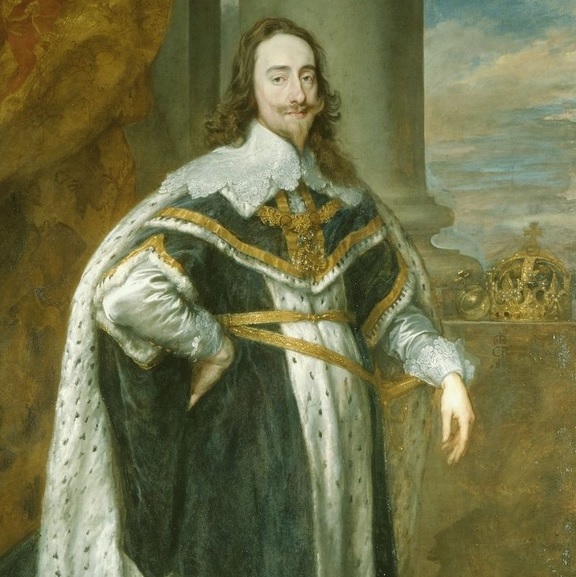
After the death of his father, James I, in March 1625 the former Prince of Wales, Charles was crowned King Charles I. On 1st May 1625 he married, by proxy, Henrietta Maria, then aged 15, although the couple did not meet each other until 13th June 1625 at Canterbury. Around the time of his marriage his best friend, the Duke of Buckingham, met with the artist Peter Paul Rubens, commissioning him to paint his equestrian portrait, and that relationship with Rubens was to prove useful later on. It was over 18 months later that King Charles was due to visit the King's Palace in Newmarket in November 1626, although he was advised against it by the Duke of Buckingham who feared that the Palace was not sufficiently guarded. Upkeep of the Palace, and in particular the stables and mews at Newmarket, was by Francis Wetherlay, 'Surveyor of His Majesty's Stables', who was paid £95 8s 6d in April for his work. The Under-keeper of the Palace and Gardens was Thomas Grey who was paid £150 in arrears for 9 years of service, and a further retainer of £30 per annum. King Charles I maintained the Royal interest in hunting which his father had enjoyed immensely, and assigned Captain Henry Wood the task of supplying 50 brace of partridges and a similar number of hares at the New Warren in Newmarket.
Palace II expenses 1626-1627
Accounts indicate that £229 7s was spent during this period.
Clerk of Works, paid at 1s 8d per day, directed plumbers, plasters, mat layers, bricklayers and general labourers to carry out necessary repairs, although no big projects were undertaken.
The first occasion King Charles I visited Newmarket was on 23rd February 1627, and he was certainly still in Newmarket on 2nd March, but left 3 days later for a stay at Theobalds Palace.
Palace II expenses 1627-1628
Accounts indicate that £113 16s 3 1/2 d was spent during this period.
Replacing and relaying mats in the privy lodgings.
Planking the King’s Stables.
Tiling the dormer windows and other areas of Prince Charles I quarters.
Paving and blackening the walls of the tennis court.
Charles I spent a short time during Spring in Newmarket from 23rd February to 10th March 1628, although he was more interested in real tennis, as was his older brother Henry who died aged 18, than horse racing during the visit. King James I had built a tennis court for Henry to use in the grounds of Palace I, and it was extended and improved in the extended grounds of Palace II, so Charles would have used it from a very early age. Throughout his sojourn in Newmarket he partook of field sports when he ought to have been paying more attention to State affairs, both in England and on foreign shores. His favourite friend, the Duke of Buckingham, George Villiers, encouraged him to wage war against both Spain and France, which was no doubt a costly business, and King Charles I expressed his desire to levy taxation against the wish of Parliament. Parliament disagreed, but Charles believed in his divine right to rule and dismissed Parliament in 1629, and did not recalled it until 1640 when Charles was desperate for money. Villiers was not well liked, and not just for his poor decision making, and on 23rd August 1628 he was assassinated at the Greyhound Inn, Portsmouth, suffering a fatal stabbing by John Felton.
Palace II expenses 1628-1629
Accounts indicate that only £28 7s 9 ½ d was spent during this period, and no new projects were undertaken.
Palace II expenses 1629-1630
Accounts indicate that £169 17s 5d was spent during this period.
Mending the racks, stalls, mangers and other areas of the King’s Stables.
Mending the kennels and dog yards.
Mending the tennis court.
A further 3-week spell, from late February to early March 1630, saw Charles I and his court at Newmarket, but he does not appear to have gone racing during this period, although upkeep of the Royal Stables was put at £12,438 19s 4 3/4 d (equivalent to £2.8 million in 2021). A particularly lavish and memorable celebration was staged at the Royal Palace on Sunday 28th February 1630 when the Doctors of Cambridge University were elaborately entertained at a cost of £35 18s 9d, equivalent to £8500 in 2021. Earlier in the year the King had been gifted a painting, ‘Allegory of Peace and War’ by artist Peter Paul Rubens, which he had completed in 1629. Rubens, as well as being an artist, was also a diplomat, and had tried to negotiate peace between Spain and England. Whether it was for his diplomacy, or for the painting, Rubens became the first Knight of King Charles I on 1st March 1630.
Palace II expenses 1630-1631
Accounts indicate that £321 2s 5d was spent during this period.
A year when aging parts of buildings were repaired using large amounts of timber and paving tiles. Another noticeably large expense was on glass and glazing work.
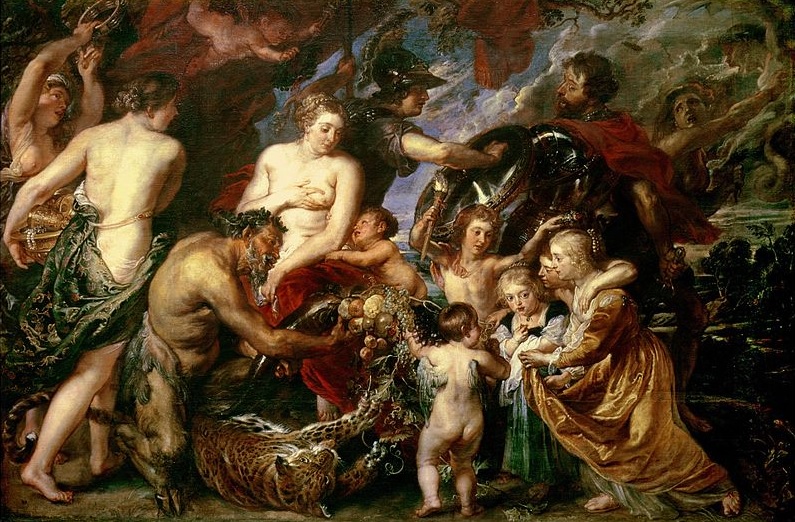
On 10th January 1631 King Charles I, Queen Henrietta, the Earl of Carlisle, Lord Warden and the Earl of Holland all arrived in Newmarket to enjoy a quiet break in the Royal Palace. However, it proved to be anything but a quiet break, for a few days after their arrival an extraordinary State wedding was hosted at the Palace when Sir Frederick Cornwallis (one of the King’s Equerries), married Elizabeth Ashburnham, (one of the Queen’s Women of the Bedchamber) daughter of Sir John Ashburnham and Elizabeth Richardson, Lady Cramond. Cornwallis, born on 14th March 1610, was the son of Sir William Cornwallis, who died shortly after his birth in 1611, and his second wife Jane, Lady Cornwallis Bacon. Sir Frederick had asked his mother, Jane, for her blessing of the marriage, but she refused. She had remarried in 1613 to Sir Nathaniel Bacon, and felt disinclined to agree to the marriage. On the other hand, King Charles and Queen Henrietta were very supportive of the couple, both in their employment, and wrote to Jane on 4th January 1631 requesting that she should change her mind. They further informed her that the wedding would go ahead, come what may, at the Royal Palace and that she was cordially invited. Despite being invited by the King, Jane refused to attend and the wedding went ahead without her, and it was only some time later that she relented and blessed the happily married couple. King Charles was generous in the extreme, not only hosting the wedding, but also giving a £3000 wedding present to the couple. Unfortunately, Elizabeth died in 1643.
Palace II expenses 1631-1632
Accounts indicate that £135 16s 6 ½ d was spent during this period.
Mending parts of the King’s hunting horse stable.
Mending the ordinary stable of the Master of the Horse.
Renovating the King’s, Queen’s and Lord Chamberlain’s lodgings.
On 28th February 1632 the King, accompanied by his Queen and the Prince of Wales, stayed in Newmarket and almost certainly went racing with the Earl of Pembroke, a horse racing fanatic who gambled recklessly. The only record of a bet ever made by the King in Newmarket concerned an 80-year-old court attendant, Mungo Moore, who the King laid odds of 3/1 that Moore could not gain access to the King of Sweden's camp. Moore duly paid the King 3 pieces, but it is not clear whether he won the bet. King Charles I is said to have had his own personal Stand built on Newmarket Heath for his comfort, and to aid his viewing, during the race meetings. The Stand was described by J P Hore in Volume II of his ‘History of Newmarket and the Annals of the Turf’, even including a picture of it at the start of the volume, although the image was reversed, with the two Churches in the background on the wrong side. It was an impressive stand on two floors, with 3 entrance doors allowing entry to the ground floor at the front, and 7 windows on the first floor, BUT it has since been shown to be incorrectly dated, and is much more likely to have been from the middle of the 18th century.
Palace II expenses 1632-1633
Accounts indicate that £96 4s 7 ½ d was spent during this period.
Small items of repair, including the tennis court and Well.
In October 1632 the King resided at his Newmarket Palace for 5 weeks, although a longer visit had been planned, but the visit was cut short due to the severe cold weather which Newmarket experienced at that time. Whilst there the Royal Physician was Dr William Harvey, attending to the King throughout at £1 per week. On a previous visit to the Newmarket Palace Dr Harvey had become the first known Physician to fully describe the systemic circulation of blood being pumped around the body and up to the brain by the heart.
Palace II expenses 1633-1634
Accounts indicate that £165 17s 5d was spent during this period.
Cosmetic repairs apart from on the tennis court where the glazed windows were protected with wire mesh.
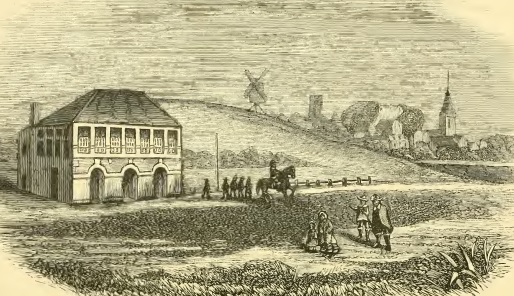
It is obvious that the King had enjoyed the time he spent in February 1630 with the Doctors of Cambridge, for they were invited to a return visit in October 1633, being entertained at a cost of £32 1s.
In each of the next 4 years, with the King’s finances stretched to the limit, and without recall to extra funding from Parliament, the small amounts spent were:-
1634-1635 £63 18s 7 ½ d
1635-1636 £87 13s 3d
1636-1637 £91 9s 1d
1637-1638 £121 15s 10 ½ d
Although there are more references to James I going horse racing than Charles I, particularly away from Newmarket at Lincoln, Durham and Croydon, Charles I did introduce the Newmarket Gold Cup which was first contested on 14th March 1634, and it is thought to have been won by Bay Tarrall, although that is speculation reinforced by a play called ‘Hide Park’ by James Shirley which was performed in 1637 and set in Newmarket when ‘Bay Tarrall won the Cup.’ Whether the King had a profitable days racing or not is unknown, but the Earl of Southampton certainly did not back enough winners, failed to settle his gambling debts and had to rush off to France for his own safety. The annual feast for the Doctors of Cambridge took place towards the end of the King’s visit at a cost of £33 19s 3d. Although the traditional Autumn stay at the Newmarket Palace was planned for October, it was prevented from happening due to an outbreak of smallpox in Newmarket, so the King and Queen stayed away for their won safety.
Prior to the King's visit in the Spring of 1636, Robert Ford, under-keeper of the Newmarket Palace, was paid £22 10s to prepare the Palace for the King’s arrival. The King arrived on 24th January 1636, remained until 5th February, and during his visit he examined his game, hares and partridges, below the Beacon and on the hunting fields leading to the Seven Mile Ditch.
In October 1636 the King returned for his usual Autumn stay in Newmarket’s Palace, but he was confronted with a worrying issue. He had received news that ‘persons of inferior rank were showing great boldness in killing game’ and he was determined to prevent his sport from being disrupted by a few lesser mortals who were stealing from him. He appointed Sir William Uvedale, of Wickham, Hants, and Sir Thomas Hatton, of Long Stanton, Cambs, to monitor a policy devised by the Earl of Holland in April 1636 when the problem was first spotted. Charles decreed that, ‘every tavern and ale-house keeper shall, every year, become bound in the sum of £20 not to dress or sell any venison, red or fallow deer, pheasant, partridge of heath-poult (young black grouse).’ The visit was concluded by the usual feast with the Doctors and Vice-Chancellor of Cambridge costing £29 14s 1d. All this was happening amidst an outbreak of bubonic plague in London and Westminster which curtailed the stay and led to the abandonment of the King’s visits to Newmarket in 1637.
Palace II expenses 1638-1639
The final account recorded for Palace II was a mere £23 19s 5d after which Charles I had much greater concerns to worry about than the upkeep of his Newmarket Palace.
In 1638 the King was in Newmarket for a fortnight from 20th February to 7th March enjoying the sports which he had missed the previous year. During his stay he was faced with a financial problem as a consequence of an illegal tax seemingly imposed on ‘ship-money levies’ which were proving impossible to collect because few believed that they had a basis in law. King Charles, as was his wont, did not accept this, going to extraordinary and unusual lengths to collect it. It was whilst he was in Newmarket that one of his Generals, Sir Jacob Astley, had been sent to the Scilly Isles where their fortifications required significant repairs to remain effective. The repairs cost money, so the General made his way to Newmarket to request the necessary funds from Charles. The King told him to collect any funds he required from ‘ship-money levies’; it was a Catch 22 situation; cannot do the repairs without money, cannot collect the money because it is illegal. The time was fast approaching when Charles’ standoff with Parliament would explode. In 1640 Scottish forces felt that they could seize the moment, defeating Charles’ army in the north and beginning their invasion of England. The only way to fight back was to generate a War Fund, but that meant him recalling Parliament and they, in turn, restricted his powers.
On the 12th and 13th March 1642 King Charles I paid his penultimate visit to Newmarket, the final time he was there as a free man, and knighted 3 people. The English Civil War began on 22nd August 1642, so Charles was preoccupied with other matters, and the Parliamentarians had gained control of the Newmarket area by then through the Army of the Eastern Association.
The Encyclopaedia Britannia, via its website, summed up Charles dire situation, ‘But when the covenanters came to terms with the victorious English Parliament in January 1647, they left for home, handing over Charles I to parliamentary commissioners. He was held in Northamptonshire where he lived a placid, healthy existence and, learning of the quarrels between the New Model Army and Parliament, still hoped to come to a treaty with one or the other and regain his power. In June, however, a junior officer with a force of some 500 men seized the king and carried him away to the army headquarters at his Newmarket Palace.’ In fact, Charles I, was handed over to the 'English Long Parliament' by the Scots in February 1647, was initially sent to Holdenby House, Northamptonshire, but in June 1647 he was escorted by Cornet George Joyce to Newmarket, arriving on 4th June 1647 and, despite being captive, was allowed to exercise on the Heath, but in due course he went over to the Isle of Wight where he stayed at Carisbrooke Castle, Newport, Isle of Wight for the 14 months before his execution in January 1649. From Carisbrooke Castle he was escorted him to London, ultimately to be tried, found guilty of treason and beheaded on 30th January 1649.
It is timely to carry out an inventory of Palace II, especially as over the next 11 years Oliver Cromwell and his heavy brigade demolished the majority of it.
KING’S LODGINGS adjoining a Tennis Court and 2 other brick buildings on the North and South ends (80ft by 38ft)
KING’S KITCHEN, brick and timber, standing a distance from all other buildings (40ft by 28ft)
PRINCE’S LODGINGS, north of the estate, with the Long Gallery leading off of it (70ft by 44ft)
LONG GALLERY and inside offices and lodging rooms, with more rooms and chambers on the west side (72ft by 32ft)
KEEPER’S LODGINGS, adjoining the Prince’s Lodgings (44ft by 26ft) and this, in turn, is linked to the King’s Lodgings by several small rooms totalling 88ft by 16ft, comprised of a PANTRY, BUTTERY, WARDROBE.
PRINCE’S KITCHEN (24ft by 24ft) linked to a COURTHOUSE and one acre garden enclosed by stone walls to the West, East and South, but linking to the Common Street on the North.
KENNELS & DOG HOUSES built in 1615-16 (28ft by 44ft), a 2-storey brick building with first floor rooms for the Master of the Kennel, probably in a parcel of land at the south of the church on the 6 acre Paddock
KING’S GREAT STABLES (104ft by 36ft)
MASTER OF THE HORSES STABLES (132ft by 16ft)
BARNS adjacent to the Churchyard (90ft by 18ft)
RIDING HOUSE
BREWHOUSE and other buildings, located on a parcel of land 1 ½ acres at the rear of the Greyhound Inn (82 High Street), well away from the main estate
GARDEN to South side, enclosed by a wall
CLERK OF WORKS House and Offices (32ft by 28ft)
2 GARDEN plots (3 roods) on West side
STABLE, close to Clerk of Works, on South side (20ft by 14ft)
COACH HOUSE, FORGE & SMITH’S HOUSE (56ft by 20ft)
KING’S CLOSES, 11 acres, some of which was used by King Charles II on which to build his Palace
PADDOCK, 6 acres on South side of the Church of All Saints, probably also containing the Dog House (see note on Dog House Lane)
After the death of Charles I, during the time of Oliver Cromwell as Lord Protector of the Commonwealth, the Royal Palace in Newmarket, overseen at the time by the Housekeeper Robert Ford, was all but obliterated by Colonel John Okey, and a consortium of 6 other gentlemen, on the orders of Cromwell. Okey was a regicide who had approved the execution of Charles I, and although he was eventually executed at Tower Hill on 19th April 1662, by then he had demolished most of the Palace. The only parts which remained were:-
2 brew-houses, away from the main site of Palace I and Palace II, on the opposite side of Sun Lane to the south of the Greyhound.
Pantry and Butteries
Old building nearest to the street
Building at the end of the former tennis-court
Forge and coach-houses
Stable block nearest to the Church
Paddock and extensive gardens
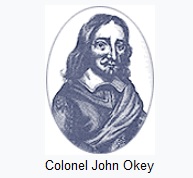
In a destructive 10-year period, all evidence of the following had disappeared:-
King’s extensive brickwork lodgings, in its entirety, was razed to the ground;
Long gallery was obliterated;
Prince of Wales’s state lodgings eradicated;
Prince’s kitchen and wardrobe liquidated;
Numerous suites of offices for state business vanished;
Kitchen hearth wiped out;
Tennis court decimated;
Main stables, barns, riding-house and kennels annihilated.
Parliament began passing Acts as early as April 1649 allowing for the sale of confiscated lands, beginning with Dean and Chapter land, but by July the ‘Act of the Commons Assembled for the sale of the Honours, Manors and Lands heretofore belonging to the late King, Queen and Prince’ was triggered. This meant that just 15 months after Charles I was beheaded his Newmarket Palace was put up for auction to be sold as a package under the title Newmarket Court House, and was offered for sale, valued at £1180. It was purchased, in April 1650, by an alliance of 7 people led by Colonel John Okey for £1722, an amount which was calculated as 14 times the previous annual rent of £123. Captain Christopher Mercer, who initially served as Captain in the Earl of Manchester’s Regiment, later switching to Colonel John Okey’s New Model Army and Regiment of Dragoons, bid for the Newmarket Court House on behalf of Colonel John Okey and his alliance. Major Tobias Bridges, who fought for Parliament in the Civil War, but later switched to serve King Charles II, acted as the Regimental Agent in the sale of the Newmarket Court House. The Parliamentary survey carried out prior to the auction of the Newmarket Court House provides significant detail of the Lot being sold, although some of the old English has been updated for ease of reading.
1. All that brick building commonly called the King’s Lodgings, adjoining to the Tennis Courts (84ft by 38ft), being double built and containing several lodging rooms and other rooms of service, being 3 storeys high, guttered with lead, the chimneys built in the middle of the said building; the many chambers all well floored with sawn boards and matted. With a small 2. Garden amounting to one rood to the south of the buildings, enclosed by a wall, in good repair and not needing to be demolished. (Value £15)
3. All that brick building called the Tennis Court, with 2 other small brick buildings at the south and north ends, equal in size to the Tennis Court, the whole measuring 120ft by 36ft. (Value £13)
4. All the old building called the King’s Kitchen, partly built of brick and partly timber, unconnected to any other building, measuring 40ft by 36ft, in need of repair. (Value £1)
5. The timber building called the Long Gallery, leading from the King’s Lodgings to the Prince’s Lodgings northward, the Gallery measuring 72ft by 32ft, under which are many lodging rooms and offices, all under the same roof as the Long Gallery, and on the west side of the Gallery, divided by a wall, below stairs and above stairs, rooms fit for habitation. (Value £10)
6. All the brick buildings called the Prince’s Lodgings, situated next to the Common Street, being double built 3 storeys high, measuring 70ft by 44ft, with floors covered in sawn boards and mats, comprised 6 chambers below stairs and 6 chambers above stairs, in a very good state of repair and fit for habitation. (Value £20)
7. All the old timber building which runs flush with the Prince’s Lodging, next to the Common Street, measuring 44ft by 26ft, comprised of many rooms and offices downstairs, and sundry rooms above stairs, partly the dwelling of the Housekeeper, Mr Richard Grymes, the whole being fit for habitation but would benefit from some repair. (Value £7 10s)
8. All the timber building called the Pantry, Buttery and Wardrobe, that abuts the Housekeepers lodgings, and runs flush with the King’s Lodgings, measuring 88ft by 16ft, all old and much decayed. (Value £2 10s)
9. All the brick building, complete with turret, called the Prince’s Kitchen, measuring 24ft by 24ft and another small timber house adjoining. (Value £5)
10. The entire list of buildings mentioned above, encompassed by a stone wall on the west, east and south, with the Common Street on the north, with a Garden and Courtyards, passages, lights, waters, watercourses and all commodities. (Value £73 10s)
11. Although all of the land and buildings have been given an estimate, the sellers assess that, were all the buildings to be demolished then materials, including timber, glass, tiles, roofing, lead, stone, bricks and iron would also have a value, and the acre of land (Value 30s)
12. An old, decayed, thatched timber stable, 132ft by 16ft, together with 2 decayed, thatched Barns, 90ft by 18ft, situated with the Church yard on the south and north. (Value 30s)
13. All the new brick building, containing Great House Stables below stairs and accommodation above stairs, with garrets, timber and tiles, 116ft by 40ft. (Value £15)
14. All timber Riding House raised on substantial timber, boarded on one side and one end with red tiled roof, measuring 104ft by 36ft. (Value £2 10s)
15. All brick building called the Dog House measuring 44ft by 28ft, with a brick stable adjoining it, and a Garden of 1 rood, the whole enclosed by a pale and stone wall. (Value £3)
16. All brick building called the Clerk of the Works House, 32ft by 28ft, with a timber Stable adjoining, 21ft by 14ft, and a Garden plot on 2 roods enclosed by a stone wall. (Value £3)
17. A 4 acre piece of arable land, currently ploughed, on the west side of the Clerk of Work’s House. (Value £2)
18. Two areas of pasture land totalling 6 acres on the south side of the Church. (Value £3)
19. Several distinct buildings and Houses are spread over an area of 11 acres called the King’s Closes, close to the Chief Mansion, Courthouse, Common Street, Church and Churchyard. The Dog House and Clerk of Works House are in good repair and not ready to be demolished. (Value £8)
20. All the stone buildings associated with the Brewhouse, 82ft by 60ft, containing 2 distinct, tiled roofs, in a good state of repair and not ready for demolition, fit to be turned into habitable rooms, together with ½ acre of ground on the south end of the Greyhound, and with Jeremiah Gawen’s land and Star Inn to the west. (Value £3)
21. All the brick buildings called the Coachhouse and John Reade’s Smithy and Forge, measuring 56ft by 20ft, in a good state of repair, set in ½ acre of ground. (Value £20)
During the Commonwealth period there is scant evidence of any racing being staged in Newmarket, a ban possibly being in place on religious grounds or because Cromwell did not trust large gatherings of people who could have used the occasion to plot against him. It was not that Cromwell was against racing, as he had been brought up in a family which enjoyed racing. He lived on the Hinchingbrooke Estate, and during his childhood racing was staged on the estate on numerous occasions, and given that James I was a frequent visitor to Hinchingbrooke, he would have attended some of those races. Cromwell enjoyed the breeding side of racing and would have had his own stud, including one at Dinsdale, Yorkshire, but it was his fear of the people rising up against him that led him to act and take draconian measures. State Council meetings on 13th February 1650 and 14th January 1651 both ordered bans on horse racing, while letters were sent to sheriffs and Militia Commissioners instructing them to curtail horse races and cock-fighting, as enemies of the State were using them as a pretence for holding conferences to plot against the State. The only record of a meeting in Newmarket was in November 1652, while after 3rd July 1654 Cromwell made a point of issuing a ban, renewed every 6 months, which lasted until racing regained its popularity only after the Monarchy was restored. On 3rd September 1658 Oliver Cromwell died and was replaced by his son Richard, but his time at the helm was short-lived.
The Restoration of the Monarchy and reign of King Charles II began on 29th May 1660 and with it a new chapter in the history of horse racing in Newmarket. Robert Ford, former 'Keeper of the King's Newmarket Palace II' for Charles I, contacted Charles II with a request to be reinstated as 'Keeper of the relics and ruins of Palaces I & II', a request which Charles II agreed to on 13th August 1660, making Ford custodian of the ruins and royal gardens at 2 shillings per day. One of the most urgent tasks, as far as King Charles II was concerned, was to have the Royal Stables repaired, so in 1661 John Boyspole was appointed 'Surveyor of the Royal Stables', and advanced £800 to carry out the repairs, an undertaking which took more than 2 years. In the early 1660s the stables in Newmarket housed 43 stallions, colts or racers and 31 hunting horses looked after by 43 grooms in total, and ridden by 4 principal Royal jockeys, Peter Alliband, George Horniblowe, William Burgany and John Smith.
Within 2 years of the Restoration Charles was being challenged financially, a problem not dissimilar to the one experienced by his father, and Charles was acutely aware of what had happened to him. A conservative estimate of the amount needed for the upkeep of the Royal Household was in excess of a million pounds, equivalent to £225 million in 2021, but less than the £350 million which is what was actually spent by the Royal Household in 2021, and Parliament was required to impose an extra supplementary tax to accrue this sum. It came up with the Hearth Tax, commonly called the ‘chimney tax’ which it introduced in 1662 and which was designed to tax the rich without affecting the poor. Indeed, some of the exemptions were; inhabiting a house worth less than 20 shillings rent annually, or owning assets valued at £10 or less, and the Tax was not payable by almshouses or hospitals. Furthermore, Smithies and Potters were also exempt, as furnaces and kilns did not count as hearths for the purpose of this tax. It was a carefully considered tax which was dependent on the number of hearths which you had in your house, and was payable at 1 shilling per hearth every six months, so the tax was collected twice a year, on the Feast of the Annunciation (25th March) and the Feast of St Michael the Archangel (29th September). The way the tax was structured did not give much room for loopholes, while over the life of the tax the collection process varied over time. Initially, in the first 2 years it was collected by petty constables, then by ‘chimney-men, and later by ‘Agents for the Hearth tax.’ Whatever the pros and cons of the tax, it did provide a way of assessing the wealth of a town, and Newmarket was no exception. As soon as Charles indicated his interest in racing, and his desire to reinstate a Royal Palace in Newmarket, Noblemen and Gentlemen began to follow suit, each keen to build bigger and better houses in the town which they could use, not as their main residence, but whenever they went racing, and some, like the Duke of Ormonde, James FitzThomas Butler, had as many as 15 hearths. The earliest record of a Newmarket race meeting after Charles was crowned was at the Spring Meeting in 1663 when the opening race, a Match for £100, between the 3rd Duke of Richmond, Charles Stewart, and the 3rd Lord of Suffolk, James Howard, was won by the Duke. Lord Suffolk was one of those Noblemen who owned a house in Newmarket which had 6 hearths.
A pivotal moment in horse racing history, and in the history of Newmarket, occurred in 1665 when, on 16th October 1665, King Charles II issued an Article for a race, the Newmarket Town Plate, for horses carrying 12 stone over the Newmarket Round Course on the second Thursday in October each year. Although there was no Jockey Club at this stage, this is one of the first sets of rules governing a race in Newmarket. It is clear that, at this point in time, there is a Clerk of the Course, a Clerk of the Race, a Treasurer, many Judges, one of whom is responsible for checking the weights of riders.
"This making of bastards great,
And duchessing every whore,
The surplus and treasury cheat,
Have made me damnable poor,
Quoth old Rowley the King,
Quoth old Rowley the King,
At council board,
Where every lord
Is led like a dog in a string''.
On 4th April 1668 King Charles II paid William Bucknell £2000, repaying the amount which William had lent him for purchasing the Earl of Thomond’s house which faced the High Street, and also purchased the Greyhound for £170 10s, giving him further access to the High Street, meaning work was finally able to begin on his Palace once he had appointed a suitable architect. Both of these new acquisitions were sizeable buildings; Lord Thomond’s House had 16 hearths (for taxable purposes) and the Greyhound Inn had 19 hearths. On 14th April Thomas Elliot, groom of the bedchamber, was paid an allowance of £200 for keeping, firing and airing the King’s house, which at that stage could well have been the former house of the Earl of Thomond, for he was a long way from being able to boast a Newmarket Palace of his own, and his choice of Architect, William Samwell, was a surprise. William, son of Anthony Samwell, was born in East Anglia in 1628 and already had Royal connections because his grandfather, Sir William Samwell, was Auditor of the Exchequer to Queen Elizabeth I. In 1663 he was hired by Edward Proger to design Bushy House, the Ranger’s House in Bushy Park, where King Charles II had installed him as Keeper as a reward for his support during the challenging Commonwealth period. Charles II must have liked what he saw, awarding William Samwell the project to design and build him a new Palace in Newmarket rather than use his customary Royal Office of Works. Samwell spent 3 years on his commission, beginning in 1668, and by 1671 he had completed the project, meaning Charles II was able to use Palace III whenever he visited Newmarket, especially on his 2 holiday visits annually. Samwell went on to work for the Duke of Lauderdale on Ham House, and Eaton Hall, Cheshire for the Duke of Westminster, but he died just 5 years after completing his work on King Charles IIs Newmarket Palace. While some were impressed with the overall design, incorporating many original features, boasting 124 rooms, 23 of which were reserved entirely for use by the King, and a further 29 rooms assigned to his illegitimate son the Duke of Monmouth, others were less impressed and voiced their criticism. Cosimo III de Medici, the 6th Grand Duke of Tuscany, whose reign only began on 23rd May 1670, paid a visit to Newmarket in 1671 and remarked that the Palace, ‘did not deserve to be called a King’s residence.’ But who did Samwell take his inspiration from? He is known to have admired the work of John Webb who, in turn, had collaborated with both Inigo Jones on Wilton House, Salisbury, and worked with Sir Christopher Wren when Wren designed Greenwich Hospital. King Charles had commissioned Webb to rebuild Greenwich Palace, with Webb proposing 3 ranges of buildings around a central courtyard, and although the Royals never resided at the Palace it was used by Wren. He also appreciated the work of Hugh May, Paymaster of the King’s Works, who designed Eltham Lodge and Berkeley House in Piccadilly. Both Sir Christopher Wren and Hugh May were paid for work on Palace III; Wren at 8s per day and May at 6s per day. Indeed, it was reported that Charles II thought the rooms were too low and suggested this to Sir Christopher Wren who was quite a short man. Sir Christopher is said to have walked about them with ease, replying, ‘May it please your Majesty, they are high enough’ at which point Charles, who was 6ft 2ins, stooped down to Sir Christopher’s height and crept about in that posture crying, ‘Aye, I think they are high enough’. Samwell, the main architect, was in a position to assess all of the new architectural features which were emerging at that time, and make suitable choices for Newmarket Palace III. His chosen design linked a number of small, square pavilions around a central courtyard, although both the King’s and Queen’s private lodgings were self-contained and approached by separate staircases. Despite the introduction of the Hearth Tax in 1662, Samwell was keen to include a number of fireplaces in corners, which was unusual at that time. Another feature was an octagonal room, and furnishing it would have presented its own challenges.
Between the 8th March and 12th March 1669 the King, Dukes of York and Monmouth, and Prince Rupert are in Newmarket. They travelled from Whitehall to Audley End and Newmarket at a cost of £412 17s 1/2d, as recorded in Samuel Pepys diary, and he also suggested that the visit had originally meant to be 10 to 12 days. The party returned again in mid-April for the Second Spring Meeting when the King resided at the former home of Lord O’Brien, the Earl of Thomond which the King had purchased. Unlike Palaces I and II, the 3rd Palace had no tennis court at this stage, so the King and Prince Rupert travel on horseback to a Court on the outskirts of Newmarket to amuse themselves with a game of tennis. It is during this Spring visit that significant details are provided about the racecourse at Newmarket. ‘The racecourse is a tract of ground in the neighbourhood of Newmarket, (a town of about 200 houses split between Cambridgeshire and Suffolk), which extends over a distance of four miles over a spacious and level meadow covered with very short grass, and is marked out by tall wooden white posts. These posts point out the road that leads directly to the goal to which they continue on for the whole way; they are placed at regular distances from one another, and the last is distinguished by a flag mounted upon it to designate the termination of the course.’ The record then goes on to describe how horses are kept and prepared for their races. ‘The horses intended for this exercise, in order to render them swifter, are always kept girt so that their bellies may not drop, and thereby interfere with the agility of their movements. When the time of the races draws nearer, they feed them with the greatest care, very sparingly, giving them, for the most part, beverages composed of soaked bread and fresh eggs.’ The recorder then notes a race which was staged that day. ‘Two horses only started on this occasion, one belonging to Hon. Bernard Howard of Norfolk, and the other to Sir Thomas Elliot. They left Newmarket saddled in a very simple and light manner after the English fashion, led by hand and at a slow pace by the men who were to ride them. They were dressed in a taffeta of different colours, Howard’s being in white and Elliot’s being in green. When they reached the place where they were to start, they mounted, loosened the reins and let the horses go, keeping them in the beginning so that they might not be too eager at first setting off, in case their strength fail them at the most important part of the race. The further they advanced the course, the more their riders urged them, forcing them to continue at full speed. When they came to the station where the King and the Duke of York were waiting on horseback, with some lords and gentlemen of His Majesty’s Court, they let them pass and set off after them at the utmost speed, which was scarcely inferior to that of the racehorses. English horses are accustomed to run and can keep up with the racers without difficulty, for they are frequently trained for this purpose on another race-ground out of London, situated on a hill which swells from the plain with so gradual and gentle rise that a distance it cannot be distinguished from a plain, and there is always a numerous concourse of carriages there to see the races upon which considerable bets have been made. Meanwhile, His Highness stopped on horseback a little distance from the goal to witness the arrival of the racers, where trumpets and drums which were in readiness to sound applause to the conqueror which, on this occasion, was Sir Thomas Elliot’s horse.’
In addition to a significant number of Noblemen and Gentlemen choosing Newmarket as their country residence, another person who emerged in the town around the time of King Charles II was Tregonwell Frampton. Tregonwell Frampton was born at Moreton in Dorset in 1641, and from an early age enjoyed country pursuits, especially hawking, cock-fighting and hare coursing, although throughout his life his main love was reserved for horse racing. He was born at a time when the earliest shoots of racing were beginning to bloom. Newmarket Heath was cleared in 1660 and this, along with Nell Gwynn, attracted King Charles II to Newmarket. Tregonwell began to attend race meetings on a regular basis, even buying a house in Newmarket, and he acquired ground at the foot of Warren Hill and Long Hill on which he built his first stables in 1670. He would serve a number of Kings and Queens for the next 58 years.
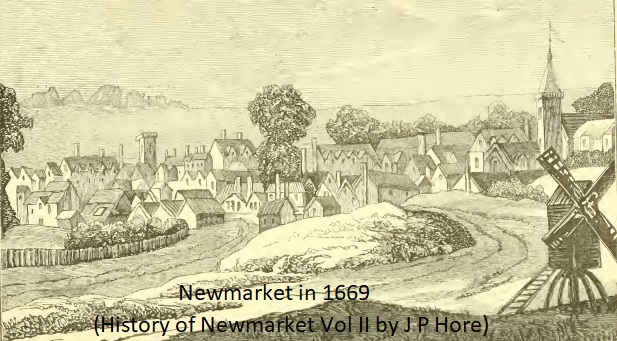
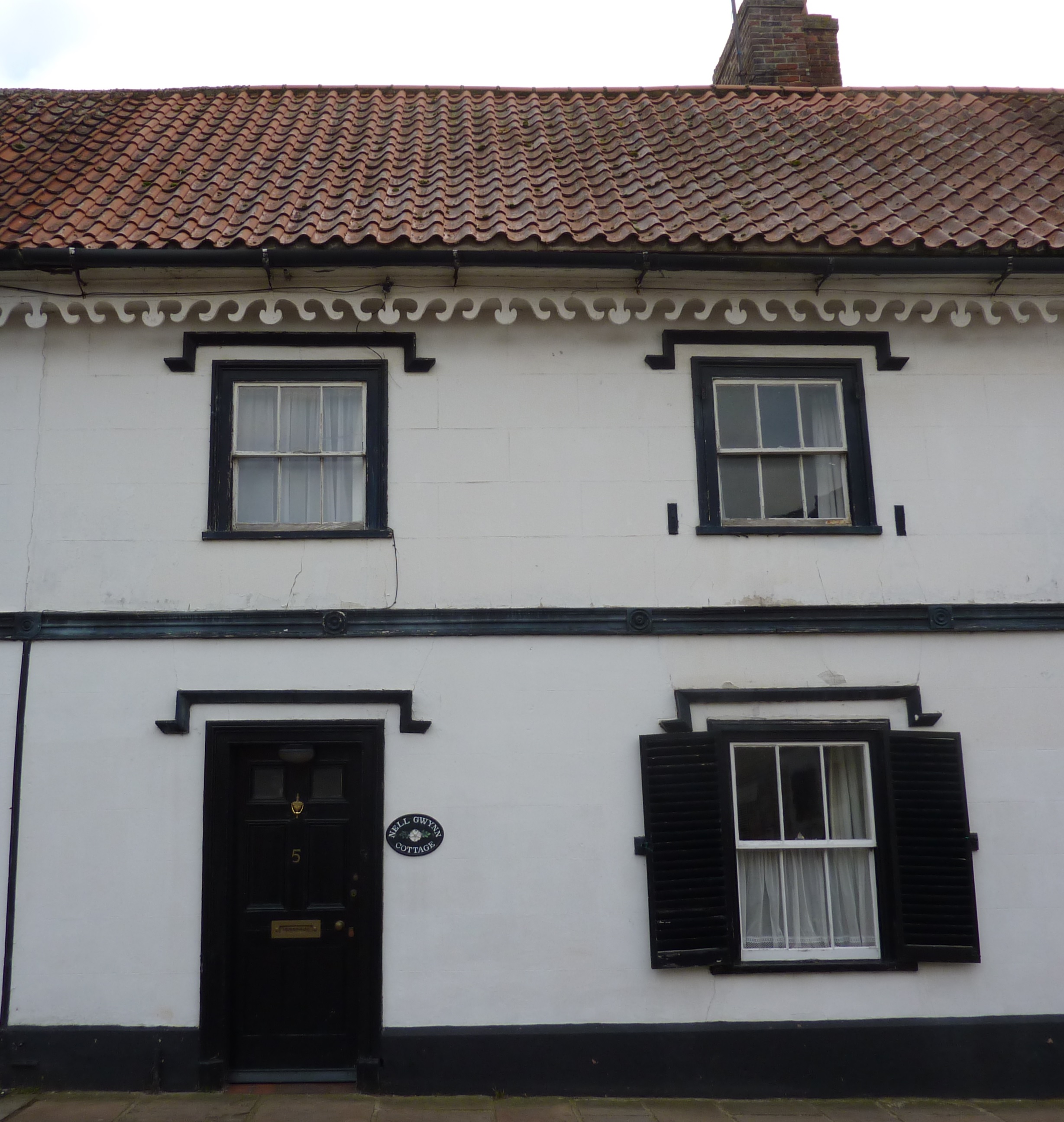
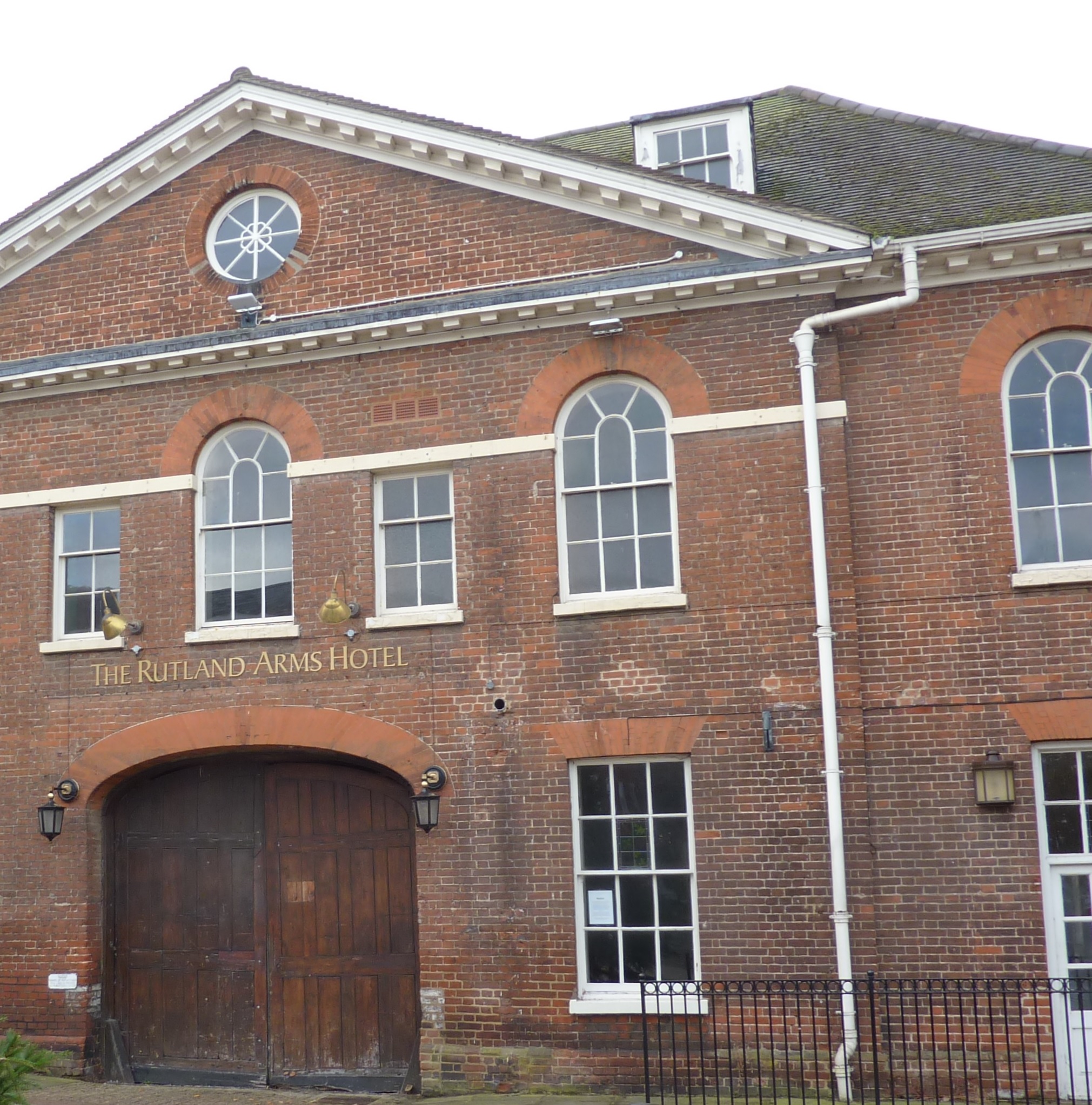
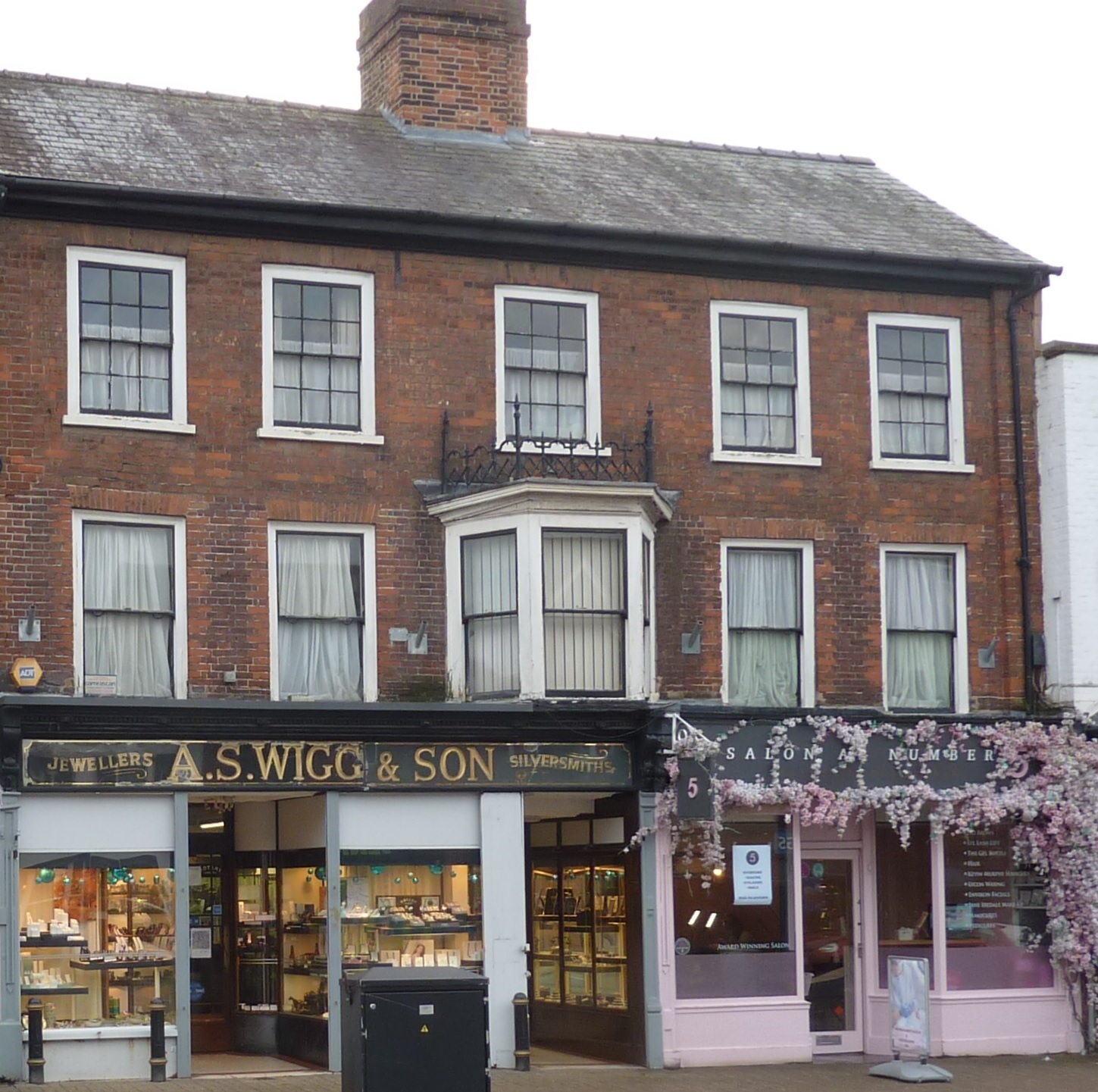
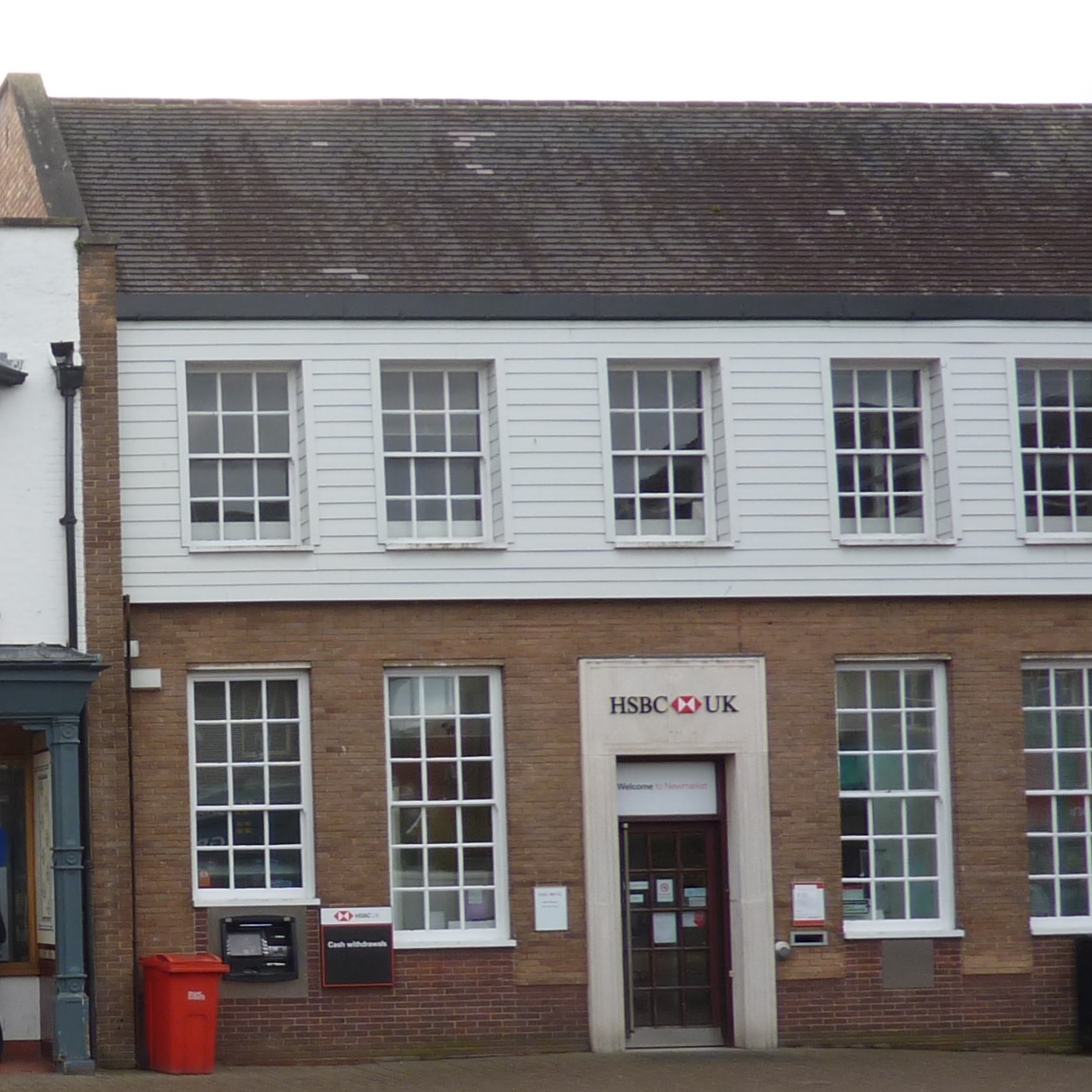
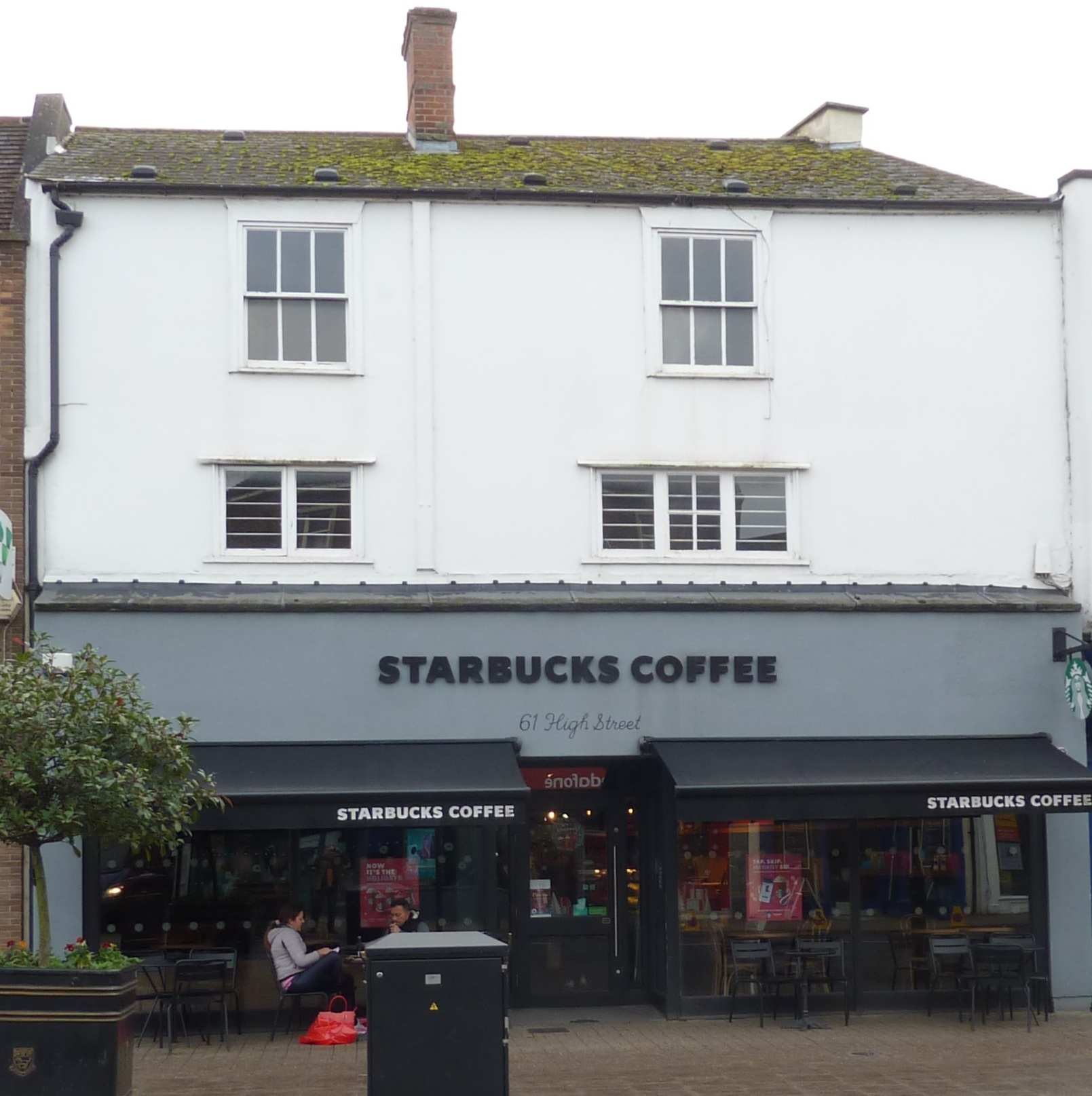
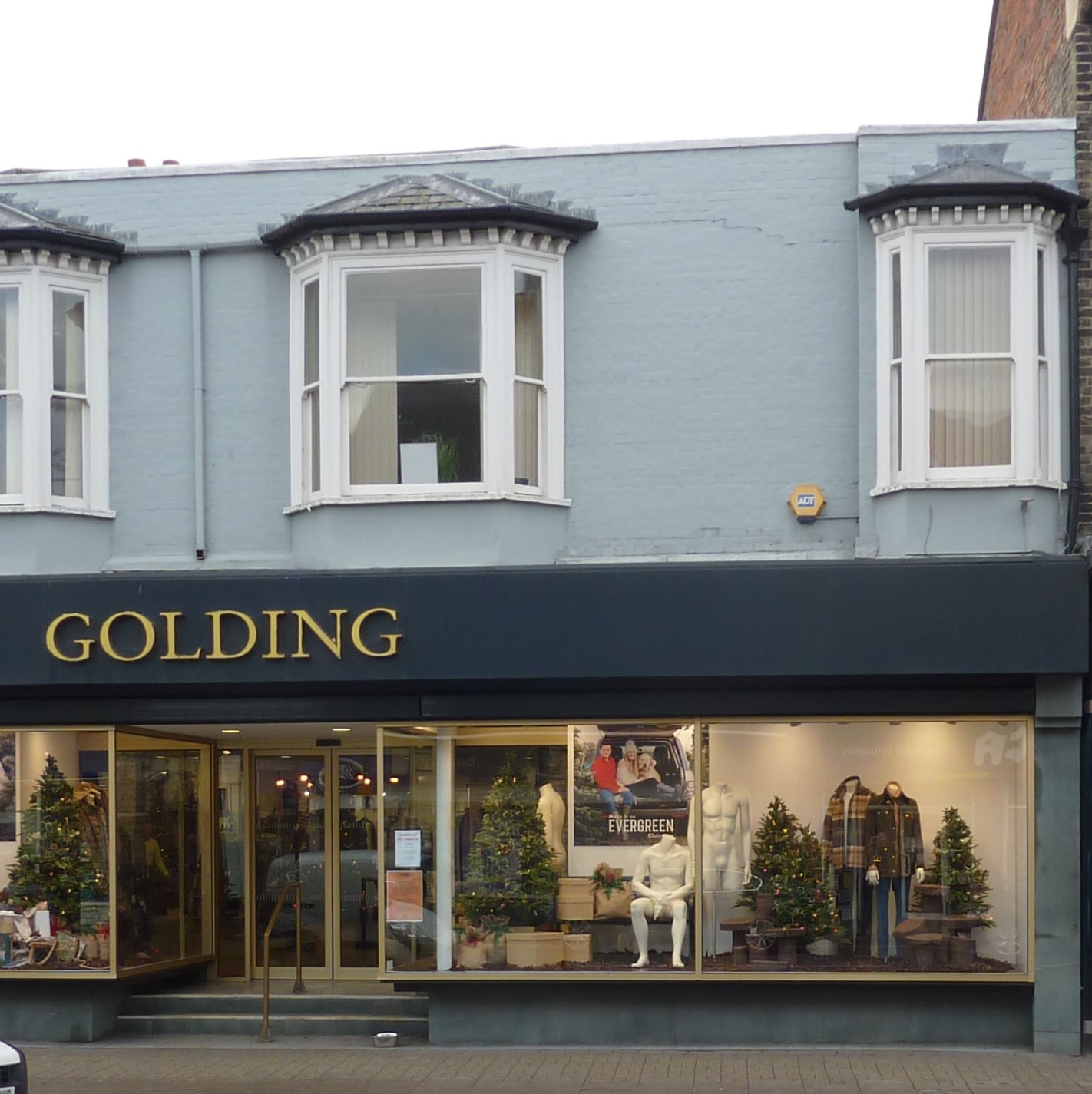
I am very grateful to Tony Bostrom for the map of Palace III shown below.
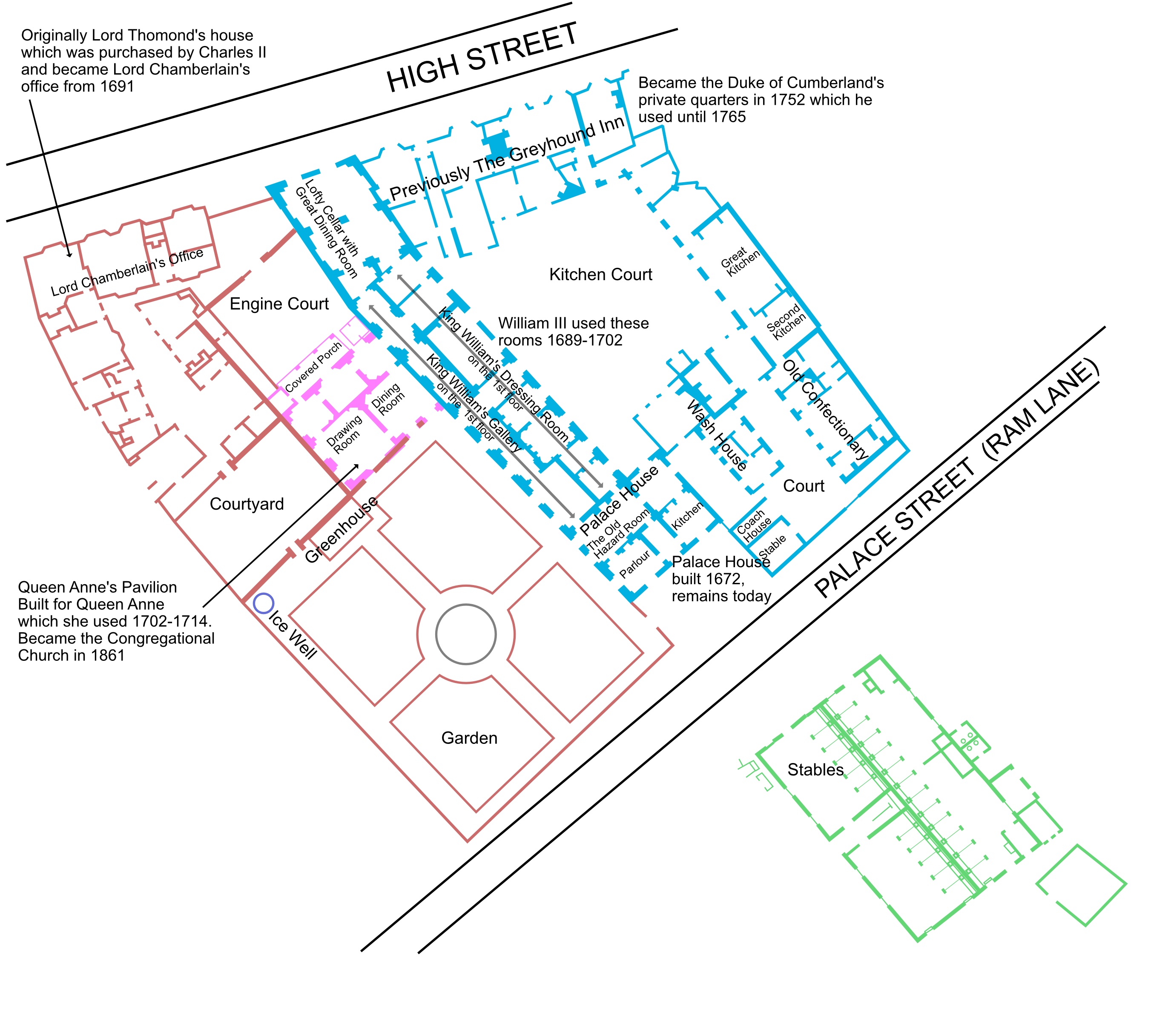
The King and his Court spent much of April 1669 in Newmarket, arriving on 13th April, attending the races, and departing on 28th April. The Royal Party enjoyed their twice-yearly visits to Newmarket again in 1670 and 1671 in both April and October. At the October 1671 meeting a great Match was staged between the King’s Woodstock and Mr Elliot’s (of bedchamber fame) Flatfoot. The Royal Palace, now ready, was insufficient to accommodate all of the King’s guests and Lord Arlington’s Euston Hall was selected to house some of them.
Extract from John Evelyn's Diary with the spelling adjusted where necessary:-
Friday 22nd July 1670
Passing through Newmarket, we alighted to see His Majesty’s house there now new building, the arches of the Cellars beneath, are exceedingly small well turned by the Architect Mr Samuel, (the Architect was actually Mr William Samwell) the rest mean enough and hardly capable for a hunting house. Many of the rooms above had the chimneys placed in the angles and corners, a mode now introduced by His Majesty which I do at no hand approve of, and predict it will spoil many noble houses and rooms if followed, it only does well in very small and trifling rooms, but takes from the state of greater. Besides, this house is placed in a dirty street, without any Court or avenue, like a common Burgers, whereas it might and ought to have been built at either end of the Town, upon the very carpet where the sports are celebrated, but it being purchase of an old wretched house of Lord Tumonds, (Henry O’Brien, 7th Earl of Thomond) His Majesty was persuaded to set it on that foundation, the most improper imaginable for a house of sport and pleasure. We went to see the Stables and fine horses, of which many were kept here at vast expense with all the art and tenderness imaginable.

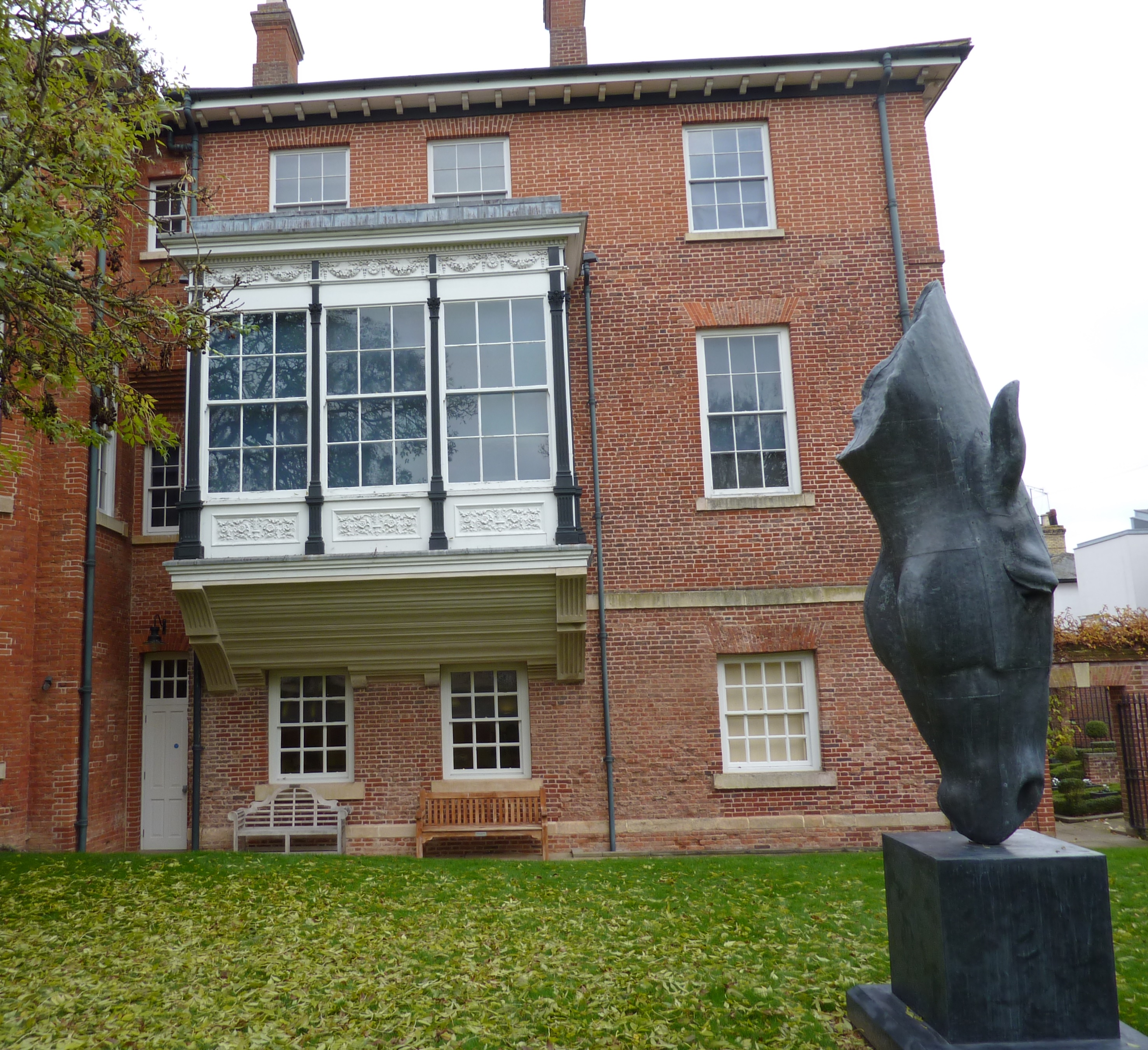
Monday 9th October 1671
We set out on the 9th from Euston in a Coach of 6 brave horses, which we changed thrice, firstly at Bishop Stratford (Stortford), and last at Chesterford so as by night we got to Newmarket where Mr Henry Jermin, nephew to the Earl of St Albans, lodged me very civilly. We went immediately to Court, the King and all the English Gallants being here at their autumnal sports, supped at my Lord Chamberlains, and next day after dinner went on the Heath, where I saw a great Match run between Woodcock and Flatfoot, the Kings and Mr Eliot’s of the Bedchamber, many thousands being spectators, a more signal race had not been run for many years. This over, I went that night with Mr Treasurer to Euston, a Palace of my Lord Arlington (built in 1666 and located 2 miles south of Thetford). Where we found Monsieur Colbert, the French Ambassador, and the famous new French Maid of Honour, Mademoiselle Quierovil now coming to be in great favour of the King. Here was also the Countess of Sunderland and several Lords and Ladies more who lodged in the House with Lord Arlington for nearly a fortnight. His Majesty came almost every second day with the Duke, who commonly returned again to Newmarket, but the King lay here often, during which time I twice had the honour of sitting with him at dinner with all freedom. It was universally reported that the fair Lady Louise Renee de Keroualle was bedded one of these nights and her stocking flung after the manner of a married Bride. I acknowledge she was, for the most part, in an undressed state all day, and that there was fondness and toying with that young wanton; nay, it was said I was at the former ceremony, but it is utterly false. I neither heard, nor saw, and such thing whilst I was there, though I had been in her Chamber and all over that apartment late enough, and was myself observing all passages with curiosity enough. However, it was with confidence that she was first made a Miss, as they called these unhappy creatures with solemnity at this time.
Extract from John Evelyn's Diary with the spelling adjusted where necessary:-
Monday 16th October 1671
Came all great men from Newmarket and other parts of both Suffolk and Norfolk, to make their Court; the whole House filled from one end to the other, with Lords, Ladies and Gallants, and such a furnished Table I have seldom seen anything more splendid, and free. For 15 days at least 200 people were entertained, and half as many horses, besides Servants, Guards, all at infinite expense. In the mornings we went hunting and hawking, while in the afternoon until almost the next morning, cards and dice, Yet I must say, without noise, swearing, quarrel or confusion of any sort. I, who was no Gamester, had often discourse with the French Ambassador Colbert, and went sometimes abroad on horseback with the Ladies to take the air, and now and then to hunting, idly passing the time, but not without more often recessing to my pretty apartment where I was quite out of all this hurry, and had leisure when I would converse with my books, for there is no man more hospitably easy to be with than my Lord Arlington, of whose particular friendship and kindness I had ever a more than ordinary share. What is very surprising is that Evelyn does not mention King Charles II riding in the Newmarket Town Plate on Saturday 14th October 1671, although it is recorded in J B Muir’s New-Markitt Calendar, writing, ‘ The Town Plate was won by an unnamed horse, purportedly ridden by King Charles II, when 4 ran, defeating Mr Eliot, the Duke of Monmouth and Thomas Thynne, winning a flagon of 32 price.’ However, a likely explanation is that Evelyn was at Euston House when the race took place.
Inventory in 1672
In 1671 the first phase of building Palace III was completed after 3 years work, although at this stage the Greyhound remained intact and used as additional lodgings by the Duke of Monmouth. An inventory was carried out in 1672, indicating that there were 124 rooms on the estate, some of which were:-
His Majesty’s own rooms 23
His Majesty’s Offices, Kitchens and cellars 10
HRH the Duke of York 7
Duke of Buckingham 20
(Of these 29 rooms, 15 were in the new building, 3 in the old building, and 11 small brick buildings on their own, possessed by Mr Wacklin and listed as, two rooms each 13ft by 11ft, two rooms each 10ft by 13ft, 4 rooms each with chimneys, 2 more smaller rooms 8ft by 10ft, and an additional 2 garrets.
Lord Chamberlain 5
Mr May 3 small & 3 large rooms 6
Mr Hyde in old building 2
Grooms of Bedchamber 2
Chaplin’s Dining Room 1
Pages of backstairs Dining Room 1
Mr Chiffinch small rooms 3
Gentlemen of privy Dining Rooms 2
Clerk of the Kitchen 1
Master Cook 1
Over the Kitchen 2
Over the stable, one long gallery yet to be completed 4
Over the stable, an additional group of rooms 4
Lodgings in the Greyhound for the Duke of Monmouth:-
Cellar and Parlour 15ft by 15ft
One Kitchen 12ft by 10ft
One small room 7ft by 7ft
On the first floor of the Greyhound:-
One large room 19ft by 19ft
One other chamber 15ft by 15ft
One closet 15ft by 15ft
3 small garrets
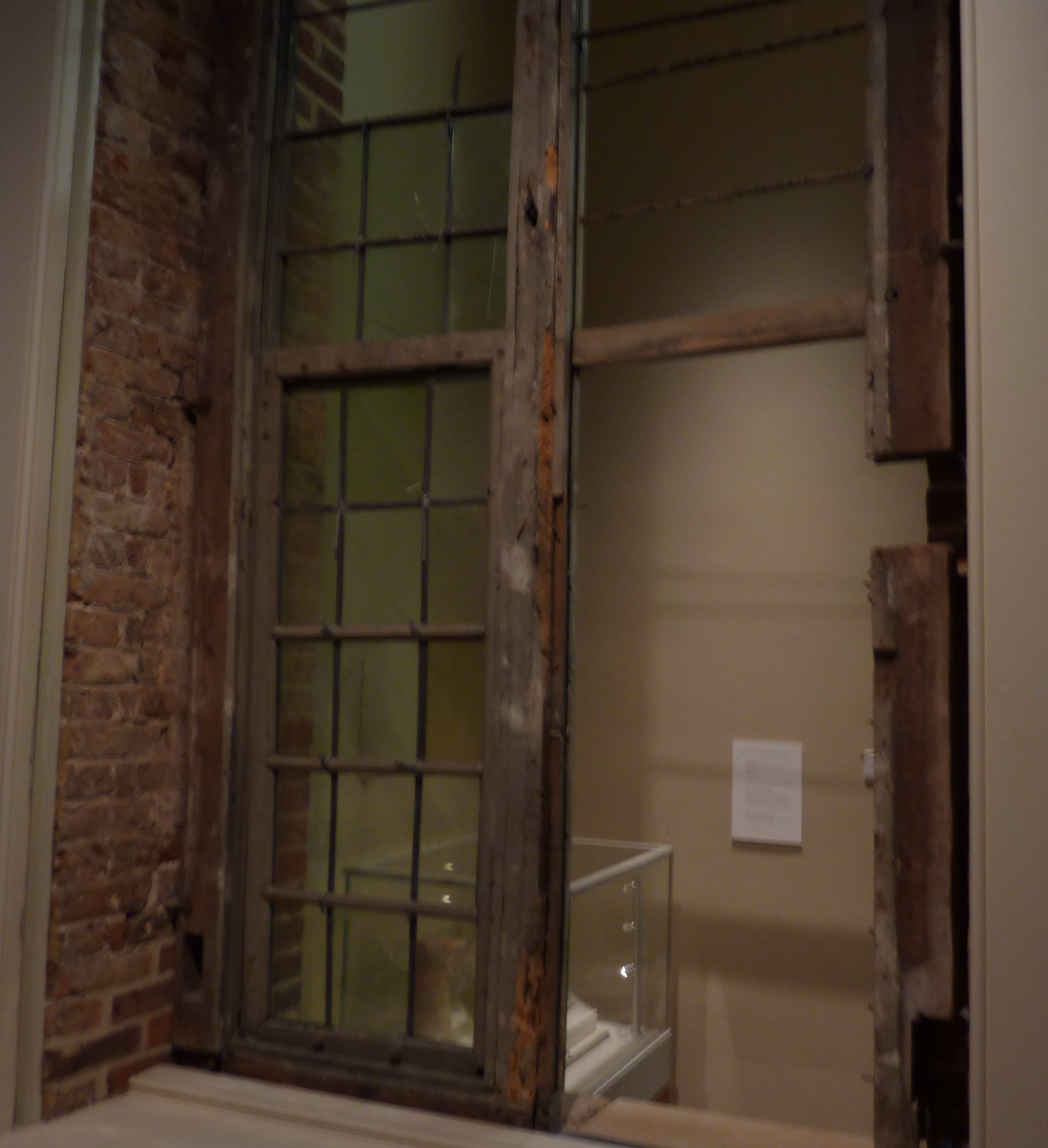
Sash Window
William Samwell was known to favour the use of sash-windows, employing the technique in his designs for Ham House, Richmond, so becoming one of the earliest exponents of this device which did not emerge in this country until about 1670. The new type of window, first devised in France in the first part of the 17th century, was formed of two parts, a glazed wooden sliding frame, called the sash, which was significantly more effective against the weather than previous designs, and a counterbalancing mechanism, but an additional feature incorporated into Samwell’s, and others, designs allowed for the windows to be opened. In Palace III the sash window shown opposite was discovered on the north wall of the present day Palace House, and had been bricked up and hidden from view for some considerable time before being rediscovered in the final years of the 20th century.
Visits 1672-74
Annual, twice yearly stays in the Royal Palace continued in 1672, 1673 and 1674, and whilst in Newmarket in October 1674 the Duke of Monmouth, on behalf of the King, wrote to the Vice-Chancellor of Cambridge University expressing, ‘the King’s displeasure at the clergy wearing their hair and perukes of unusual and unbecoming length. The practice of reading sermons was ordered to be discontinued and, in future, preachers were commanded to deliver their sermons, both in Latin and English, by memory and without books.’ So as not to differentiate between Oxford and Cambridge, a similarly worded letter was sent to the Vice-Chancellor of Oxford.
The March 1675 meeting was a busy one for the King who contested several races, winning some of the more important ones, including the Plate. He was ably supported at the meeting by the Duke of York Lord Arlington, Sir Robert Carr and Sir Joseph Sheldon. Sir Robert Carr made the mistake of crossing the course too early during one of the early Matches, bringing down the long odds-on favourite, Mr Hilton’s Scotch horse, leaving Diamond, the outsider, to win as he pleased leaving many to settle large gambling debts. On St Patrick’s Day a great Match between Lord Montagu’s Lusty and Tregonwell Frampton’s Nutmegge (sic) saw many thousands wagered on the result. Frampton was reported to have bet £900 on his horse which saw off the better fancied Lusty. Frampton was already earning himself a reputation for being a shrewd gambler. King Charles II won the 10th running of the Newmarket Town Plate on 20th March 1675. The event was recorded by Sir Robert Carr the next day when he wrote, 'Yesterday His Majesty rode himself 3 heats and a course, and won the Plate, all fower (sic four) were hard and neer riden (sic well ridden), and I do assure you the King won by good horsemanship'. It is not absolutely certain that this was the Town Plate which King Charles II launched in 1666, especially as it was run in March when he had specified that it should be run on the second Thursday in October. By early 1675 the cost of building Palace III was included in the accounts and, for the period 1675-76, was a modest £229 18s 7 ½ d, but this was only for timber, lime, hair, sand, stone and labour costs. The main initial expense of building the Palace between 1668 and 1671 had already been covered in previous years accounts.
Although Charles is identified as the monarch who established the Royal Plates, which are generally understood to be £100 plates, all the evidence indicates that the Royal Plates during Charles's reign were for lower amounts (£20 or possibly £40 in some instances). And the plates that Charles won in 1671 and 1675 were not Royal Plates as we later come to understand them, but races that were limited to participants from the immediate royal court with a prize offered by the king, rather than a race open to all competitors. Charles II appointed George Villiers, Duke of Buckingham, to be Master of the Horse between 1668 and 1674, followed by Charles’s eldest illegitimate son, John Scott (Fitzroy) Duke of Monmouth from 1674 to 1679. The first Royal Plate, of sorts, had been run at Newmarket on Friday 14th March 1634 during the reign of his father Charles I, whilst during Charles II’s reign 6 Royal Plates, of sorts, were held, 5 of them in Newmarket, while a sixth, on 17th March 1681, was transferred to Burford, Oxfordshire for political reasons, Charles having moved his Parliament to Oxford. Within a year of moving the parliament to Burford there was significant unrest between the Tory Party and the Whigs which festered further when on Monday 11th and Tuesday 12th September 1682 rival race meetings were held in Wallasey, Cheshire and Delamere Forest, about 27 miles apart. The historian Mr J B Robertson wrote about the fixture clash, ‘The Whigs proved the craftier technicians, arranging that a smart animal, the property of the Hon. Thomas Wharton, already entered for the Tory Plate at Delamere, should run in the name of the Duke of Monmouth at the same time of the meeting at Wallasey. Mr Wharton’s horse won the Delamere race easily, while at Wallasey the Duke of Monmouth rode his own horse to victory in the £60 Plate, securing an across the card double for the Duke. On Tuesday evening much merrymaking took place in Liverpool, and after Wednesday’s racing the Monmouth party and the local Whigs returned to Chester in triumph to celebrate the Duke’s dual victory. At the banquet which followed at Mansion House, under the presidency of the Mayor, Lord Derby, Monmouth’s health was proposed and drunk before that of his father, King Charles II. He was arrested as he returned to London and was charged with fomenting rebellion, brought to trial and acquitted on 23rd October 1682. However, the King, who was fond of his illegitimate son, advised him to return to the Continent, although his racehorses continued to run in England under his name.’
In 1676 extensions to Palace III were under consideration on land on the North West part of the King’s Close, annexing a piece of land 200ft by 46ft adjoining Saxon Lane towards the west and the Slaughter House and Churchyard to the North. The land was used to build extra Rooms, Houses and Sheds.
In 1677, after the death of Thomas Elliot, loyal servant of Charles II and Custodian of the Palace, his wife Elizabeth Elliott was appointed the new Palace Custodian, albeit on a reduced salary of £200 per annum when her husband had been paid £300 per annum for the same job. The October 1677 meeting was attended by the King and James, the Duke of York, with both enjoying the racing. However, the Palace was the location for a much more important event, because it was in Newmarket Palace, after the October meeting, that King Charles II met with William, Prince of Orange to discuss his marriage to Princess Mary. The Prince had, at one stage, turned down the offer of marriage, but in October 1677 he finally agreed to travel to Whitehall to discuss the proposition with Mary, who was, after all, his first cousin. He wasn’t the most handsome man Mary had ever met in her life, and she is reported to have cried her way through the marriage ceremony at St James’s Palace on 4th November 1677 by Bishop Henry Compton, but in the end the couple grew to love each other, although the marriage did not produce any children.

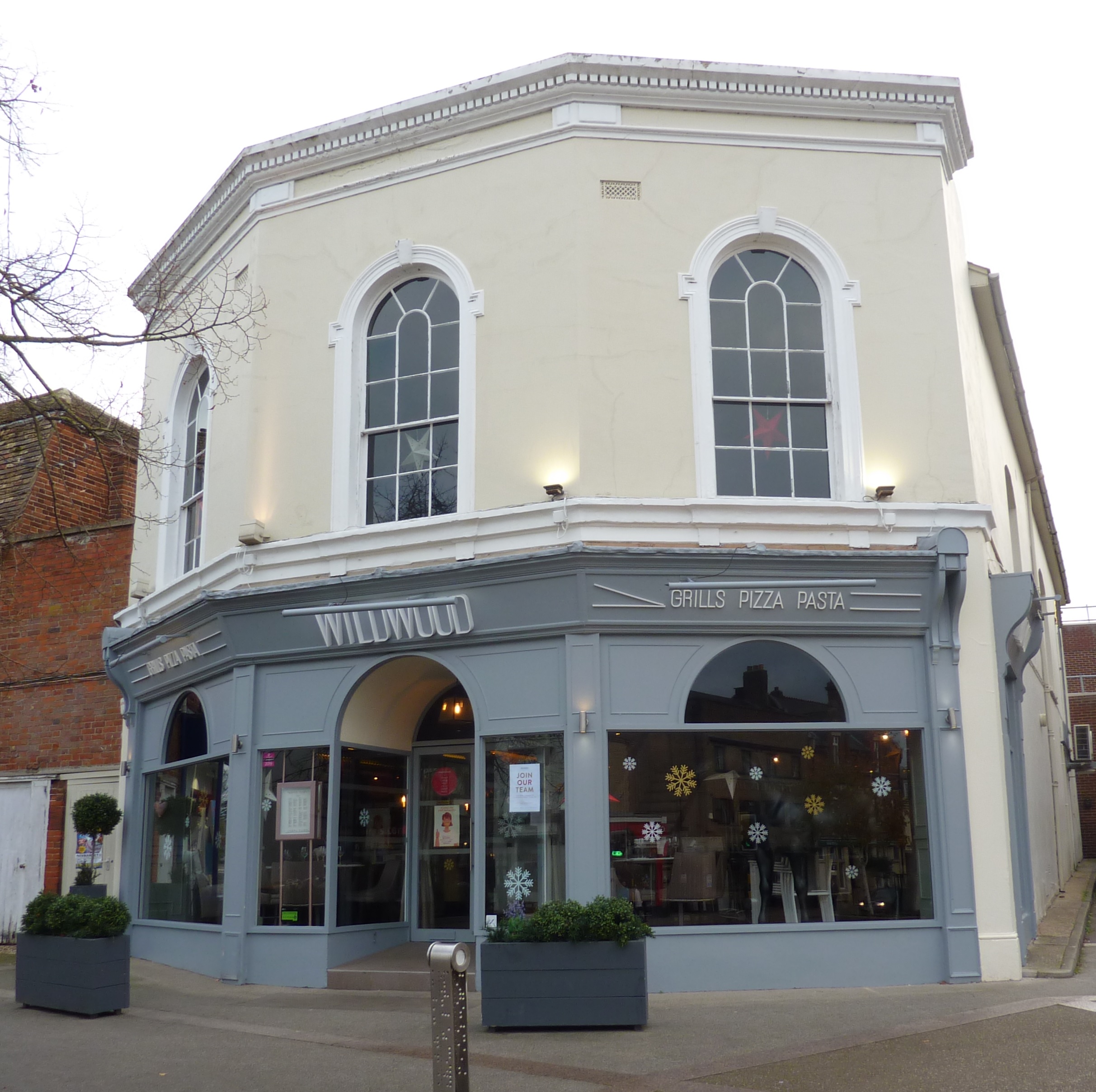
Tuesday 27th April 1680 over the Beacon Course; Mr Bernard Howard’s white legged gelding was matched against Mr Millward’s Second Morning for 100 Guineas.
Wednesday 28th April 1680 over the Beacon Course, Sir Robert Howard’s Crop was matched against Mr May’s Dragon for £200.
On the same day Leadenhills and Postboy were matched over 3 miles for £300.
Thursday 29th April 168 over the Beacon Course, Red Rose and Darcy were matched for £500.
Friday 30th April 1680 over the Beacon Course, Mr Bernard Howard’s Sweet Lips was matched against Mr Bellingham’s Scotch Galloway for £500.
The 1681 meeting at Newmarket was not attended by the King who, instead, transferred his Court and attention to Burford where he was able to go racing. The Oxfordshire town of Burford, on the River Windrush, lies 18 miles of Oxford and staged racing as early as the first few years of the 17th century. The meeting was recorded, not for its quality of racing, but because of a fatal stabbing which took place at the event in September 1620. However, in 1681 a much more widely publicised meeting was staged at the town’s racecourse on Burford Heath. Clearly it had been in the King’s thinking for some time, because an advertisement in the London Gazette of 1680 reported, ‘These are to give Notice, that the Plate the King used to give every Spring at 12 stone Heats at Newmarket, will be run for this year at Burford Heath on 17th day of March next by the same Articles as used at Newmarket’. An interesting fact about the meeting, which was pre-Jockey Club, was that it was to be run according to the same Articles as used at Newmarket. He did return to his Newmarket Palace for the September meeting when the usual stalwarts, Lord Conway, Lord Thomond, Lord Hyde, Lord Halifax, Lord Arlington and a relatively young Earl of Godolphin were in attendance. The Earl of Godolphin, Sidney Godolphin was aged 36 at the time, but became a much more important figure in the history of racing later in life. A mouth-watering list of Matches was issued to tempt a large crowd to Newmarket throughout October, and some extended into December.
Shuffler against Looby £100 over 4 miles
Pet Lamb against Tinker £200 over 6 miles
Mackerel against Ringtail £500 over 4 miles
Robin against White Buttock and Kick-Up £200 over 4 miles
Bob against Traveller £100 over 2 hills and onto the course proper
Bull against Woodcock £300 over 6 miles
Gage against Parker £1002 over 4 miles
Barb against Woodcock £500 over 6 miles
Zhatour against Doubtful £500 over 6 miles
Pearl against Why-Not £500 over 6 miles
Bull against Woodcock £500 over 7 miles (from the 7 mile Ditch to the winning post)
Morgan’s Mare against Tege £300 over 4 miles
Scotch Galloway against Tapster £500 over 4 miles
Chopper against Mr Rowes Gelding and Kick-Up £200 over 6 miles
Post Boy against Dragon £1000 over 6 miles
Dragon against Chubb £500 over 6 miles
In 1682 there was an unremarkable visit in March and a prolonged visit in October, taking in hunting, hawking, racing and visits to Cambridge.
On Thursday 22 March 1683 fire destroyed stables near the market place, aided by a strong wind which saw 66 houses ablaze, causing over £20,000 worth of damage to the town. King Charles II was moved out of the Palace to avoid the smoke and left for London, and, as it happened, this was a stroke of luck for him because he avoided the Rye House Plot assassination attempt which had been planned to coincide with his original date to return to London. However, the experience did leave a mark on Charles, changing his opinion about Newmarket, and causing him to rethink whether Newmarket or Winchester should be the place where he should spend most of his relaxation time. The earliest record of racing in Winchester was in April 1664, although no further details were provided. Records then lapse until a two-day meeting was held in August 1676, starting on Wednesday 26th August with the Winchester Plate over 4 miles, whilst on the Thursday 27th August there was a Contributors Plate. In September 1683 Winchester races became Royal Winchester when King Charles II attended, and by the latter part of the 17th Century races were held annually towards the end of August. There is little doubt that Charles II was minded to abandon Newmarket for Winchester; it was larger, had a Cathedral, was more convenient located and easier to travel to, so what was not to like about Winchester? It is likely that, over the next decade, Winchester would have progressed as a centre for racing while Newmarket would decline. But the King did not have a decade, he had less than 17 months after crowning ‘Royal Winchester’ before his untimely death on 6th February 1685 aged just 54. His last few days were painful, suffering leg ulcers and gout, he was bled, blistered, had an enema and various tinctures to try to save him, all to no avail, for he suffered an apoplectic fit and died shortly afterwards. Whilst there were some conspiracy theories suggesting he had been poisoned, the vast range of treatments he experienced in his final 5 days could have been the reason for that claim. However, with almost 350 years of medical advances since then, it is likely he died of Uraemia or Bright’s Disease, in short, kidney dysfunction. What is not in doubt is that, because of his death so soon after transferring his racing interests to Winchester, Newmarket was saved, with so many Noblemen and Gentlemen having valuable properties in the town, and enjoying the racing experience which the town provided, they were in no mood to move away once Charles II had died. Then, as now, Newmarket remained the Headquarters of British racing.
King Charles II did return to Newmarket in March 1684 to reside at his Palace, walking through the town at 10 o’clock in the morning, after which he enjoyed some time at the Royal Cock-pit until he went racing at 3 o’clock, returning to the Cock-pit at 6 o’clock.
To give him his due, Charles II was a skilful rider who maintained his interest in racing until his death on 6th February 1685, having partnered the winner of the Town Plate in 1671, and possibly for a second time in 1675. He rekindled the public’s interest in racing after the racing famine during the Commonwealth years, and he put Newmarket on the map as the Headquarters of British racing.
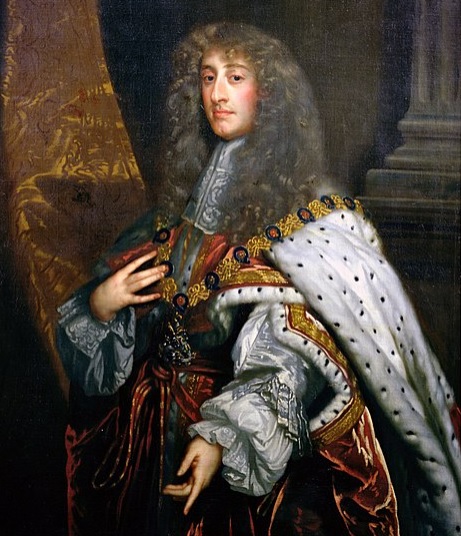
After his death on 6th February 1685 Charles II was replaced by James II, former Duke of York, who was less keen on racing, and had other more pressing concerns, with trouble on at least three fronts threatening his ability to remain in power, not least religious tolerance, because James II was to become the last Catholic Monarch of England. The Duke of Monmouth led an unsuccessful rebellion, the Monmouth Rebellion, against his uncle between February and the summer of 1685 and was tried and beheaded on 15th July 1685. That did not end James II’s troubles; on 10th June 1688 his son, James Francis Edward, was born a Roman Catholic and became heir to the throne in front of his half-sister Mary, although within 6 months of his birth his father was forced into exile in France to be replaced by Mary, and her husband William of Orange, both Protestants. Despite James II not being as interested in horse racing as his predecessor, meaning racing was always going to occupy a backseat during his short reign, it may well have continued in Newmarket without a Royal presence, although there is no evidence of this until 1688, even though many of the Noblemen who had invested in glamourous houses in Newmarket would have wished to still make use of them. One could take a positive from James II’s lack of interest in racing because it meant that he did not continue to pursue the project which Charles II had initiated, developing Winchester as his chosen headquarters of racing. The proposed Royal Palace in Winchester was not completed and the land was later used for barracks. James II never visited Newmarket or resided in Palace III throughout his 3-year reign, although he clearly had a desire to maintain a degree of Royal involvement in the sport, because he appointed Tregonwell Frampton as his ’racing adviser’, building stables on the Gog Magog Hills near Wandlebury, just 15 miles south west of Newmarket and 6 miles south east of Cambridge, where the founding stallion, the Godolphin Arabian, was subsequently buried after its death in 1753. Frampton had already established himself in Newmarket in the latter years of Charles IIs reign, bringing off some audacious gambles, and he rented a property in the town from James Smyth who, at that time, was landlord of the Royal Oak. To some degree, Palace III was left to deteriorate, with precious little spent on it during James IIs time. In the period 1686-87 £56 7s 10d was spent on glass, glaziers, lime, sand and oak rails, mere cosmetic repairs carried out under the guidance of Clerk of Works Henry Winstanley. The bill for 1687-88 was a fraction more at £63 0s 6d, but was only for sundry works.In April 1688, during the Easter week celebrations, a contribution race restricted to the ‘nobility and gentry’ was staged when each contributor had to put up £100 towards a Plate, a significant increase on all but one previous contribution Plate, the exception being a similarly priced contest at Quainton Meadows, near Aylesbury in Buckinghamshire organised by Thomas Wharton. Later in 1688 a second Plate, advertised for £80 a throw, was staged in October 1688, and an additional Plate for £60 a time the next year, with so called ‘gold tumbler’ races staged in April and October for the next two years.
Details of the marriage of William of Orange and Mary, aged just 15 at the time, are given earlier in this article, taking place at St James’s Palace on 4th November 1677 led by Bishop Henry Compton. During their ‘joint reign’ just a single Royal Plate was held. A positive festival of racing took place in Newmarket in April 1689, with all engaged horses compelled to spend at least a month prior to the races in Newmarket, although the King did not attend the meeting. On the 18th, 22nd and 24th April there were Matches, after which, on 25th April a £100 Contributors Plate was staged, followed the next day by a £60 Plate. In late September and early October 1689 William III paid his first visit to Newmarket races after his marriage, but he was already canny enough to appreciate the knowledge and skills possessed by Tregonwell Frampton, shortly afterwards appointing him Keeper of the Running Horses. On Monday 30th September the King, surrounded by a whole host of Noblemen, travelled to Newmarket from Hampton Court, in time of a race meeting on Tuesday 1st October when a Gold Tumbler race of £100 was staged for gentlemen over 3 heats, each carrying 12st. Whilst in the town, acclimatising himself with Newmarket life, he hunted, went to the Cockpit, raced and gambled in the evening. He would have not had fond memories of his gambling exploits, playing a game called Basset, or hocca, which was introduced to England by a croupier named Morin and described as the most notorious multi-player card game in England in the late 17th century. The game centred around a banker or ‘Talliere’, who had an enormous advantage, but also needed a ‘pot of gold’ in the centre of the playing table from which he would pay winners, serving the less wealthy gamblers spread around the table. The Talliere would have one deck of cards per 4 punters, while each of the punters would have a suit of 13 cards, a different suit for each player. Punters then turn, face up, as many of their cards as they wish to gamble on, placing as large a stake as they like on each of their chosen cards. Once all punters have placed all of their bets the Talliere turns up the bottom card from his large deck, e.g. a Jack, and wins half of the amounts from any punters who have bet on a Jack, adding the winnings to his central pot of gold. The Talliere then turns up 2 more cards, e.g. an Ace and a Five, paying all punters who have bet on Ace as much as they have staked, but withdrawing all of the stakes of punters who have bet on five. Those punters who bet on the Ace can, if they so wish, withdraw all of their original stakes and winnings, or just their winnings, leaving the original stake on the Ace to play on, this being called a Paroli. Play continues with the Talliere revealing two more cards, the first a winner for punters, the second a loser for punters. If a Paroli card subsequently wins again for the punter then they are paid at odds of 7/1; if they still choose to leave their original stake in play it is called a Double Paroli, and if it wins for a third time it is paid out at odds of 15/1; Triple and even Quadruple Paroli’s are paid at 30/1 and 60/1 respectively. The game finishes when the Talliere deals their final card, winning all stakes on that final card. It was on this game that, between 11th and 20th October 1689, King William III lost £4000, equivalent to £1.1 million in 2021. It is very unlikely that the Royal racing horses were trained in the vicinity of Palace III as they probably had not been built by then, and even if they had they would have stabled hunters and racehorses, without any clear delineation between the two. It is also unlikely that they were trained at Wandlebury, the choice of James II and later owned by Tregonwell Frampton, but more likely to have been at the ideally placed Heath House Stables, superbly located at the foot of Warren Hill and one of the earliest Newmarket Racing Stables. Financial accounts indicate that between 1689 and 1690 £137 12s 8d was spent on Palace III, predominantly on sundry repairs, tiles, bricks, glaziers, ironmongers and general labourers. In 1690 the ‘Great Plate’ was scheduled to be contested on 30th April, but was postponed until 6th May. A Gold Tumbler race was staged on Friday 31st October 1690. The next year another Gold Tumbler race was held on Wednesday 22nd April 1691, whilst the year after, specific mention was made of the King having a recreational House on the Cambridgeshire side of the town, particularly used for hunting and horseracing. In the 3 years leading up the death of Mary no large projects were undertaken on Palace III, and expenses amounted to £78 7s 1d, £91 11s, and £129 0s 1d respectively.
After the death of his beloved wife Mary on 28th December 1694, aged just 32, William was keen to extend his interest in, and influence on, racing. Richard Nash comments’ ‘It is not Charles II, but William III, who established the value of a Royal Plate of £100 as we come to understand them, and who subsequently expanded the number of Royal Plates. He does that in 1695, in conjunction with a Royal Visit to Newmarket at a time, following the death of Mary, when some of those who had supported him in 1689 were considering recalling James from exile; there is a clear link between the value he sets on the Royal Plates with that Noblemen and Gentlemen's Contribution Plate subscription of 1688. And this is also linked to his creating at the same time the post of Keeper of the King's Running Horses for Tregonwell Frampton, who effectively serves as a "vice regent for racing." Charles had been active in bringing the court to the turf; William wants to position himself as a proper successor to Charles (rather than a usurper of James), but he also wants to cultivate those supporters of protestant monarchy by proxy. During the rest of his reign and the reign of Anne, there is an effective royal sponsorship of the sport, but one that operates more by proxy through the figure of Frampton than through the mechanism of the Club.’
There were a number of unusual things about the King’s visit to Newmarket in October 1695, not least that Mary was no longer with him. The first was that he arrived in the town on the evening of Thursday 17th October and throughout his stay he was guarded by 3 men out of each Company of Guards who all marched to Newmarket to perform their duties. The second was that the Town Plate was run on Saturday 19th October, meaning it was probably a King’s Plate for £100 rather than a continuation of the race instigated by King Charles II and first run in 1666, and was won by the King’s horse, trained by Frampton, defeating a solitary opponent ridden by the Earl of Scarsdale. The third was that there was a £60 Contribution Plate on Thursday 24th October for Gentlemen riders, but they were set to carry 11st rather than the customary 12st. The fourth was that the conditions of the race specifically precluded a horse named Headpiece. But who had the authority to preclude runners, given that there was no Jockey Club for at least another 20 odd years? After leaving Newmarket in late October, the King travelled via Althorp Park, Northamptonshire, which at that time was owned by Robert Spencer, and today is known more famously as the Estate where Lady Diana Spencer is buried. The Althorp Estate passed to 2nd Earl of Sunderland, Robert Spencer when he was just 2-years old, on the death of his father who was killed at the First Battle of Newbury on 20th September 1643. The House the King stayed at is not the one shown opposite, which was painted by Johannes Vosterman in 1677, since Robert built the current day House in 1688. No major building projects were performed on Palace III in the early years following the death of Queen Mary; in 1695-96 the expenditure was £103 9s 5d; in 1696-97 it amounted to £254 8s 10 ½ d; in 1697-98 the total was £146 11s 7d, while in 1698-99 the sum was £254 13s 5 ½ d.
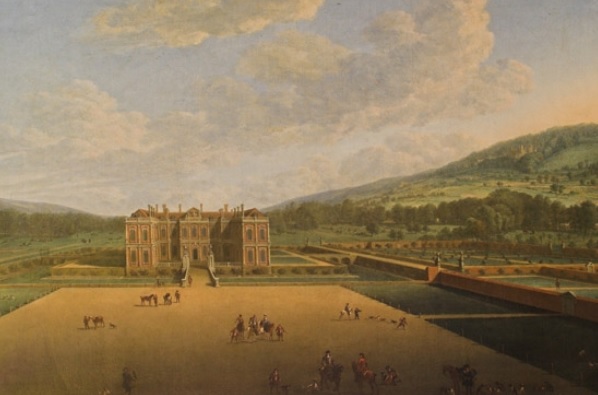
On 1st April 1698 King William III left Whitehall for Newmarket and was joined by Prince George of Denmark who he often did not get on well with. They were joined in the town by a great crowd of nobility and gentry ready for what was billed as being one of the greatest meetings ever seen at Newmarket. He arrived on Monday and spent much of his time hunting and the other diversions which the town had to offer, while on 7th April he watched the £100 King’s Plate in which the brewer, Sir John Parson’s horse was victorious. There then followed an exciting Match which saw Mr Row’s Quainton defeat Mr Harvey’s Hoboy for 200 Guineas over 4 miles. As one would expect, there is a high degree of correlation between the members of the nobility in attendance of the King at this meeting and the early Members of the Jockey Club some 20 years later. His Majesty was attended by the Dukes of Devonshire (William Cavendish), Grafton (Charles Fitzroy), Richmond (Charles Lennox), Somerset (The Proud Duke, Charles Seymour) and St Albans (Charles Beauclerk), the Earls of Albemarle (Arnold Joost Van Keppel), Argyle (Archibald Campbell), Burlington (Richard Boyle), Essex (Algernon Capell), Jersey (Edward Villiers), Kingston (Sir Robert King), Macclesfield (Thomas Parker), Marlborough (John Churchill), Orford (Edward Russell) and Orkney (George Hamilton), and the Lords Godolphin (Sidney Godolphin), Lucas (Thomas Lucas) and Ross (William Ross). This was reported to be the greatest number of Gentry ever assembled at Newmarket, and over a period of almost a month, they were entertained by a series of races which engaged some of the finest racehorses of their generation. On Sunday 10th April 1698 the King attended the same church as King Charles II had done a generation beforehand, which was probably St Mary’s Church, rather than All Saints, as St Mary’s was regarded as the Parish Church at that time. The sermon was preached by a Fellow of Pembroke College, Cambridge, Mr Crossing, while the Duke of Richmond was given the honour of carrying the sword. The King remained in Newmarket until 15th April, staying much longer than he had anticipated because he liked the place so much and found it peaceful and relaxing. He was joined by the French Ambassador on 14th April, the pair watching the races and dining together at the Palace, and some of those present witnessed some heavy gaming in the evening when a certain Mr Boucher suffered heavy losses. The month long card included:-
Thursday 7th April 1698 HOBOY (Mr Harvey) beat QUAINTON (Mr Rowe) 200 Guineas Match over 4 miles
Friday 8th April SNAIL (Lord Wharton) beat Bay Horse (Lord Sherwood) by forfeit of 100 Guineas over 4 miles
Friday 8th April CRICKET (Mr Frampton) beat PEACOCK (Lord Ross) for 100 Guineas over 4 miles
Monday 11th April STIFF DICK (HM The King) beat CARELESS (Lord Wharton) for 500 Guineas over 5 miles
Monday 11th April PRIMROSE (Lord Sherwood) beat CREEPER (Mr Maynard) for 400 Guineas over 4 miles
Tuesday 12th April LOOBY (Duke of Devonshire) beat LOBCOCK (Mr Harvey) for 100 Guineas over 8 miles
Tuesday 12th April HOG (Mr Boucher) beat YELLOW JACK (Lord Godolphin) by forfeit for 500 Guineas over 4 miles
Wednesday 18th April COLCHESTER (Lord Wharton) beat DARIUS (Lord Ross) first time round, but then was beaten in a second run of the 200 Guineas race over 4 miles
Saturday 23rd April TURK (HM The King) on offer at 3/1 beat SPOT (Lord Carlisle) for 500 Guineas over 4 miles
Thursday 28th April CRICKET (Tregonwell Frampton) beat Grey Horse (Mr Lister) for 100 Guineas over 6 miles
Wednesday 4th May DARIUS (Lord Ross) beat SPANIARD (Mr Rowe) for 200 Guineas over 4 miles
Wednesday 4th May Unnamed Gelding (Captain Chapman) raced against Unnamed Gelding (Mr Whitherams) for 200 Guineas over 6 miles
The King obviously viewed his 1698 venture to his Newmarket Palace to be so important that certain rooms had to be ‘sumptuously furnished’. In his own lodgings was a Crimson damask bed, chairs, stools, screens, window curtains (probably to the great window which still remains today), a looking glass, tables and stand, with the lot costing at least £600, equivalent to £110,000 in 2021. Even the Grooms of the Bedchamber spent £300 on sheets, trunks (not the swimming kind), bedcases and blankets. A further £600 was spent on furnishings to the room where the reception of the Ambassadors was held.
The King must have enjoyed his Spring 1698 visit so much that he repeated the experience in 1699, leaving Kensington at 8am on Tuesday 11th April, stopping for lunch at The Crown Inn, Hockerill at mid-day, and arriving in Newmarket by 8pm. He was in time for the King’s Plate of £100 on Wednesday 12th April which saw Mr Bruce’s horse win both heats to defeat 3 other contestants. He remained in the town for 10 to 12 days.In October 1699 a new Subscription Race was introduced, to be contested on the first Tuesday in October for the duration of the Subscription. It was valued at £100, with horses carrying a burdensome 14 stone, believing that it would ‘encourage the breeding of strong and useful horses’. However, despite having at least 6 runners at the meeting, the King did not attend as his attention was fully occupied at Hampton Court Palace where the Stud and Gardens were being completed. Indeed, the list of Royal expenses for 1699 was £4987 2s, which was paid jointly on the Palaces at Hampton Court and Newmarket, although the vast majority of this would have been spent on the Stud and Gardens at Hampton Court. It is worthwhile noting that the Earl of Portland, who oversaw all Royal Gardens at that time, was paid an annual salary of £2600 while, in contrast, Robert Ford, Keeper of the King’s Newmarket Palace Gardens, was paid £36 10s, and Elizabeth Elliot, widow of Thomas Elliot, was paid £200 as Housekeeper and Wardrobe Keeper at Palace III. The desire to develop a stronger, swifter, more robust breed of horse was interesting because it was around this time that the Byerley Turk became a prolific stallion, one of the 3 founders of the modern Thoroughbred breed. He was born circa 1680 and lived until about 1706. The Godolphin Arabian, another of the founding three, was born in 1724 and died in 1753 to be buried at Tregonwell Frampton’s ‘old stables’ at Wandlebury, while the most important of the 3 founding sires, the Darley Arabian, was born in 1730, so 1699 was well before the era of the modern thoroughbred.
As the century turned William III had little to do with Newmarket except issuing a warrant in March 1701 for the improvement of 90 pole of road connecting Newmarket with Mildenhall. In early 1702 he fell off his horse, Sorrel, broke his collarbone and suffered complications before developing pneumonia which he died from on 8th March 1702. His sister-in-law Anne became Queen on his death.
William died on 8th March 1702 to be replaced by Queen Anne, famous for the part she played in Ascot’s history, but she also made frequent use of Newmarket’s Palace III, her bedroom and quarters being located in the central part of the Palace compound known as Queen Anne’s Pavilion. It was here that she met with the Keeper of the King’s Running Horses, Tregonwell Frampton, who by this stage had already served Charles II, Queen Mary and William III, and he now looked after the racing affairs of Queen Anne. She was credited with launching the course which is best known today for the Royal Ascot meeting, but during her reign there were also 46 Royal Plates, held on various racecourses throughout the country, up to the time of her death on 1st August 1714, and she had at least two runners, both unplaced, in Royal Plates at York. In 1706 Robert Ford was Keeper of the Royal Gardens at Newmarket for which he was paid £36 per annum, while Thomas Walker was Palace Housekeeper at £200 per annum. William Clayton was paid the princely sum of £166 for building a Rubbing House in the Palace Stables on the opposite side of Ram Lane to Palace House. Also in 1706, on 16th April Mr Sandover, a carpenter, was assigned the task of moving the forge, coaching Houses and rooms above the coaching houses, to a different part of the Palace Estate for which he was paid £300. The buildings ‘hid the prospect of viewing the country from the bedroom windows in Her Majesty’s Pavilion’, so they had to go. Clearly, Anne was as keen on orange as her brother-in-law and cousin William III, for on 10th July 1706 she paid £1136 to Peter Hume, Yeoman of the Removing Wardrobe to refit her bedroom and dressing room. In her bedchamber she had an orange-coloured damask bed, 3 wall hangings, 2 arm chairs, 4 stools with cases, 2 large window curtains, a valence and corniches with orange coloured silk Arras lace, a case rod and 4 large case curtains of orange coloured shalloon. Also, in Her Majesty’s Dressing Room there were 4 pieces of blue damask hangings, 2 arm chairs, 6 stools, 3 pairs of window curtains, 3 valence and 3 corniches trimmed with blue silk Arras lace. Towards the end of her reign the Duke of Somerset, for so long the Master of the Horse, submitted his final account before being replaced, a bill for £4444 for stable and stud expenses at Newmarket and Hampton Court for the final 3 years. After the Queen’s death on 1st August 1714 Ascot went into a period of hibernation to mourn her, and she was replaced by George I.
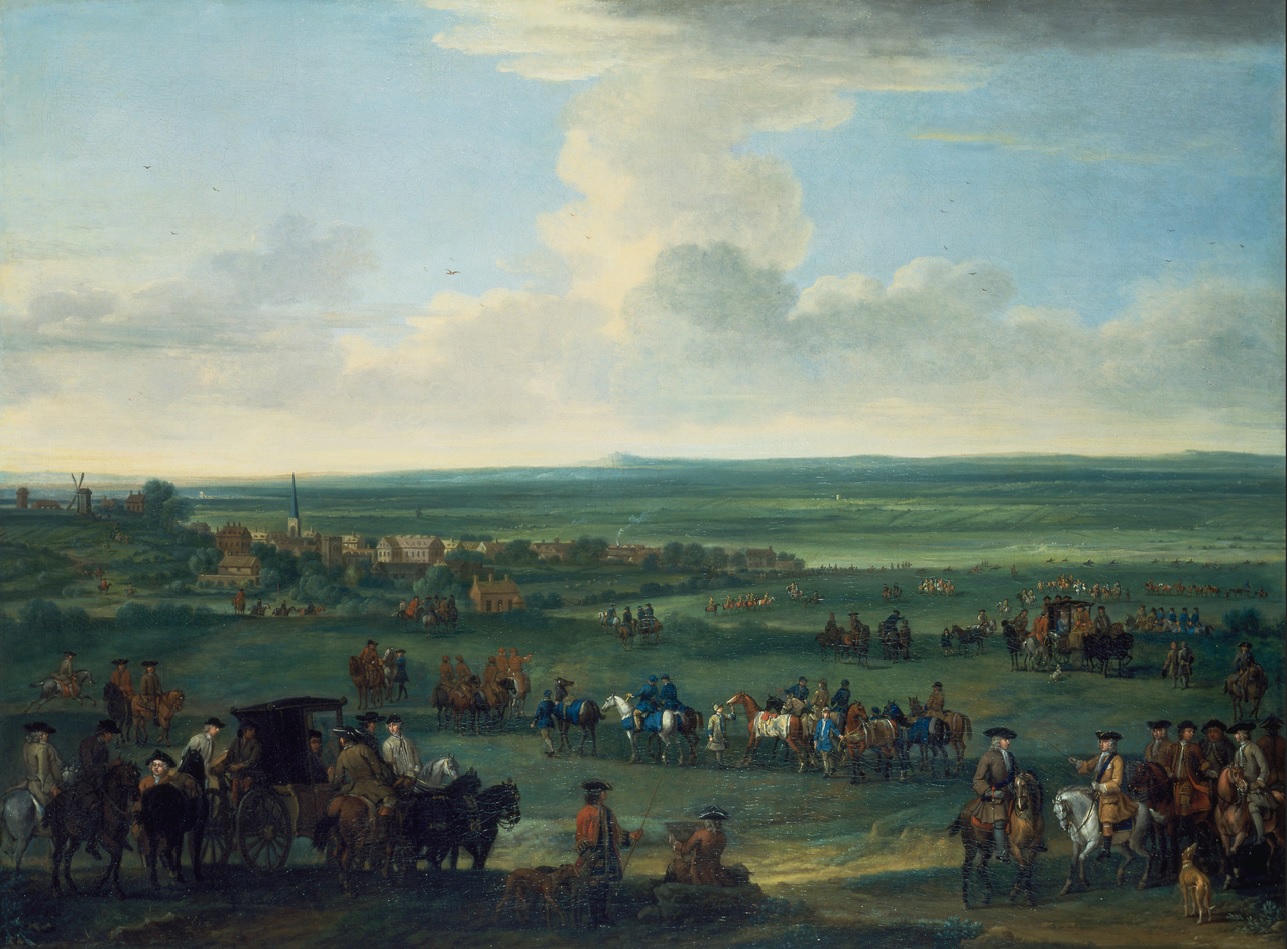
The new race, in its early years called the 'Noblemen and Gentlemen's Contribution Purse', was a single 4-mile race for horses under six years of age, carrying 9st, with subscribers committed to a 5-year programme. The inaugural running of this new Purse took place in October 1717 and lasted until 1721, with a second phase between 1722 and 1726, later phases became known as the October Stakes. The race, restricted to subscribers, was similar to the Jockey Club Plates of a generation later which were restricted to Jockey Club Members. Although the subscribers had not, at this stage, formed a Jockey Club in name, many of them were likely founder members of the Jockey Club which existed by 1729. Another important idea which George I initiated was to commission his Clerk of Works, Thomas Fort, to carry out a survey of Palace III, proving invaluable today in clarifying the layout of both Palaces II and III. Although during Cromwell’s time the land on which Palaces I and II had stood was sold off, there must have been some system in place to bring the land back under Crown control, for in July 1721 the 6th Duke of Somerset, Charles Seymour, obtained a lease from George I of the land, on the Cambridgeshire side of the town, where the former Old King’s Palaces had once stood, situated next to the principal street (High Street) containing a frontage of 115ft. The sale specifically did not include the coach house, forge, or the house then in the possession of Tregonwell Frampton, Keeper of the Running Horses. It did include 2 parcels of land on the King’s Closes, about 9 acres approximately, located near the back part of the leased piece of land. The lease was designed to run for 31 years, from 1721 to 1752, at an annual rent of £30 to be paid quarterly to the housekeeper of Palace House. Without being a regular presence in Newmarket, George I had managed to maintain a Royal interest in horse racing and cement Newmarket’s place as the Headquarters of English racing.
George II, born George Augustus in a Hanover Palace, Germany around 30th October 1683, was the son of George I and Sophia Dorothea of Celle, and was given the title of Prince of Wales when his father became King. When his father died in Osnabruck on 11th June 1727, and buried in Hanover after a funeral which his son did not attend, George Augustus became King and elector of England, although in truth he had little influence over the running of the country which was really controlled by Parliament. George II was not a great supporter of horse racing, spending little time at his Palace in Newmarket, although he did attend the races in 1728 soon after being crowned. Well before he was crowned many Dukes, who became early Jockey Club Members, had training facilities in Newmarket, and therefore their own accommodation, but they would have desired quarters to meet like-minded, wealthy noblemen and gentlemen in the Town to discuss training methods and share ideas. In the early days in Newmarket they met at the Red Lion before preferring more imposing, palatial surroundings in which to meet, and there can have been few more striking places than part of the Palace. Part of the Palace had been leased to the 6th Duke of Somerset, Charles Seymour, known as the Proud Duke, in 1721 for a 31-year period, but he did not survive to the end of that lease as he died on 2nd December 1748. On his death the lease passed to his daughter by his second marriage, Lady Frances Seymour, who was married to the Marquis of Granby, John Manners. The Marquis, who Robert Black could find no evidence that he was a Jockey Club Member, allowed his splendid premises to be used as a meeting place for Jockey Club meetings, whenever they were available, from 1752 onwards. On other occasions they would have met at William Deard’s Coffee Room, with nearly 200 subscribers by the 1751 season. Tregonwell Frampton died soon after the new King was crowned, so George appointed Thomas Panton senior as Master of the King’s Running Horses to replace Frampton, later appointing J Turner on 6th November 1739 to be Keeper of the Royal Stables at Newmarket on £4 per annum. The early years of his reign marked the emergence of the Jockey Club around 1727, the growth in the number of Royal Plates (at least 561 Royal Plates during his reign), and the time when John Cheny started to record and publish results in his Racing Calendars. However, it was also a period of tension both at home and abroad which coincided with a dip in interest in horse racing. In the period 1739 to 1748 there was tension in Europe and, up to 1742, Britain had a direct conflict with the Spanish. The War of Jenkins' Ear, a conflict between Britain and Spain, lasted from 1739 to 1748, although major operations were finished by the end of 1742. The incident was caused by an event in 1731 when Robert Jenkins, captain of a British merchant ship, was confronted by the Spanish coast guard who boarded his ship, and as arguments became more and more intense a Spanish sailor cut off Jenkin's ear. After 1742 the conflict was not ended, but was subsumed into a prolonged Europe wide conflict called the War of Austrian Succession which was not settled until the Treaty of Aix-la-Chapelle in 1748. While the bulk of the British Army were otherwise engaged in active service on mainland Europe fighting the War of Austrian Succession, Charles Edward Stuart felt that the time was right to regain the British throne for his father, James Francis Edward Stuart, the 'Old Pretender'. The Duke of Cumberland, son of George II, would certainly not have had time to pursue his hobby of horse racing between 1739 and 1746 as he is credited with ending the so-called Jacobean Rising. The Duke of Cumberland, Prince William Augustus, youngest son of King George II, initially joined the Navy in 1740 aged just 19, but within a year he became Colonel of 1st Regiment of Foot Guards in the British Army. In December 1742 he was appointed a Major-General, and by 1746 he earned the nickname 'Butcher Cumberland' for putting down the Jacobite Rising at the Battle of Culloden. However, once he had sorted out the Scots, and the War in Europe had been settled by the Treaty of Aix-la-Chapelle in 1748, the Duke of Cumberland was able to pursue his interest in horse racing. He spent a considerable amount of time at Palace III, especially after a significant programme of refurbishment and refurnishing had taken place in his private quarters on the site of the former Greyhound Inn. He was a Member of the early Jockey Club, the first Royal to become a Member, well before the formerly recognised date of the founding of the Jockey Club in 1750, and was also a sufficiently successful owner to own Marske, sire of the great Eclipse, who won a Jockey Club Plate over the Round Course on 8th May 1754 from Python and Brilliant, before going on to win a 300 Guineas Match against Ginger. Such was his love of horse racing, and delight in Newmarket, that it is believed he resided at Palace III and attended race meetings every year from 1753 until his death in 1765, and deserves the credit for re-installing Newmarket to the centre of English racing much more than his father, George II, did. In the early part of 1760, the Duke's Stand was built opposite the Old Betting Post. about 2 furlongs from the Beacon Course winning post. In the latter years of George IIs life, with sight loss in one eye and suffering partial deafness, he could not be said to be in the best of health, dying of Aortic dissection on 25th October 1760, aged 77, and was succeeded by his grandson crowned George III.
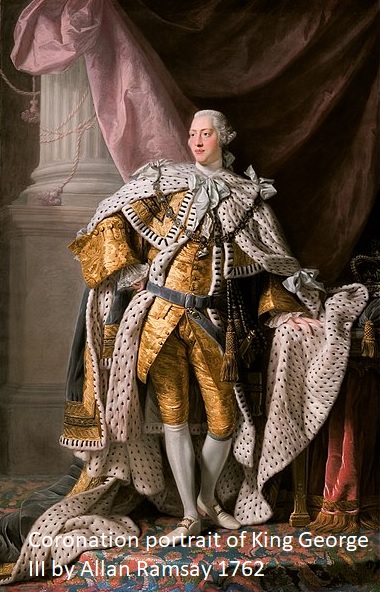
In May 1764 the Prince of Mecklenburg Strelitz, Charles Louis Frederick, Queen Charlotte’s youngest brother, resided at Palace III, travelling to Cambridge with the Duke of Ancaster, and was awarded an Honorary Degree of Doctor of Law by the Vice Chancellor. He attended the races at Newmarket on 14th May 1764, probably cheering on a Royal winner when the grey horse Rocket won the opening race, running in the name of Thomas Panton, but probably owned by King George III. Later that year, in October the Duke of Cumberland was in residence at Palace III for the entirety of the October meeting, attending the races every day, although he had to be accompanied by his two principal surgeons, Serjeant Ranby and Mr Andrews. A highlight of the meeting took place on the Friday when the Duke’s horse, King Herod, ran a Match for £1000 against the Duke of Grafton’s Antonius. It was reported that over £100,000 (£20 million in today’s terms) was wagered on the race, and despite Antonius being sent off the odds-on favourite, King Herod prevailed by a neck. In October 1765 the Marquis of Granby, who spent a considerable amount of time at Palace III, welcomed the Prince of Brunswick to the Palace, entertaining several members of the Nobility at the same time. The Duke of Cumberland’s Selim was one of the stars of the meeting that October, winning a race and a valuable Match, although it was to be one of the final victories witnessed by the Duke who died in London on 31st October 1765. The next year the King paid a visit to his Newmarket Palace, announcing in June that he would need his Palace to be made ready for his visit and, at the July meeting, he received the Dukes of York (Prince Edward of York and Albany) and Gloucester Prince William Henry of Gloucester and Edinburgh). The main beneficiary of the July 1766 meeting was the Politician Robert Shafto who won 4 races, all of which would have been seen by the Duke of York. Within a year the Duke was dead, aged just 28, while Robert Shafto became much more famous for the North East English Folk song and nursery rhyme ‘Bobby Shafto’s Gone to Sea’.
In October 1768 the Palace was used by the King to entertain His Danish Majesty, the King of Denmark Christian VII, inviting the Dukes of Bedford, Grafton, Ancaster and Northumberland to join the celebration, along with the Lords Leicester and Oxford and Sir Charles Bunbury, newly elected Jockey Club Member who later became perpetual Jockey Club President of the Club founded in 1727. At Newmarket’s October 1768 meeting the King may have won the 100 Guineas Sweepstake on 5th October with his unnamed bay colt, although it ran in the name of Thomas Panton. While the King employed Thomas Panton, the Prince of Wales certainly made use of the Newmarket trainer Frank Neale, although it is uncertain whether the trainer was based at Palace House Stables except for the period 1780-83. He was a public trainer who was very successful, training the 1788 Epsom Derby winner Sir Thomas (SR 1953) for the Prince of Wales, but was also responsible for a further 10 classic winners. In 1785 the Prince of Wales purchased the 1783 Epsom Derby winner Saltram (SR 2032) well after it had triumphed at Epsom. He bought the colt in late 1784, and it raced in his colours at the 1785 Craven Meeting, finishing second to Dungannon before winning a 200 Guineas Sweepstake over the Abingdon Mile, beating Lord Clermont's Cantator. Saltram was then retired to the Prince's private stud.
In May 1784 the King gave directions for Palace III to be thoroughly repaired and made ready to accommodate the Prince of Wales. Since the death of the Duke of Cumberland in October 1765 Palace III had not been used as frequently, so was in need of repair. The Prince, 21 years old at the time, was clearly excited by the visit, wishing to cement his links with the town, and he wanted to mark the occasion by a special race called the ‘Prince’s Stakes’. He decreed that it should be a New Sweepstake for 3-year-old colts and fillies, with a refreshingly new format, 30 subscribers each subscribing 100 Guineas, with the 30 horses randomly divided into 3 classes, 3 races of ten horses per race, with the winner of each class facing a run-off for the purse at the next meeting. Was this his bid to stamp his mark on racing history by creating a 3-y-o race at Newmarket which, at this stage, was lacking a Classic race some 8 years after Anthony St Leger had devised the St Leger at Doncaster, fully 5 years after an estate leased by Lord Derby was immortalized in The Oaks, and a year later lord Derby himself had the most famous Classic of them all, The Epsom Derby, named after him. Whilst the format would have been ideal for the present time, with ante post prices on the initial 30 entrants, a draw by lots into the 3 classes adding further spice to the event, and anticipation high for the final race of 3 horses, in the Prince of Wales’s day it proved challenging to organize and they had to deviate from their original format. The first Prince’s Stakes did not take place until March and April 1785, and the outcome can be seen by clicking here. The Prince could not have foreseen what was to happen in 1791, although the Prince’s Stakes did continue for a few years afterwards until it was replaced in 1797 when the Oatlands Stakes and a similar subscription race for 2-year-olds. But ultimately the 2000 Guineas in 1809 and the 1000 Guineas in 1814 became Newmarket’s Classics races. The Prince had invited the Duke of Chartres to accompany him to the races in 1785 and to reside at the Palace for the duration of the meeting. The Spring meeting was billed as the most glorious since the Duke of Cumberland’s death, and it was hoped that the Prince’s Stakes would give new life, spirit and vitality to the turf, and the town of Newmarket, which had experienced a period of decline through a scarcity of cash and a general rage for private play. It was not long before the Prince of Wales was in dispute with a number of Newmarket people on the turf, notably Sam Chifney, after the well-publicised Eclipse affair in 1791, and he began to reduce his interest in racing, especially in Newmarket, although in September 1797, after Palace III had been little used for a number of years, newspapers reported that it was under repair, although they were ‘ignorant of whom the residence was intended.
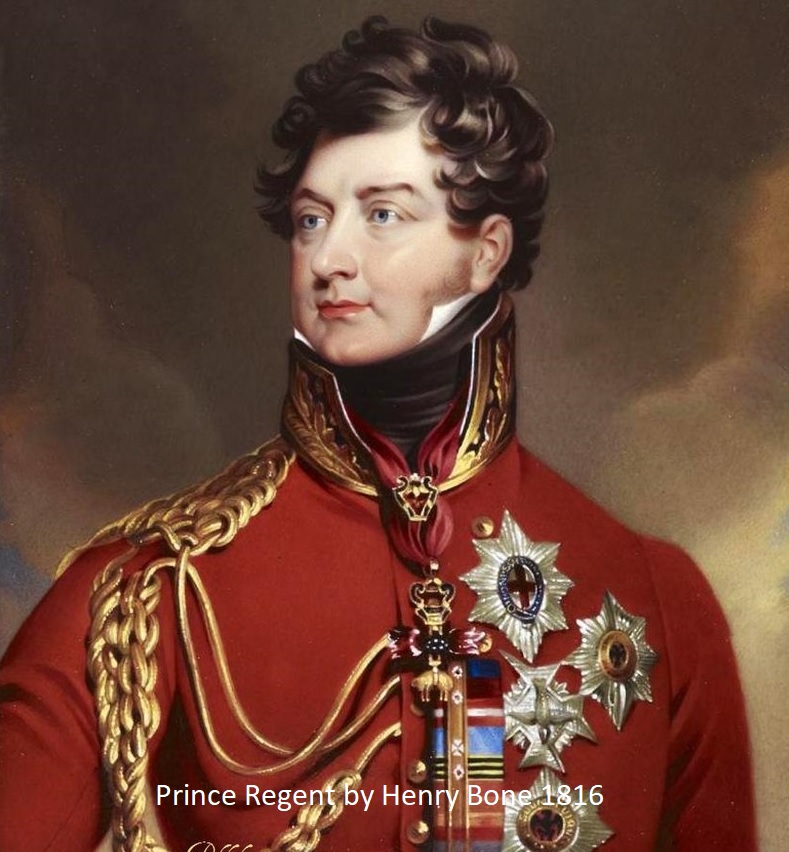
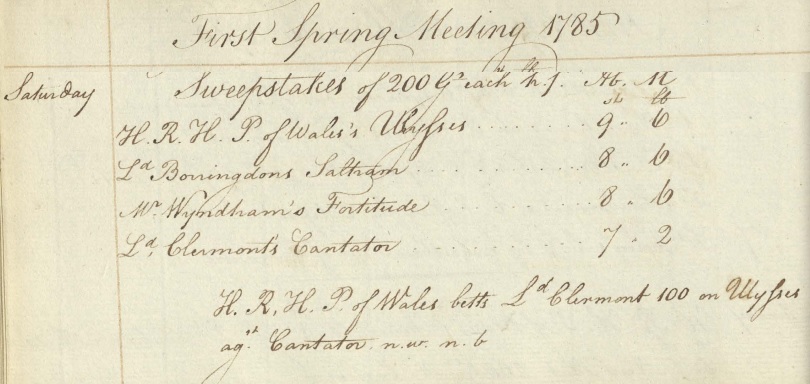
The Prince of Wales’s Match Book contained Newmarket Spring Meeting results, followed by Epsom and Ascot Heath comments, but there then followed intriguing details about a meeting the Prince supports at Uppark, Sussex. The meeting was a relatively new meeting in the grounds of Uppark House, owned by Sir Matthew and Sir Harry Fetherston, and the Prince is prepared to take 4 of the 13 subscriptions available. In the actual 1785 race, staged on Friday 22nd July over 2 miles, it was Sir Harry Fetherston’s Epaminondas who won both heats, and therefore the prize, defeating the Prince of Wales’s Nottingham, Lord Grosvenor’s Racer, Sir Harry Fetherston’s second string Rinaldo, Mr Delme’s Kitty and the Prince’s second string Ascot.
Question 6 King's Plates run in Ireland were quick to adopt a present day structure of races, reducing the age of horses allowed to run, the weight they carried, the distances they raced, less reliance on horses owned by nobilty, and the move away from heats to a single race. Did this impact on the Crown's decision to abandon its Palaces in Newmarket?
Newmarket was most highly favoured by the Royals when it came to distributing Royal Plate money, being awarded 3 annually, more than any other English or Scottish racecourse. At that time no Welsh racecourse was deemed sufficiently prestigious to host a King’s Plate of 100 Guineas, even though Haverfordwest first raced on 16th September 1742 and had their results recorded in Racing Calendars, while Cardiff (31st July 1782) and Swansea (August 1790) had later start dates but were denied Royal Plates. The 3 Welsh racecourses operating today were launched well after the Crown had given up ownership of Newmarket’s Royal Palaces, Bangor opened in 1859, Chepstow in 1867 and Ffos Las on 18th June 2009. Despite being so highly regarded, Newmarket was slow to adapt to change, offering the same programme of 2 His Majesty’s Plates over 4 miles in April, one for 6-year-olds carrying 12st over 4 miles, and one for 5-year-old mares carrying 10st over 4 miles, and a further King’s Plate in October over 4 miles. As a consequence, they invariably had small fields, and whether through choice, design or some other factor at play, frequently a walk-over would present the 100 Guineas prize to some Duke or Nobleman. They did not reduce the distance, the weight, the entry age, the time of year until 1801. In the meantime, the Curragh was prepared to experiment with all of the above factors in order to maximise the appeal of their Royal Plates, the list below indicating just how readily they changed entry conditions.
1739 September; Any horse carrying 12st over 4 miles
1739 September; Mares carrying 10st over 4 miles
1753 April and September Royal Plates
1756 April; Mares carrying 8st 7lbs over 4 miles
1756 April; 5-year-old Irish bred horses carrying 10st over 4 miles
1757 April; 4-year-olds carrying 8st 7lbs over 4 miles
1758 April, June and September Royal Plates
1760 April, June and September; 4-year-olds carrying 9st over 2 miles
1761 April; 4-year-old mares carrying 9st over 2 miles
1761 April; 4-year-old mares carrying 8st 7lbs over 4 miles
1761 June; 4-year-old Irish bred horses carrying 8st 7lbs over 2 miles
1761 June; 5-year-old carrying 9st over 2 miles
1767 June; Fields of 16, 7 and 7 at the Curragh, Fields of 4,6 and 1 at Newmarket
1768 3-year-olds carrying 8st over 3 miles
1769 5-year-olds carrying 9st over 3 miles
1770 April; Fields of 9, 5 and 17 at the Curragh, Fields of 4 and 5 at Newmarket
1771 June; 4-year-olds carrying 8st 7lbs over 2 miles
1787 September; 3-year-olds carrying 8st over 2 miles
1789 April; Weight for age over 4 miles
1795 September; 3-year-olds carrying 8st over a mile
FINALLY, on Thursday 1st October 1801 Newmarket made a small change to their race conditions, making His Majesty’s 100 Guineas Plate a Weight for Age race over 4 miles.
To view the complete results of all 4335 Royal Plates (king’s Plates; His & Her Majesty’s Plates) CLICK HERE
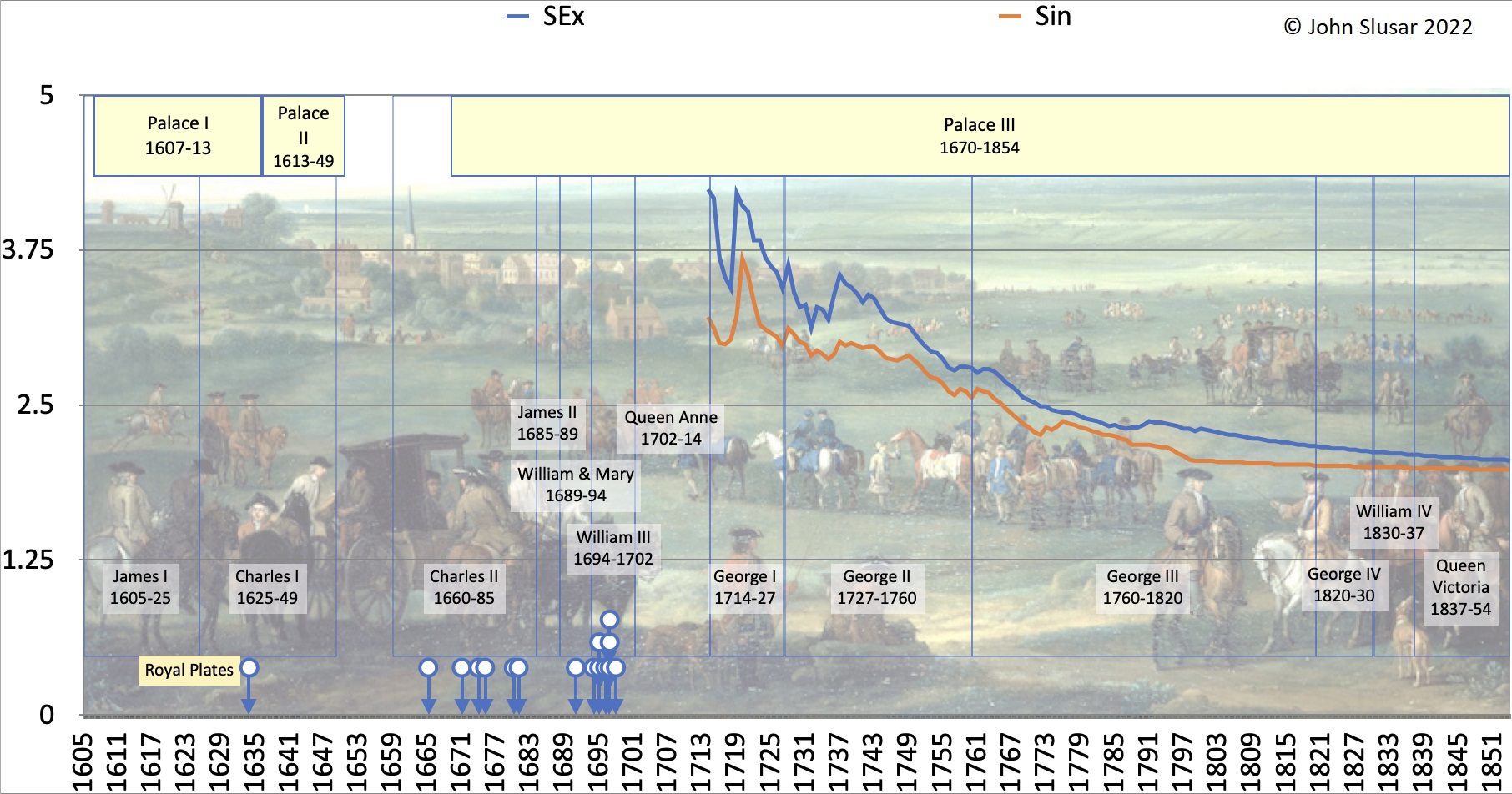
Two indices have been created to measure the way in which the influence of aristocrats on horse racing has decreased over the period when Newmarket had three Royal Palaces, enjoying and benefitting from the patronage of the Royal family between 1605 and 1854. The first index, SEx, an exclusive index which only takes account of the rank of nobility of winning owners, while the second index, SIn, is an inclusive index which takes into account the standings of all owners of horses in each race. These indices have used the following points system:- 10 (King/Queen/Prince), 9 (Duke), 8 (Marquess), 7 (Earl & Count), 6 (Viscount), 5 (Baron), 4 (Lord), 3 (Sir), 2 (colonel & Captain), 1 (Mr/Mrs/Miss). To view an analysis of reasons why these 2 indices might fluctuate over time CLICK HERE.
The diagram above, showing the period when Newmarket's Royal Palaces were owned by the Crown, also shows the gradual decline in King's Plate successes by Royalty and the Nobility. Although the early Plates, bewteen 1634 and the end of the reign of William III, were dominated by Royalty and the Nobility, seldom seeing entries outside of these classes, the blue SEx line represents the index which focusses on the status of the winning owners, whilst the red SIn line represents the index calculated using the status of ownership of all horses in each King's Plate. At the end of Queen Anne's reign in 1714 there had been 46 Royal Plates, the vast majority of entries and victories secured by members of the Upper Classes. This fluctuated during the reign of George I, often dependant on whether a member of the nobility owned a particularly successful horse which would have dominated His Majesty's Plates for a 2-year period. There was a sharp increase in the number of Kings Plates throughout the reign of King George II, but also a sharp decline in both entries and successes by horses owned by the Upper Classes. By far the largest number of King's Plates were held during the lengthy, near 60-year, reign of King George III, and by the end of his reign, not only had entries and successes in King's Plates started to match what we now see in the Classics of our time, but also the Royals pretty much abandoned Newmarket's Royal Palaces, allowing them to be leased to lesser members of the Noble Class before being sold to Meyer De Rothschild around 1854.
The Prince of Wales, George, became Prince Regent on 5th February 1811 because of his father’s mental illness, and became King George IV on 29th January 1820 on the death of his father. His Coronation was on 19th July 1821 and, although he had begun to enjoy his racing again many years after the Eclipse incident in 1791, he had to turn his attention to matters of state, and is believed that he did not use Palace III again, although he did continue to support the programme of Royal Plates, with 418 being staged during his lifetime across 32 different racecourses, 3 of which (Weymouth, Aberdeen and Manchester) were used to host a Royal Plate for the first time at a total cost, in today’s terms, of £4 million. He had purchased Palace III in 1819, although by then the Palace Estate was considerably reduced, and had promised renovations but, in the end, these did not take place as he would have hoped. His brother Frederick, second son of George III and Charlotte of Mecklenburg-Streliz, was the Duke of York and Albany, and he made greater use of Palace III, especially once his brother had become King. On Wednesday 29th November 1820 the Duke of York resided at Palace III, breakfasted with John Douglas, and enjoyed the sound of church bells throughout his stay as they rang incessantly. John Douglas was MP for Oxford from 1818 to 1821, and later MP for Minehead from 1822-1826. He was friendly with the Duke of York, establishing himself as a courtier and self-professed expert on horse racing at Newmarket. The Duke paid frequent visits to Newmarket, and was certainly there on 28th April 1823, while on Monday 4th April 1825 he organised a party at Palace III when the select group included the Duke of Rutland and John Douglas. He returned to Newmarket on Wednesday 14th July 1825 in a carriage and four accompanied by Mr Greville, an enthusiastic owner of racehorses. It was one of the last visits by the Duke to the Palace as he suffered from ill health, dying of dropsy and cardiovascular problems at the Duke of Rutland’s London house on 5th January 1827. King George IV died on 26th June 1830 and was the last reigning monarch to use the Palace.
PALACE HOUSE STABLES
Although a significant part of Palace III, particularly the Lord Chamberlain's apartments on the High Street, was demolished in 1814, it was not until 1819 that the Crown sold the land. The Stable area, on the opposite side of the road to the present day Palace House, had been leased to a number of people for at least a century before the sale. For a History of Palace House Stables CLICK HERE.
William Henry, third son of King George III, was born on 21st August 1765 and succeeded his brother King George IV at the age of 62 on the death of his brother on 26th June 1830. Although he had little interest in racing, he continued to maintain the Palace House Stables which his father and brother had used, and also supported the continuing programme of Royal Plates. Throughout his 7-year reign there were 336 Royal Plates spread over 42 different racecourses at a cost of £4 million in todays terms. Of the 42 racecourses where Royal Plates were staged, 10 of them were for the first time, including at Egham, Leicester, Lancaster, Hampton, Shrewsbury, Liverpool, Goodwood, Northampton, Bedford and Cupar. In December 1831 an auction of Furniture and other items was held at the Palace, with details shown below. In April 1832, in recognition of work carried out for him and his predecessors, William IV granted £300 per annum, and the use of stables and apartments, to William Edwards for life as a remuneration for past services as his trainer, with a further £100 per annum for his jockey J Nelson. On 6th April 1833 the Duke of Rutland, who by now had a strong link with Palace III, held a dinner at the Palace for the Marquis of Granby, Lord Manners and the Earls of Wilton and Chesterfield. William IV died early on 20th June 1837 at Windsor Castle and was buried a few days later at St George’s Chapel.
Sale of Furniture, Books and fine Wines at the Palace on Thursday 22nd December 1831
An Auction of valuable Furniture, Choice wines and Books comprising Dining Room, Drawing Room and Library Tables, lounging chairs and sofas with cushions in Morocco and Chintz cases, mahogany framed chairs with hair seats, bedsteads with feather beds and mattresses, mahogany wardrobes and chests of drawers, 6-leaved mahogany framed screen, French 8-day spring clock, portable game larder, Hopkinson stanhope, flour mill, bolting mill, chaff engine. The Books consisted of a folio edition of Hogarth’s Works with letter-press description of the plates; 2 volumes of Temple’s Works, Carey’s English Atlas; Cosmo Duke of Tuscany’s Travels through England, 44 volumes of Modern Universal History, 10 volumes of Johnson’s Shakespeare, 6 volumes of Nichols’s Literary Anecdotes, Racing Calendars from 1769 to 1822 inclusive. The choice cellar of Wines consists of 160 dozen of Adamson’s Port, Sherry and Madeira of the most approved vintages, in addition to 40 dozen Clarets and a significant quantity of Champagnes, Burgundy, Sauterne and Vin de Grave.
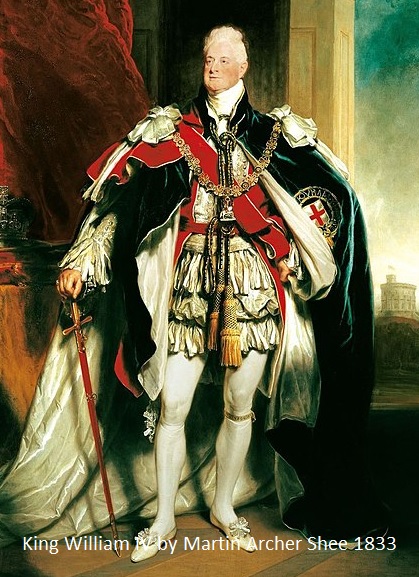
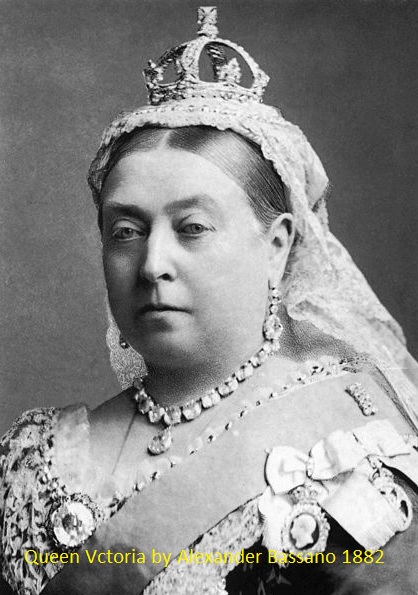
Queen Victoria, born Alexandrina Victoria on 24th May 1819, became Queen on 20th June 1837 after the death of King William IV. Although she had very little interest in horse racing, the Crown continued to own Newmarket Palace for the first 20 years of her reign, but she never resided at, nor visited, the Palace. However, she did continue to support the Royal Plates programme, sponsoring 910 Royal Plates between 1837 and 1854, spread across 45 different racecourses, including the venues of Brighton, Plymouth and Down Royal which were used for the first time, at a cost, in today’s terms, of £11.8 million. For much of her period of ownership of the Palace it was a ‘grace and favour’ building used by the Duke of Rutland, John Henry Manners, although he frequently entertained the Duke of Cambridge. In 1841 the Duke of Cambridge enjoyed a prolonged stay with the Duke of Rutland at Palace III, taking part in a day’s shooting when the distinguished party killed 151 hares, 99 pheasants, 48 rabbits and 8 partridges. On Saturday 29th October 1842 the Duke of Cambridge visited the Duke of Rutland, residing at the Palace and attending both morning and afternoon services at the respective Parish Churches. Later, on the Monday, the Dukes of Cambridge, Rutland and Bedford enjoyed a shooting party, but the same degree of enjoyment was not shared by the 166 pheasants, 178 hares, 54 partridges and 129 rabbits which were shot. On Monday 30th October 1843 the Duke of Cambridge arrived at Newmarket to stay with the Duke of Rutland, while 2 days later they were joined by the Marquis of Granby. In March 1855 the extensive Training Stables associated with the premises known as the Newmarket Palace, was advertised for sale. It comprised stable blocks, three quarters of an acre of land, offices, sundry buildings and a plot of land in the Lower Road previously occupied by the Duke of Bedford and his trainer William Edwards. It meant that what remained of the Palace House Estate on which the main House stood, and the stables across the road from the House, were being separated. The Stables were purchased by Baron Meyer de Rothschild. By 5th October 1855 it was reported that the Duke of Rutland, residing at the Palace, was very ill and his son, Lord John Manners, was at his bedside. When his health deteriorated still further, and he was unable to participate in sports of the field or turf, he moved to be closer to his son with little hope of visiting Newmarket again, at which point the Crown offered the Palace for sale. By 1857 the remainder of the Palace Estate was offered for sale and subsequently purchased by Baron Meyer de Rothschild in 1857, with full details shown below, meaning that, once again, the House and Stables were in the same ownership.
It seems highly likely that by the time Palace III was sold to Baron Meyer de Rothschild in 1857 the Royal furniture, pictures and tapestries had been moved sometime beforehand. On Wednesday 6th September 1854 the Bury and Norwich Post carried an advertisement which announced a sale by Public Auction on Wednesday 20th and Thursday 21st September 1854 of numerous items from the Royal Palace. The instruction to sell without reserve was given by the Duke of Bedford. The sale consisted of Household furniture, 450 ounces of plate, forks and spoons as good as new, outdoor equipment, miscellaneous effects and Ten £5 shares in the Newmarket Gas Company. More specifically, on Wednesday 20th auction lots included numerous stable effects, saddles, bridles, headstalls, saddle horses, corn bins, boy’s bedsteads and bedding. An insight into the workings of a blacksmiths at that time was provided by additional lots on sale, including a Ransome Chaff Engine, Rackham Blower, portable blacksmiths shop, and 29 inch and 42 inch copper furnace irons. The next day all kitchen and copper ware, glass and earthenware, bedroom furniture comprising bedsteads, hangings, blankets, chest of drawers, wardrobes, carpets, dining room and drawing room furniture, chairs, tables and an upright piano were sold. In addition, there was a powerful 15 man power Fire Engine, together with a large quantity of hose and suction which was deemed suitable for a mansion or parish.
The tapestries which had hung in Newmarket Palace since the time of King Charles II were moved from the Palace some years beforehand, although the Royal Archives state that they were moved by 1855. Five particular elaborate tapestries are shown opposite, some of which were moved to Hampton Court, while others were sent to Holyroodhouse to be put on display. In 1861 the Exhibition of Industrial Art opened at the National Gallery and in one of the octagonal rooms on the south side of the gallery the walls were adorned with Flemish tapestries originally in the Newmarket Palace. At this Exhibition there was a further link with Newmarket Palaces I and II, because the central cases in the same octagonal room contained a vast array of jewellery and antiques, one of which was a Gold drinking cup lent by Queen Victoria, but an even more important pair of emblematic pieces were an Episcopal Mace and Sword. While at Newmarket Palace I in 1609 King James I of England, James VI of Scotland, had empowered the citizens of Edinburgh to carry a sword before their Chief Magistrate the Provost which he presented to the magistrates in 1609. It is unlikely the sword was used at this early date, but in 1616 a mace was made and presented to the Lord Provost of Edinburgh in anticipation of a visit by King James to the Scottish capital. However, the two important symbolic items weren’t used before 1627, and it was King Charles I who rectified this. Writing from Newmarket Palace II on 3rd March 1627, King Charles I instructed Sir John Hay to produce the sword, elect a sword carrier from the people of the city, and carry it symbolically before the Lord Provost who, at that time, was David Aikenhead serving the first of his two terms as Lord Provost. On 6th May 1627 a sword-bearer was duly elected, sworn into office, and paid a yearly stipend of 200 Scots pounds payable quarterly.
In 1857 Baron Meyer de Rothschild purchased what remained of Palace III and, prior to him taking up residence, all of the remaining furniture, valuable paintings and tapestries were moved elsewhere. Particular mention can be made of the tapestries which were sent to Hampton Court or Holyroodhouse many years before. Indeed, on 30th September 1733 special mention was made of some tapestries from the Newmarket Palace being moved to Somerset House to adjust their height and to repair them prior to being moved to other Palaces. The sale particulars for the sale of Palace III were advertised in Bell’s Life and the Sporting Chronicle on Sunday 29th March 1857 and provided valuable details of what remained of the Palace Estate. ‘A valuable Freehold Estate belonging to Her Majesty, comprising the premises known as the Newmarket Palace, well-screened from the street, with Offices, carriageway and Garden, held by His Grace the late Duke of Rutland, eligibly situated, fronting the High Street with a frontage of 118 feet and depth of 150 feet, and in the heart of the town. The whole Estate containing a quarter of an acre and 20 perches and well-adapted for the erection of a building of a public character.’
I am grateful for permission to use the images of the tapestries shown below from the Royal Collection Trust / © Her Majesty Queen Elizabeth II 2022
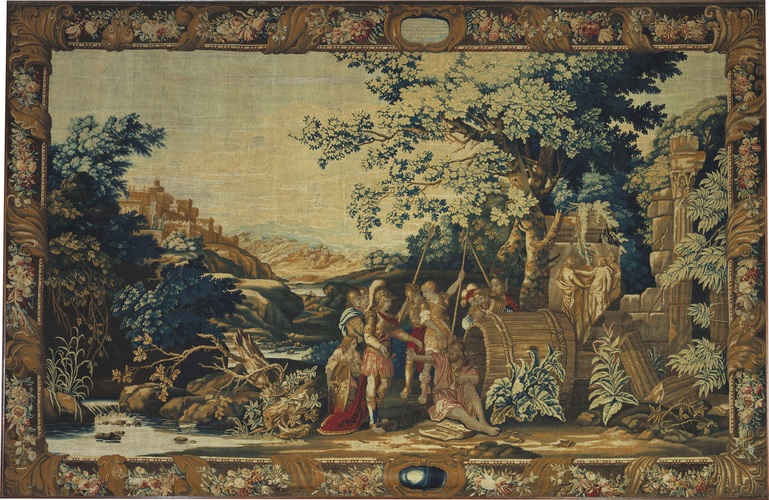
Sale of Furniture and much more in October 1815
In October 1815 a 3-day sale by auction was carried out by Messrs Isaacson of the ‘Superb and Magnificent Household Furniture, and other Valuable Effects’ from sections of His Majesty’s Palace in Newmarket, with the sale being conducted between Monday 23rd to Wednesday 25th October 1815. The auction catalogued was probably a more detailed inventory of what was in the Palace than the one published on 17th February 1783 showing what housekeeper Mrs Bonfoy had available. The auction included:-
Grand Piano Forte
Excellent down and goose featherbeds
Lofty lath and sacken-bottomed bedsteads
Down bolsters and pillows
Wool mattresses in white satin
White satin quilts
Large cotton counterpanes
Fine swans-down blankets with satin borders
Witney blankets with satin borders
Several sets of Venetian festoon window curtains
Handsomely fringed, elegant, rich chintz Curtains
Morine window curtains
Bedroom Wardrobe with sliding shelves and 4 drawers
Mahogany chests of drawers
Mahogany night tables
Pembroke dressing table
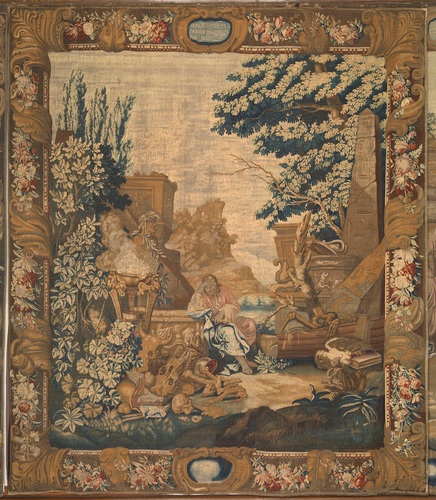
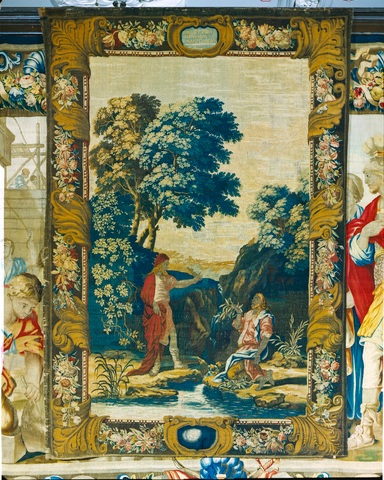
On the second and third days of the Auction, further lots included:-
Two sets of mahogany dining tables
Card Tables
Mahogany framed Sofa with pillows
Two cane seated sofas
Drawing room & Dining Room chairs
Turkey and Brussels carpets
Large quantity of fine tapestry
Historical tapestries
Several capital paintings
Drawings and etchings
Finely executed engravings including 'Newmarket Palace' and 'The Gamekeeper's Favourite'
Store cupboards and shelves
Bath stoves, fenders and fire irons
Kitchen and culinary requisites
Earthenware, paper and Japan tea trays
Washing stands and bidets
Plated candlesticks
Ivory handled knives and forks
Magnificent pier glasses of large dimensions
150 fine greenhouse plants in pots
Multiple flower stands
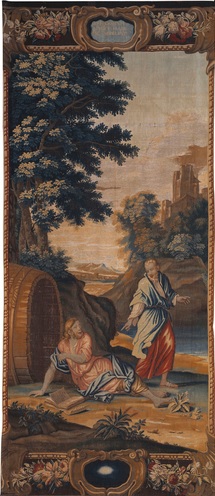
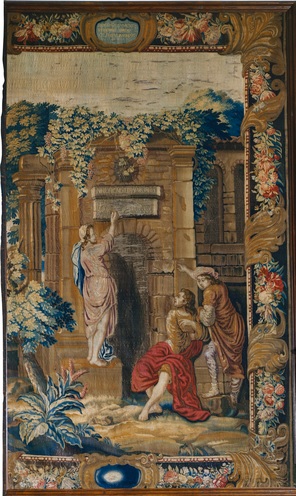
Sale of Building Materials in May 1817
At that sale by Auction on Tuesday 13th and Wednesday 14th May 1817, put up for sale by William Alexander Arnold (Clerk of Works) and conducted by Creaton and Son, Building materials from the Old Palace were sold. The Lots comprised a considerable extent of building materials, much of which still had to be taken down and cleared away by the buyers, after which there was a public sale of the remaining buildings and all of the Ground on which the Palace III Estate stood. The Materials consisted of sound brickwork and plain tiling of oak fitted together in large and small scantlings, roofing floors, wall timbers, floor boards, paving stone with dressings, oak and deal wainscotting, staircases, handsome marble and other chimney pieces, stone coping and window sills. As the buildings were Crown property, there was no Auction Duty to pay.
Sale of Palace III in April 1819
In April 1819 Newmarket Palace, Ice-Well and the adjoining Ground was sold by Auction by Messrs Driver on Tuesday 20th April 1819. It was sold as a very improvable Freehold Estate comprising a valuable and extensive plot of ground in the High Street together with the portion of the Palace still standing. The substantial building, principally fitted with wainscot and oak, was now completely detached and well enclosed, consisting of a suite of rooms and well-appointed apartments together with offices on the basement story. It was thought that it could be readily converted into an excellent family residence for a family of distinction, along with Grounds on Mount Pleasant, and an Ice-Well.
Sale by Auction of Furniture from back apartments of the King's Palace, November 1821
On Monday 19th November 1821 Messrs Isaacson were instructed to auction valuable antique and modern household furniture, China, glass and earthenware comprising a lofty post bedstead with mahogany feet pillars, mahogany dining table and chairs with hair seats, strong kitchen chairs, handsome chamber chairs. 5-leaf 10 feet high screen, a cabinet formerly owned by Queen Anne, china punch bowl, bureau and chest of drawers, valuable 8-day clock with handsome case.
Sale of Furniture, Books and fine Wines at the Palace on Thursday 22nd December 1831
An Auction of valuable Furniture, Choice wines and Books comprising Dining Room, Drawing Room and Library Tables (Full details of the sale are shown in the section on William IV.
Bibliography
The History of Newmarket and the Annals of the Turf Volume I by J P Hore
Progress of King James I Volume 1 by John Nichols
The Changing Face of Newmarket 1600-1760 by Peter May
Illustrations of British History Volume 3 by Lodge
A Dissertation on Horses by William Osmer 1756
Progress of King James I Volume 2 by John Nichols
The History of Newmarket and the Annals of the Turf Volume II by J P Hore
Progress of King James I Volume 3 by John Nichols
The Diary of Samuel Pepys
The History of Newmarket and the Annals of the Turf Volume III by J P Hore
Progress of King James I Volume 4 by John Nichols
The Diary of John Evelyn
British Newspapers Online
British History Online
Newspaper Archives Online